What is the evidence for psychological therapies other than Cognitive Behaviour Therapy in autism and cooccurring disorders?
VerifiedAdded on 2023/01/07
|34
|13725
|76
AI Summary
Contribute Materials
Your contribution can guide someone’s learning journey. Share your
documents today.
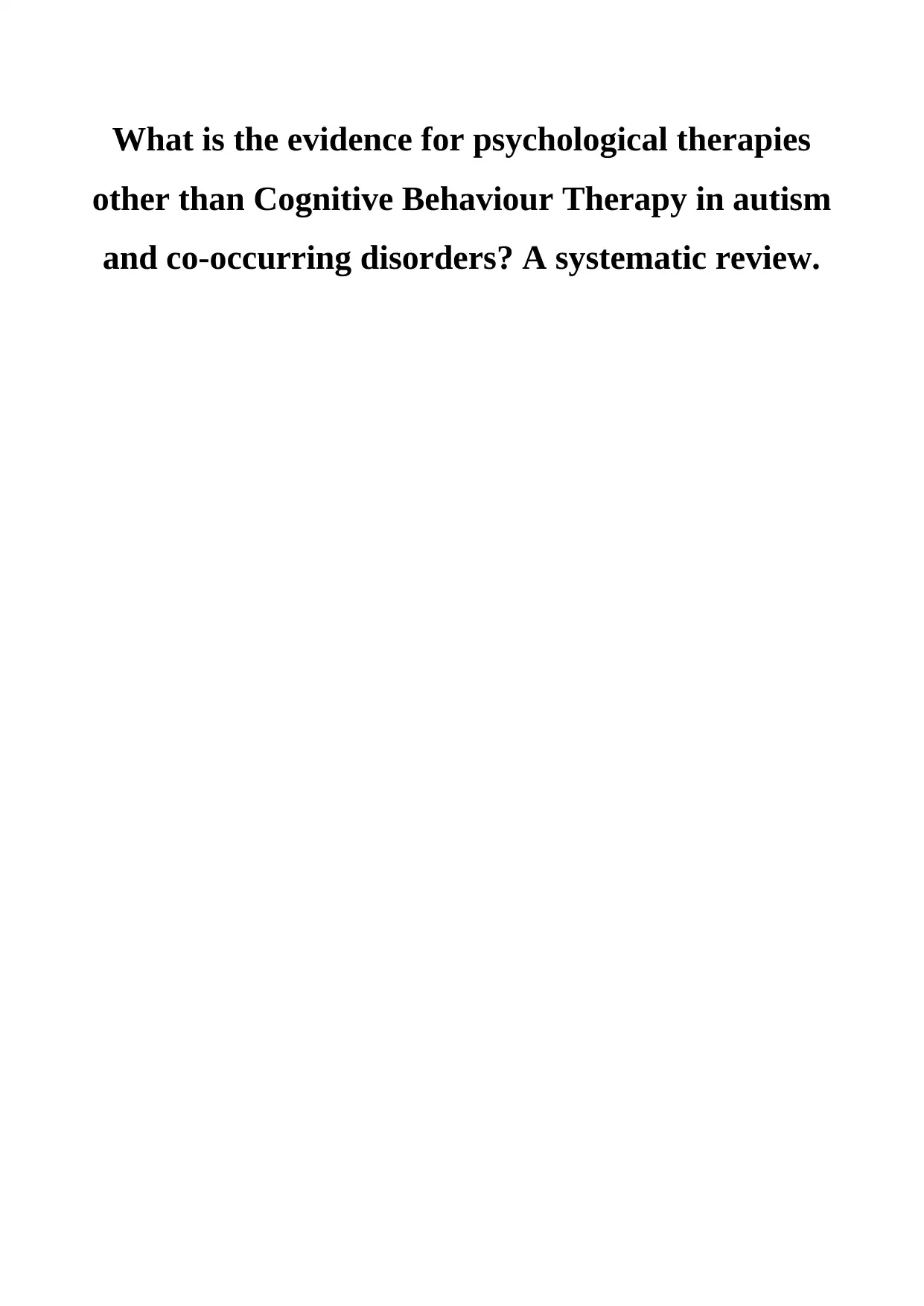
What is the evidence for psychological therapies
other than Cognitive Behaviour Therapy in autism
and co-occurring disorders? A systematic review.
other than Cognitive Behaviour Therapy in autism
and co-occurring disorders? A systematic review.
Secure Best Marks with AI Grader
Need help grading? Try our AI Grader for instant feedback on your assignments.
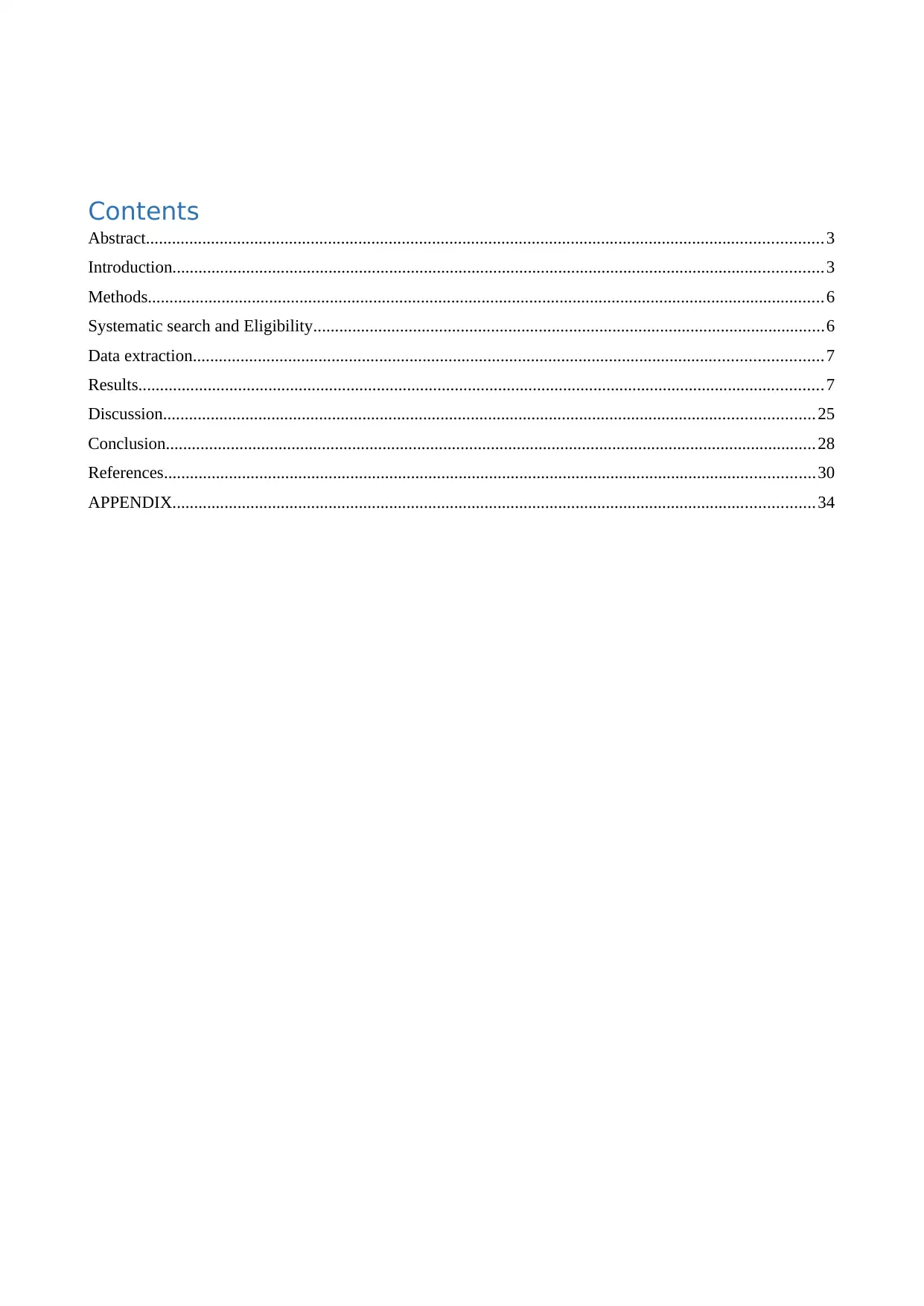
Contents
Abstract............................................................................................................................................................3
Introduction......................................................................................................................................................3
Methods............................................................................................................................................................6
Systematic search and Eligibility......................................................................................................................6
Data extraction.................................................................................................................................................7
Results..............................................................................................................................................................7
Discussion......................................................................................................................................................25
Conclusion......................................................................................................................................................28
References......................................................................................................................................................30
APPENDIX....................................................................................................................................................34
Abstract............................................................................................................................................................3
Introduction......................................................................................................................................................3
Methods............................................................................................................................................................6
Systematic search and Eligibility......................................................................................................................6
Data extraction.................................................................................................................................................7
Results..............................................................................................................................................................7
Discussion......................................................................................................................................................25
Conclusion......................................................................................................................................................28
References......................................................................................................................................................30
APPENDIX....................................................................................................................................................34
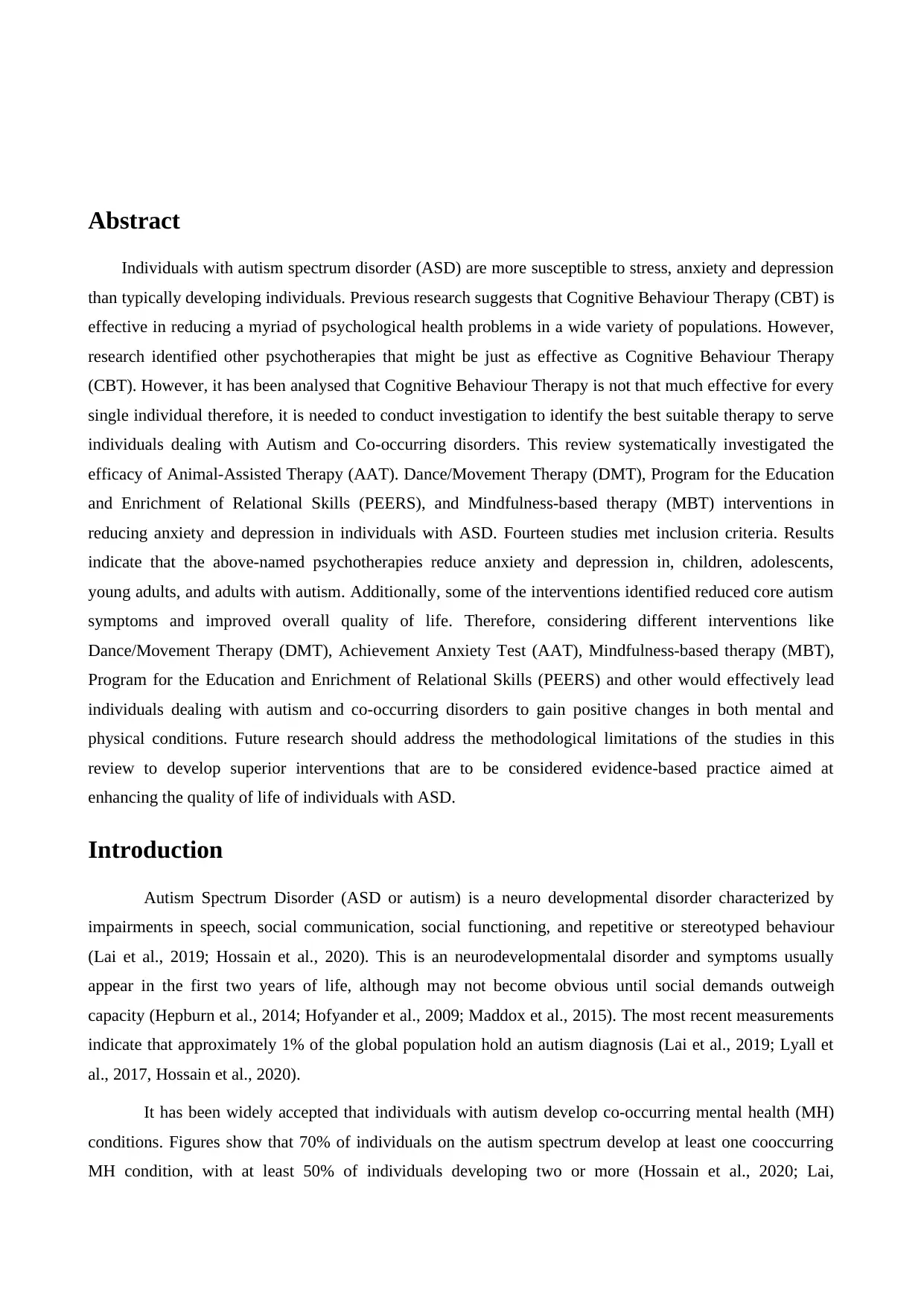
Abstract
Individuals with autism spectrum disorder (ASD) are more susceptible to stress, anxiety and depression
than typically developing individuals. Previous research suggests that Cognitive Behaviour Therapy (CBT) is
effective in reducing a myriad of psychological health problems in a wide variety of populations. However,
research identified other psychotherapies that might be just as effective as Cognitive Behaviour Therapy
(CBT). However, it has been analysed that Cognitive Behaviour Therapy is not that much effective for every
single individual therefore, it is needed to conduct investigation to identify the best suitable therapy to serve
individuals dealing with Autism and Co-occurring disorders. This review systematically investigated the
efficacy of Animal-Assisted Therapy (AAT). Dance/Movement Therapy (DMT), Program for the Education
and Enrichment of Relational Skills (PEERS), and Mindfulness-based therapy (MBT) interventions in
reducing anxiety and depression in individuals with ASD. Fourteen studies met inclusion criteria. Results
indicate that the above-named psychotherapies reduce anxiety and depression in, children, adolescents,
young adults, and adults with autism. Additionally, some of the interventions identified reduced core autism
symptoms and improved overall quality of life. Therefore, considering different interventions like
Dance/Movement Therapy (DMT), Achievement Anxiety Test (AAT), Mindfulness-based therapy (MBT),
Program for the Education and Enrichment of Relational Skills (PEERS) and other would effectively lead
individuals dealing with autism and co-occurring disorders to gain positive changes in both mental and
physical conditions. Future research should address the methodological limitations of the studies in this
review to develop superior interventions that are to be considered evidence-based practice aimed at
enhancing the quality of life of individuals with ASD.
Introduction
Autism Spectrum Disorder (ASD or autism) is a neuro developmental disorder characterized by
impairments in speech, social communication, social functioning, and repetitive or stereotyped behaviour
(Lai et al., 2019; Hossain et al., 2020). This is an neurodevelopmentalal disorder and symptoms usually
appear in the first two years of life, although may not become obvious until social demands outweigh
capacity (Hepburn et al., 2014; Hofyander et al., 2009; Maddox et al., 2015). The most recent measurements
indicate that approximately 1% of the global population hold an autism diagnosis (Lai et al., 2019; Lyall et
al., 2017, Hossain et al., 2020).
It has been widely accepted that individuals with autism develop co-occurring mental health (MH)
conditions. Figures show that 70% of individuals on the autism spectrum develop at least one cooccurring
MH condition, with at least 50% of individuals developing two or more (Hossain et al., 2020; Lai,
Individuals with autism spectrum disorder (ASD) are more susceptible to stress, anxiety and depression
than typically developing individuals. Previous research suggests that Cognitive Behaviour Therapy (CBT) is
effective in reducing a myriad of psychological health problems in a wide variety of populations. However,
research identified other psychotherapies that might be just as effective as Cognitive Behaviour Therapy
(CBT). However, it has been analysed that Cognitive Behaviour Therapy is not that much effective for every
single individual therefore, it is needed to conduct investigation to identify the best suitable therapy to serve
individuals dealing with Autism and Co-occurring disorders. This review systematically investigated the
efficacy of Animal-Assisted Therapy (AAT). Dance/Movement Therapy (DMT), Program for the Education
and Enrichment of Relational Skills (PEERS), and Mindfulness-based therapy (MBT) interventions in
reducing anxiety and depression in individuals with ASD. Fourteen studies met inclusion criteria. Results
indicate that the above-named psychotherapies reduce anxiety and depression in, children, adolescents,
young adults, and adults with autism. Additionally, some of the interventions identified reduced core autism
symptoms and improved overall quality of life. Therefore, considering different interventions like
Dance/Movement Therapy (DMT), Achievement Anxiety Test (AAT), Mindfulness-based therapy (MBT),
Program for the Education and Enrichment of Relational Skills (PEERS) and other would effectively lead
individuals dealing with autism and co-occurring disorders to gain positive changes in both mental and
physical conditions. Future research should address the methodological limitations of the studies in this
review to develop superior interventions that are to be considered evidence-based practice aimed at
enhancing the quality of life of individuals with ASD.
Introduction
Autism Spectrum Disorder (ASD or autism) is a neuro developmental disorder characterized by
impairments in speech, social communication, social functioning, and repetitive or stereotyped behaviour
(Lai et al., 2019; Hossain et al., 2020). This is an neurodevelopmentalal disorder and symptoms usually
appear in the first two years of life, although may not become obvious until social demands outweigh
capacity (Hepburn et al., 2014; Hofyander et al., 2009; Maddox et al., 2015). The most recent measurements
indicate that approximately 1% of the global population hold an autism diagnosis (Lai et al., 2019; Lyall et
al., 2017, Hossain et al., 2020).
It has been widely accepted that individuals with autism develop co-occurring mental health (MH)
conditions. Figures show that 70% of individuals on the autism spectrum develop at least one cooccurring
MH condition, with at least 50% of individuals developing two or more (Hossain et al., 2020; Lai,
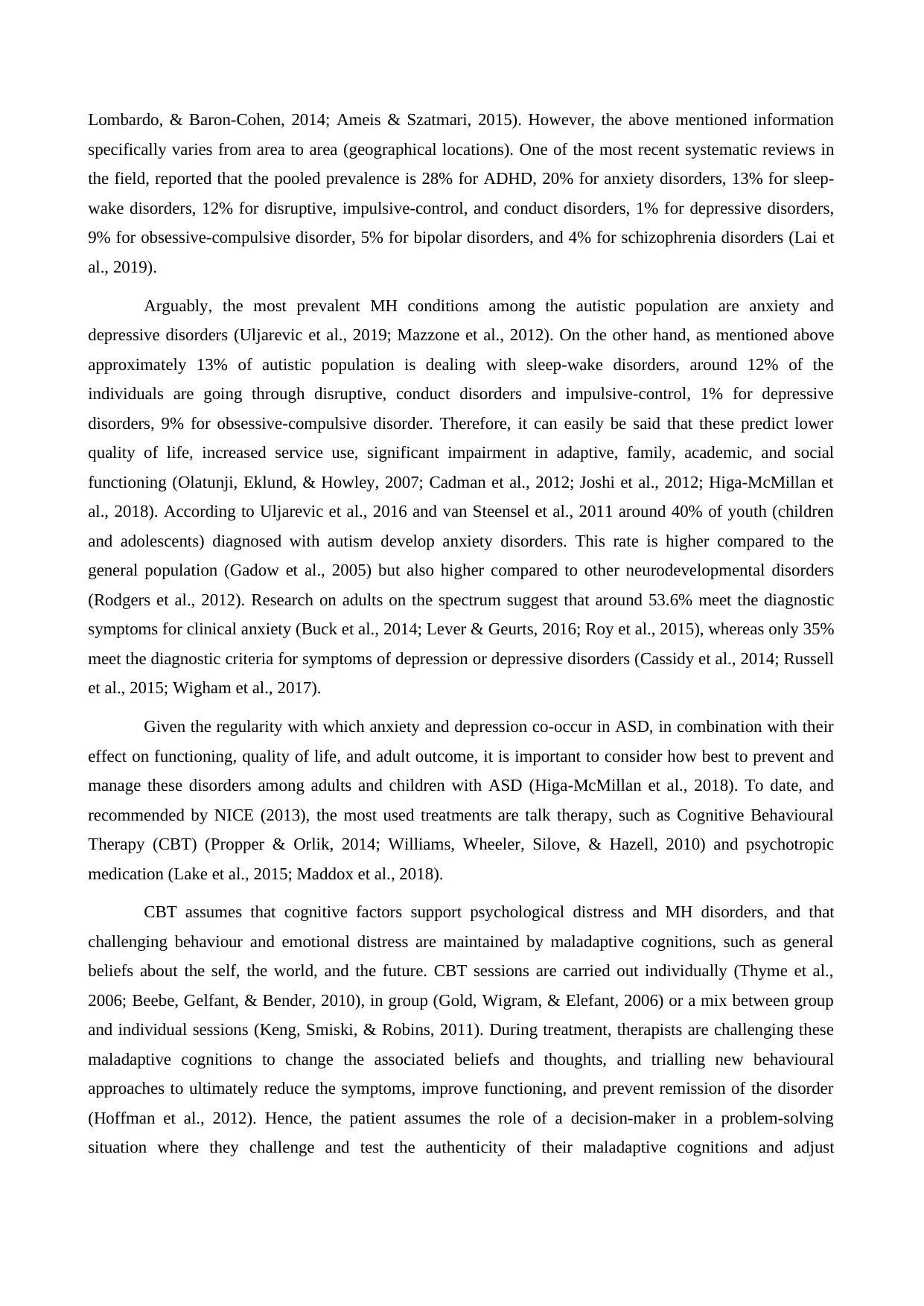
Lombardo, & Baron-Cohen, 2014; Ameis & Szatmari, 2015). However, the above mentioned information
specifically varies from area to area (geographical locations). One of the most recent systematic reviews in
the field, reported that the pooled prevalence is 28% for ADHD, 20% for anxiety disorders, 13% for sleep-
wake disorders, 12% for disruptive, impulsive-control, and conduct disorders, 1% for depressive disorders,
9% for obsessive-compulsive disorder, 5% for bipolar disorders, and 4% for schizophrenia disorders (Lai et
al., 2019).
Arguably, the most prevalent MH conditions among the autistic population are anxiety and
depressive disorders (Uljarevic et al., 2019; Mazzone et al., 2012). On the other hand, as mentioned above
approximately 13% of autistic population is dealing with sleep-wake disorders, around 12% of the
individuals are going through disruptive, conduct disorders and impulsive-control, 1% for depressive
disorders, 9% for obsessive-compulsive disorder. Therefore, it can easily be said that these predict lower
quality of life, increased service use, significant impairment in adaptive, family, academic, and social
functioning (Olatunji, Eklund, & Howley, 2007; Cadman et al., 2012; Joshi et al., 2012; Higa-McMillan et
al., 2018). According to Uljarevic et al., 2016 and van Steensel et al., 2011 around 40% of youth (children
and adolescents) diagnosed with autism develop anxiety disorders. This rate is higher compared to the
general population (Gadow et al., 2005) but also higher compared to other neurodevelopmental disorders
(Rodgers et al., 2012). Research on adults on the spectrum suggest that around 53.6% meet the diagnostic
symptoms for clinical anxiety (Buck et al., 2014; Lever & Geurts, 2016; Roy et al., 2015), whereas only 35%
meet the diagnostic criteria for symptoms of depression or depressive disorders (Cassidy et al., 2014; Russell
et al., 2015; Wigham et al., 2017).
Given the regularity with which anxiety and depression co-occur in ASD, in combination with their
effect on functioning, quality of life, and adult outcome, it is important to consider how best to prevent and
manage these disorders among adults and children with ASD (Higa-McMillan et al., 2018). To date, and
recommended by NICE (2013), the most used treatments are talk therapy, such as Cognitive Behavioural
Therapy (CBT) (Propper & Orlik, 2014; Williams, Wheeler, Silove, & Hazell, 2010) and psychotropic
medication (Lake et al., 2015; Maddox et al., 2018).
CBT assumes that cognitive factors support psychological distress and MH disorders, and that
challenging behaviour and emotional distress are maintained by maladaptive cognitions, such as general
beliefs about the self, the world, and the future. CBT sessions are carried out individually (Thyme et al.,
2006; Beebe, Gelfant, & Bender, 2010), in group (Gold, Wigram, & Elefant, 2006) or a mix between group
and individual sessions (Keng, Smiski, & Robins, 2011). During treatment, therapists are challenging these
maladaptive cognitions to change the associated beliefs and thoughts, and trialling new behavioural
approaches to ultimately reduce the symptoms, improve functioning, and prevent remission of the disorder
(Hoffman et al., 2012). Hence, the patient assumes the role of a decision-maker in a problem-solving
situation where they challenge and test the authenticity of their maladaptive cognitions and adjust
specifically varies from area to area (geographical locations). One of the most recent systematic reviews in
the field, reported that the pooled prevalence is 28% for ADHD, 20% for anxiety disorders, 13% for sleep-
wake disorders, 12% for disruptive, impulsive-control, and conduct disorders, 1% for depressive disorders,
9% for obsessive-compulsive disorder, 5% for bipolar disorders, and 4% for schizophrenia disorders (Lai et
al., 2019).
Arguably, the most prevalent MH conditions among the autistic population are anxiety and
depressive disorders (Uljarevic et al., 2019; Mazzone et al., 2012). On the other hand, as mentioned above
approximately 13% of autistic population is dealing with sleep-wake disorders, around 12% of the
individuals are going through disruptive, conduct disorders and impulsive-control, 1% for depressive
disorders, 9% for obsessive-compulsive disorder. Therefore, it can easily be said that these predict lower
quality of life, increased service use, significant impairment in adaptive, family, academic, and social
functioning (Olatunji, Eklund, & Howley, 2007; Cadman et al., 2012; Joshi et al., 2012; Higa-McMillan et
al., 2018). According to Uljarevic et al., 2016 and van Steensel et al., 2011 around 40% of youth (children
and adolescents) diagnosed with autism develop anxiety disorders. This rate is higher compared to the
general population (Gadow et al., 2005) but also higher compared to other neurodevelopmental disorders
(Rodgers et al., 2012). Research on adults on the spectrum suggest that around 53.6% meet the diagnostic
symptoms for clinical anxiety (Buck et al., 2014; Lever & Geurts, 2016; Roy et al., 2015), whereas only 35%
meet the diagnostic criteria for symptoms of depression or depressive disorders (Cassidy et al., 2014; Russell
et al., 2015; Wigham et al., 2017).
Given the regularity with which anxiety and depression co-occur in ASD, in combination with their
effect on functioning, quality of life, and adult outcome, it is important to consider how best to prevent and
manage these disorders among adults and children with ASD (Higa-McMillan et al., 2018). To date, and
recommended by NICE (2013), the most used treatments are talk therapy, such as Cognitive Behavioural
Therapy (CBT) (Propper & Orlik, 2014; Williams, Wheeler, Silove, & Hazell, 2010) and psychotropic
medication (Lake et al., 2015; Maddox et al., 2018).
CBT assumes that cognitive factors support psychological distress and MH disorders, and that
challenging behaviour and emotional distress are maintained by maladaptive cognitions, such as general
beliefs about the self, the world, and the future. CBT sessions are carried out individually (Thyme et al.,
2006; Beebe, Gelfant, & Bender, 2010), in group (Gold, Wigram, & Elefant, 2006) or a mix between group
and individual sessions (Keng, Smiski, & Robins, 2011). During treatment, therapists are challenging these
maladaptive cognitions to change the associated beliefs and thoughts, and trialling new behavioural
approaches to ultimately reduce the symptoms, improve functioning, and prevent remission of the disorder
(Hoffman et al., 2012). Hence, the patient assumes the role of a decision-maker in a problem-solving
situation where they challenge and test the authenticity of their maladaptive cognitions and adjust
Secure Best Marks with AI Grader
Need help grading? Try our AI Grader for instant feedback on your assignments.
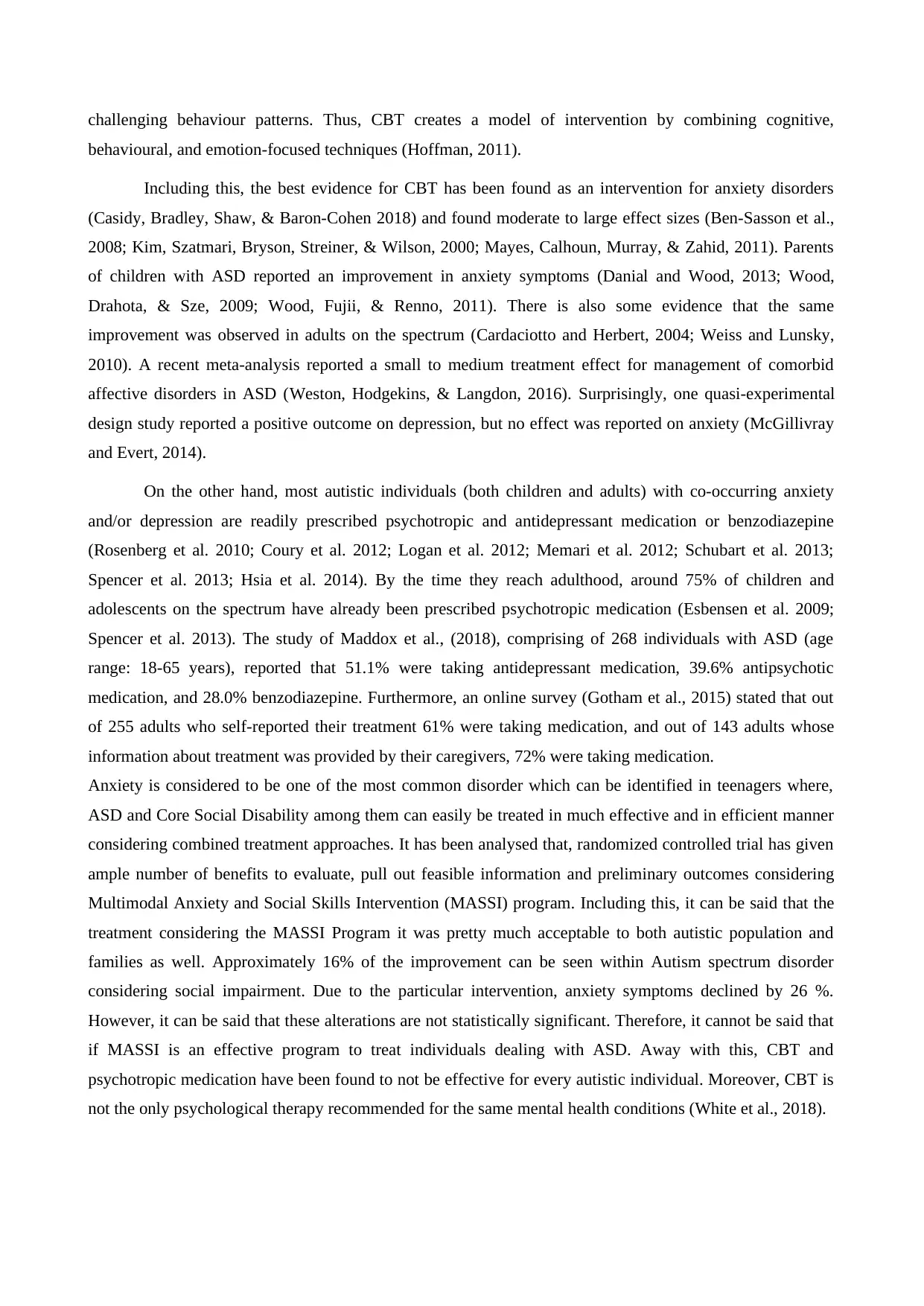
challenging behaviour patterns. Thus, CBT creates a model of intervention by combining cognitive,
behavioural, and emotion-focused techniques (Hoffman, 2011).
Including this, the best evidence for CBT has been found as an intervention for anxiety disorders
(Casidy, Bradley, Shaw, & Baron-Cohen 2018) and found moderate to large effect sizes (Ben-Sasson et al.,
2008; Kim, Szatmari, Bryson, Streiner, & Wilson, 2000; Mayes, Calhoun, Murray, & Zahid, 2011). Parents
of children with ASD reported an improvement in anxiety symptoms (Danial and Wood, 2013; Wood,
Drahota, & Sze, 2009; Wood, Fujii, & Renno, 2011). There is also some evidence that the same
improvement was observed in adults on the spectrum (Cardaciotto and Herbert, 2004; Weiss and Lunsky,
2010). A recent meta-analysis reported a small to medium treatment effect for management of comorbid
affective disorders in ASD (Weston, Hodgekins, & Langdon, 2016). Surprisingly, one quasi-experimental
design study reported a positive outcome on depression, but no effect was reported on anxiety (McGillivray
and Evert, 2014).
On the other hand, most autistic individuals (both children and adults) with co-occurring anxiety
and/or depression are readily prescribed psychotropic and antidepressant medication or benzodiazepine
(Rosenberg et al. 2010; Coury et al. 2012; Logan et al. 2012; Memari et al. 2012; Schubart et al. 2013;
Spencer et al. 2013; Hsia et al. 2014). By the time they reach adulthood, around 75% of children and
adolescents on the spectrum have already been prescribed psychotropic medication (Esbensen et al. 2009;
Spencer et al. 2013). The study of Maddox et al., (2018), comprising of 268 individuals with ASD (age
range: 18-65 years), reported that 51.1% were taking antidepressant medication, 39.6% antipsychotic
medication, and 28.0% benzodiazepine. Furthermore, an online survey (Gotham et al., 2015) stated that out
of 255 adults who self-reported their treatment 61% were taking medication, and out of 143 adults whose
information about treatment was provided by their caregivers, 72% were taking medication.
Anxiety is considered to be one of the most common disorder which can be identified in teenagers where,
ASD and Core Social Disability among them can easily be treated in much effective and in efficient manner
considering combined treatment approaches. It has been analysed that, randomized controlled trial has given
ample number of benefits to evaluate, pull out feasible information and preliminary outcomes considering
Multimodal Anxiety and Social Skills Intervention (MASSI) program. Including this, it can be said that the
treatment considering the MASSI Program it was pretty much acceptable to both autistic population and
families as well. Approximately 16% of the improvement can be seen within Autism spectrum disorder
considering social impairment. Due to the particular intervention, anxiety symptoms declined by 26 %.
However, it can be said that these alterations are not statistically significant. Therefore, it cannot be said that
if MASSI is an effective program to treat individuals dealing with ASD. Away with this, CBT and
psychotropic medication have been found to not be effective for every autistic individual. Moreover, CBT is
not the only psychological therapy recommended for the same mental health conditions (White et al., 2018).
behavioural, and emotion-focused techniques (Hoffman, 2011).
Including this, the best evidence for CBT has been found as an intervention for anxiety disorders
(Casidy, Bradley, Shaw, & Baron-Cohen 2018) and found moderate to large effect sizes (Ben-Sasson et al.,
2008; Kim, Szatmari, Bryson, Streiner, & Wilson, 2000; Mayes, Calhoun, Murray, & Zahid, 2011). Parents
of children with ASD reported an improvement in anxiety symptoms (Danial and Wood, 2013; Wood,
Drahota, & Sze, 2009; Wood, Fujii, & Renno, 2011). There is also some evidence that the same
improvement was observed in adults on the spectrum (Cardaciotto and Herbert, 2004; Weiss and Lunsky,
2010). A recent meta-analysis reported a small to medium treatment effect for management of comorbid
affective disorders in ASD (Weston, Hodgekins, & Langdon, 2016). Surprisingly, one quasi-experimental
design study reported a positive outcome on depression, but no effect was reported on anxiety (McGillivray
and Evert, 2014).
On the other hand, most autistic individuals (both children and adults) with co-occurring anxiety
and/or depression are readily prescribed psychotropic and antidepressant medication or benzodiazepine
(Rosenberg et al. 2010; Coury et al. 2012; Logan et al. 2012; Memari et al. 2012; Schubart et al. 2013;
Spencer et al. 2013; Hsia et al. 2014). By the time they reach adulthood, around 75% of children and
adolescents on the spectrum have already been prescribed psychotropic medication (Esbensen et al. 2009;
Spencer et al. 2013). The study of Maddox et al., (2018), comprising of 268 individuals with ASD (age
range: 18-65 years), reported that 51.1% were taking antidepressant medication, 39.6% antipsychotic
medication, and 28.0% benzodiazepine. Furthermore, an online survey (Gotham et al., 2015) stated that out
of 255 adults who self-reported their treatment 61% were taking medication, and out of 143 adults whose
information about treatment was provided by their caregivers, 72% were taking medication.
Anxiety is considered to be one of the most common disorder which can be identified in teenagers where,
ASD and Core Social Disability among them can easily be treated in much effective and in efficient manner
considering combined treatment approaches. It has been analysed that, randomized controlled trial has given
ample number of benefits to evaluate, pull out feasible information and preliminary outcomes considering
Multimodal Anxiety and Social Skills Intervention (MASSI) program. Including this, it can be said that the
treatment considering the MASSI Program it was pretty much acceptable to both autistic population and
families as well. Approximately 16% of the improvement can be seen within Autism spectrum disorder
considering social impairment. Due to the particular intervention, anxiety symptoms declined by 26 %.
However, it can be said that these alterations are not statistically significant. Therefore, it cannot be said that
if MASSI is an effective program to treat individuals dealing with ASD. Away with this, CBT and
psychotropic medication have been found to not be effective for every autistic individual. Moreover, CBT is
not the only psychological therapy recommended for the same mental health conditions (White et al., 2018).
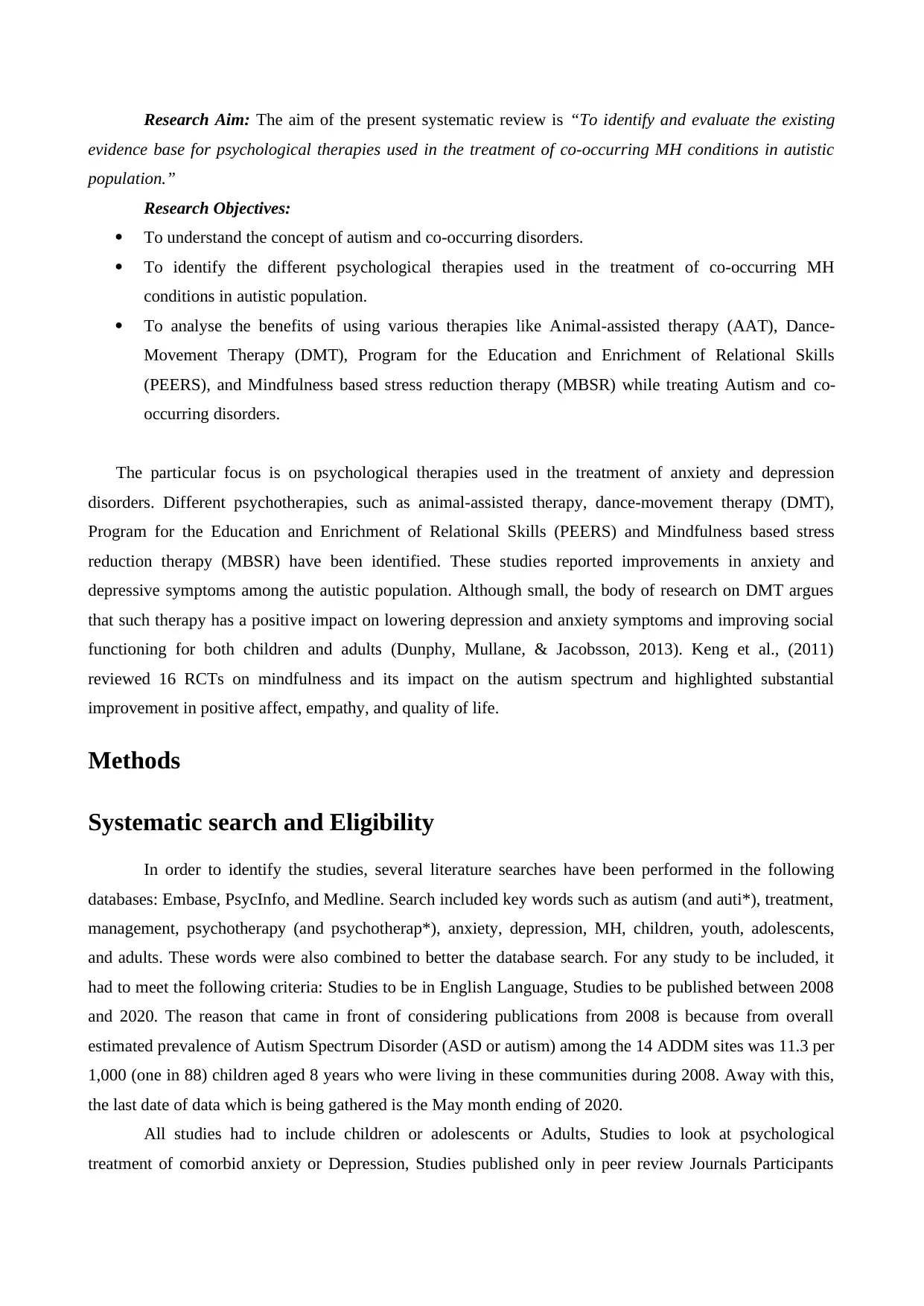
Research Aim: The aim of the present systematic review is “To identify and evaluate the existing
evidence base for psychological therapies used in the treatment of co-occurring MH conditions in autistic
population.”
Research Objectives:
To understand the concept of autism and co-occurring disorders.
To identify the different psychological therapies used in the treatment of co-occurring MH
conditions in autistic population.
To analyse the benefits of using various therapies like Animal-assisted therapy (AAT), Dance-
Movement Therapy (DMT), Program for the Education and Enrichment of Relational Skills
(PEERS), and Mindfulness based stress reduction therapy (MBSR) while treating Autism and co-
occurring disorders.
The particular focus is on psychological therapies used in the treatment of anxiety and depression
disorders. Different psychotherapies, such as animal-assisted therapy, dance-movement therapy (DMT),
Program for the Education and Enrichment of Relational Skills (PEERS) and Mindfulness based stress
reduction therapy (MBSR) have been identified. These studies reported improvements in anxiety and
depressive symptoms among the autistic population. Although small, the body of research on DMT argues
that such therapy has a positive impact on lowering depression and anxiety symptoms and improving social
functioning for both children and adults (Dunphy, Mullane, & Jacobsson, 2013). Keng et al., (2011)
reviewed 16 RCTs on mindfulness and its impact on the autism spectrum and highlighted substantial
improvement in positive affect, empathy, and quality of life.
Methods
Systematic search and Eligibility
In order to identify the studies, several literature searches have been performed in the following
databases: Embase, PsycInfo, and Medline. Search included key words such as autism (and auti*), treatment,
management, psychotherapy (and psychotherap*), anxiety, depression, MH, children, youth, adolescents,
and adults. These words were also combined to better the database search. For any study to be included, it
had to meet the following criteria: Studies to be in English Language, Studies to be published between 2008
and 2020. The reason that came in front of considering publications from 2008 is because from overall
estimated prevalence of Autism Spectrum Disorder (ASD or autism) among the 14 ADDM sites was 11.3 per
1,000 (one in 88) children aged 8 years who were living in these communities during 2008. Away with this,
the last date of data which is being gathered is the May month ending of 2020.
All studies had to include children or adolescents or Adults, Studies to look at psychological
treatment of comorbid anxiety or Depression, Studies published only in peer review Journals Participants
evidence base for psychological therapies used in the treatment of co-occurring MH conditions in autistic
population.”
Research Objectives:
To understand the concept of autism and co-occurring disorders.
To identify the different psychological therapies used in the treatment of co-occurring MH
conditions in autistic population.
To analyse the benefits of using various therapies like Animal-assisted therapy (AAT), Dance-
Movement Therapy (DMT), Program for the Education and Enrichment of Relational Skills
(PEERS), and Mindfulness based stress reduction therapy (MBSR) while treating Autism and co-
occurring disorders.
The particular focus is on psychological therapies used in the treatment of anxiety and depression
disorders. Different psychotherapies, such as animal-assisted therapy, dance-movement therapy (DMT),
Program for the Education and Enrichment of Relational Skills (PEERS) and Mindfulness based stress
reduction therapy (MBSR) have been identified. These studies reported improvements in anxiety and
depressive symptoms among the autistic population. Although small, the body of research on DMT argues
that such therapy has a positive impact on lowering depression and anxiety symptoms and improving social
functioning for both children and adults (Dunphy, Mullane, & Jacobsson, 2013). Keng et al., (2011)
reviewed 16 RCTs on mindfulness and its impact on the autism spectrum and highlighted substantial
improvement in positive affect, empathy, and quality of life.
Methods
Systematic search and Eligibility
In order to identify the studies, several literature searches have been performed in the following
databases: Embase, PsycInfo, and Medline. Search included key words such as autism (and auti*), treatment,
management, psychotherapy (and psychotherap*), anxiety, depression, MH, children, youth, adolescents,
and adults. These words were also combined to better the database search. For any study to be included, it
had to meet the following criteria: Studies to be in English Language, Studies to be published between 2008
and 2020. The reason that came in front of considering publications from 2008 is because from overall
estimated prevalence of Autism Spectrum Disorder (ASD or autism) among the 14 ADDM sites was 11.3 per
1,000 (one in 88) children aged 8 years who were living in these communities during 2008. Away with this,
the last date of data which is being gathered is the May month ending of 2020.
All studies had to include children or adolescents or Adults, Studies to look at psychological
treatment of comorbid anxiety or Depression, Studies published only in peer review Journals Participants
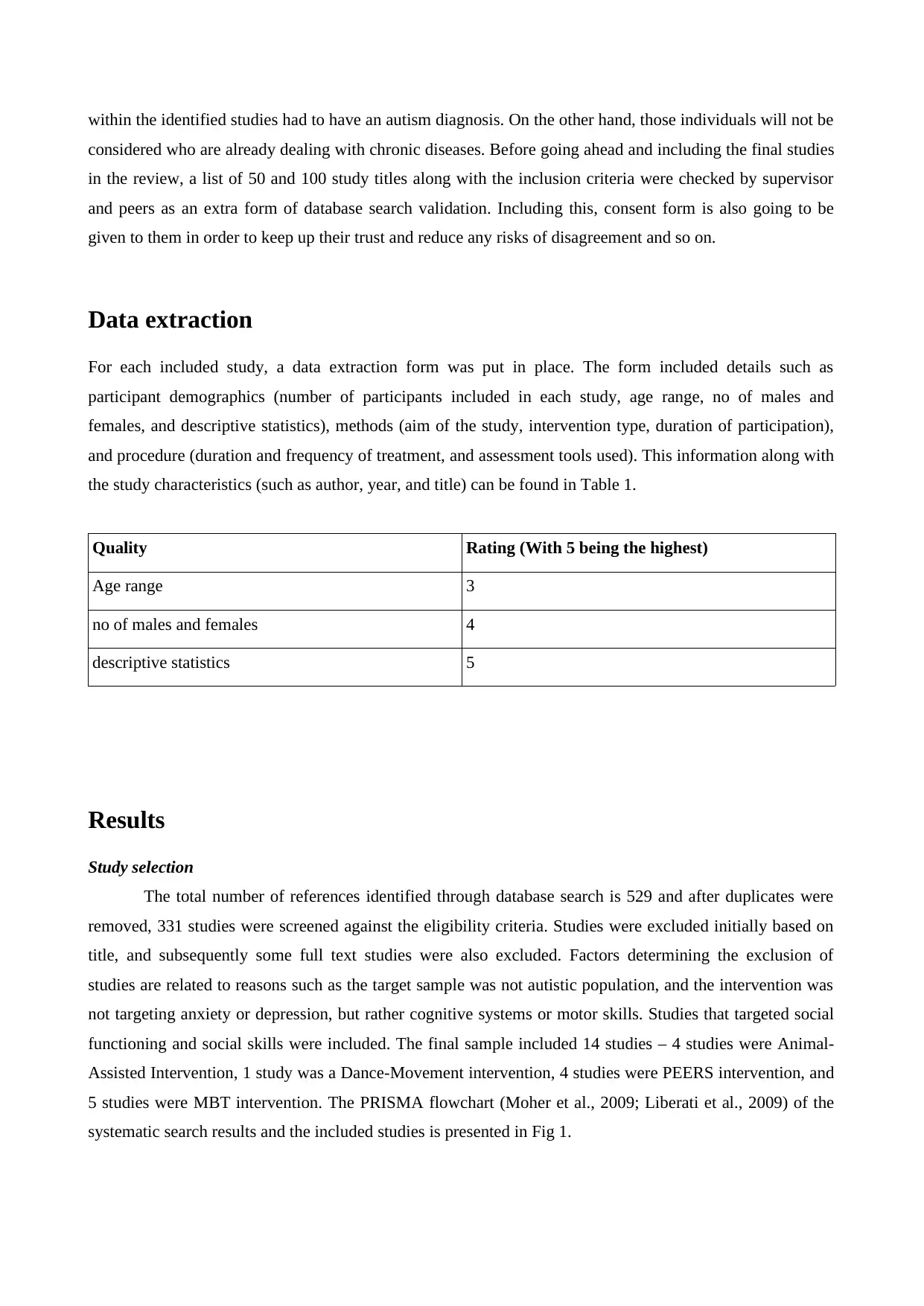
within the identified studies had to have an autism diagnosis. On the other hand, those individuals will not be
considered who are already dealing with chronic diseases. Before going ahead and including the final studies
in the review, a list of 50 and 100 study titles along with the inclusion criteria were checked by supervisor
and peers as an extra form of database search validation. Including this, consent form is also going to be
given to them in order to keep up their trust and reduce any risks of disagreement and so on.
Data extraction
For each included study, a data extraction form was put in place. The form included details such as
participant demographics (number of participants included in each study, age range, no of males and
females, and descriptive statistics), methods (aim of the study, intervention type, duration of participation),
and procedure (duration and frequency of treatment, and assessment tools used). This information along with
the study characteristics (such as author, year, and title) can be found in Table 1.
Quality Rating (With 5 being the highest)
Age range 3
no of males and females 4
descriptive statistics 5
Results
Study selection
The total number of references identified through database search is 529 and after duplicates were
removed, 331 studies were screened against the eligibility criteria. Studies were excluded initially based on
title, and subsequently some full text studies were also excluded. Factors determining the exclusion of
studies are related to reasons such as the target sample was not autistic population, and the intervention was
not targeting anxiety or depression, but rather cognitive systems or motor skills. Studies that targeted social
functioning and social skills were included. The final sample included 14 studies – 4 studies were Animal-
Assisted Intervention, 1 study was a Dance-Movement intervention, 4 studies were PEERS intervention, and
5 studies were MBT intervention. The PRISMA flowchart (Moher et al., 2009; Liberati et al., 2009) of the
systematic search results and the included studies is presented in Fig 1.
considered who are already dealing with chronic diseases. Before going ahead and including the final studies
in the review, a list of 50 and 100 study titles along with the inclusion criteria were checked by supervisor
and peers as an extra form of database search validation. Including this, consent form is also going to be
given to them in order to keep up their trust and reduce any risks of disagreement and so on.
Data extraction
For each included study, a data extraction form was put in place. The form included details such as
participant demographics (number of participants included in each study, age range, no of males and
females, and descriptive statistics), methods (aim of the study, intervention type, duration of participation),
and procedure (duration and frequency of treatment, and assessment tools used). This information along with
the study characteristics (such as author, year, and title) can be found in Table 1.
Quality Rating (With 5 being the highest)
Age range 3
no of males and females 4
descriptive statistics 5
Results
Study selection
The total number of references identified through database search is 529 and after duplicates were
removed, 331 studies were screened against the eligibility criteria. Studies were excluded initially based on
title, and subsequently some full text studies were also excluded. Factors determining the exclusion of
studies are related to reasons such as the target sample was not autistic population, and the intervention was
not targeting anxiety or depression, but rather cognitive systems or motor skills. Studies that targeted social
functioning and social skills were included. The final sample included 14 studies – 4 studies were Animal-
Assisted Intervention, 1 study was a Dance-Movement intervention, 4 studies were PEERS intervention, and
5 studies were MBT intervention. The PRISMA flowchart (Moher et al., 2009; Liberati et al., 2009) of the
systematic search results and the included studies is presented in Fig 1.
Paraphrase This Document
Need a fresh take? Get an instant paraphrase of this document with our AI Paraphraser
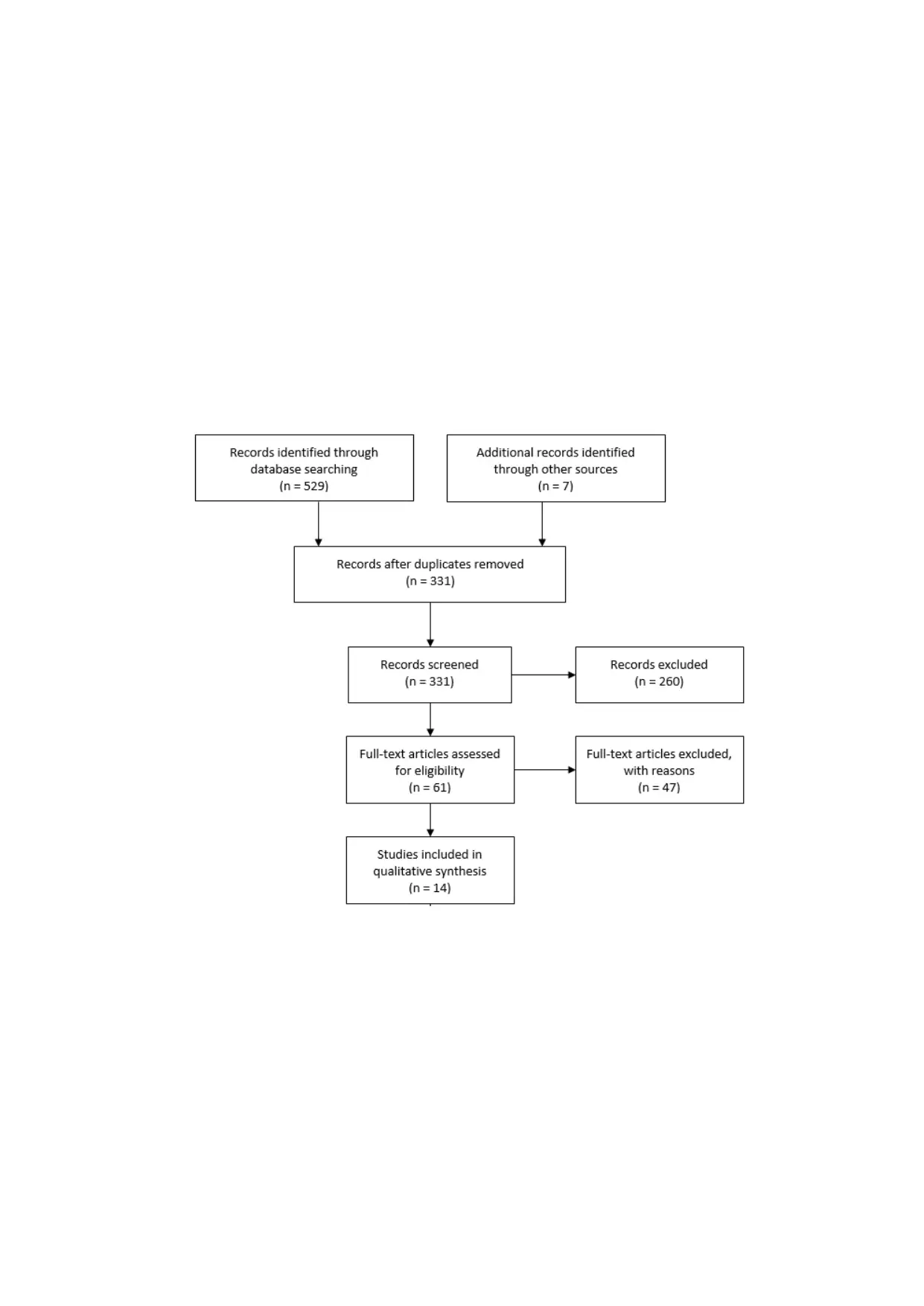
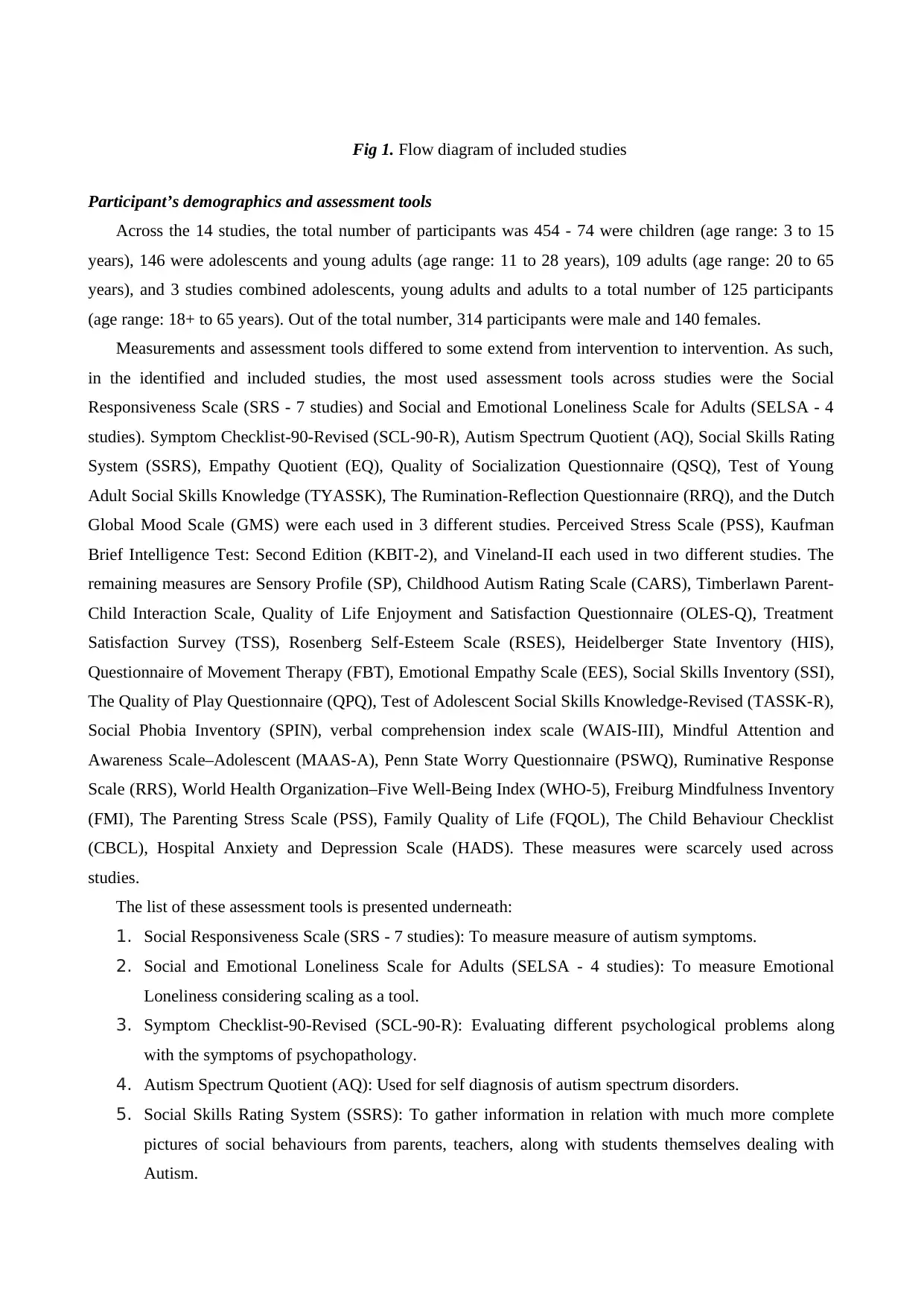
Fig 1. Flow diagram of included studies
Participant’s demographics and assessment tools
Across the 14 studies, the total number of participants was 454 - 74 were children (age range: 3 to 15
years), 146 were adolescents and young adults (age range: 11 to 28 years), 109 adults (age range: 20 to 65
years), and 3 studies combined adolescents, young adults and adults to a total number of 125 participants
(age range: 18+ to 65 years). Out of the total number, 314 participants were male and 140 females.
Measurements and assessment tools differed to some extend from intervention to intervention. As such,
in the identified and included studies, the most used assessment tools across studies were the Social
Responsiveness Scale (SRS - 7 studies) and Social and Emotional Loneliness Scale for Adults (SELSA - 4
studies). Symptom Checklist-90-Revised (SCL-90-R), Autism Spectrum Quotient (AQ), Social Skills Rating
System (SSRS), Empathy Quotient (EQ), Quality of Socialization Questionnaire (QSQ), Test of Young
Adult Social Skills Knowledge (TYASSK), The Rumination-Reflection Questionnaire (RRQ), and the Dutch
Global Mood Scale (GMS) were each used in 3 different studies. Perceived Stress Scale (PSS), Kaufman
Brief Intelligence Test: Second Edition (KBIT-2), and Vineland-II each used in two different studies. The
remaining measures are Sensory Profile (SP), Childhood Autism Rating Scale (CARS), Timberlawn Parent-
Child Interaction Scale, Quality of Life Enjoyment and Satisfaction Questionnaire (OLES-Q), Treatment
Satisfaction Survey (TSS), Rosenberg Self-Esteem Scale (RSES), Heidelberger State Inventory (HIS),
Questionnaire of Movement Therapy (FBT), Emotional Empathy Scale (EES), Social Skills Inventory (SSI),
The Quality of Play Questionnaire (QPQ), Test of Adolescent Social Skills Knowledge-Revised (TASSK-R),
Social Phobia Inventory (SPIN), verbal comprehension index scale (WAIS-III), Mindful Attention and
Awareness Scale–Adolescent (MAAS-A), Penn State Worry Questionnaire (PSWQ), Ruminative Response
Scale (RRS), World Health Organization–Five Well-Being Index (WHO-5), Freiburg Mindfulness Inventory
(FMI), The Parenting Stress Scale (PSS), Family Quality of Life (FQOL), The Child Behaviour Checklist
(CBCL), Hospital Anxiety and Depression Scale (HADS). These measures were scarcely used across
studies.
The list of these assessment tools is presented underneath:
1. Social Responsiveness Scale (SRS - 7 studies): To measure measure of autism symptoms.
2. Social and Emotional Loneliness Scale for Adults (SELSA - 4 studies): To measure Emotional
Loneliness considering scaling as a tool.
3. Symptom Checklist-90-Revised (SCL-90-R): Evaluating different psychological problems along
with the symptoms of psychopathology.
4. Autism Spectrum Quotient (AQ): Used for self diagnosis of autism spectrum disorders.
5. Social Skills Rating System (SSRS): To gather information in relation with much more complete
pictures of social behaviours from parents, teachers, along with students themselves dealing with
Autism.
Participant’s demographics and assessment tools
Across the 14 studies, the total number of participants was 454 - 74 were children (age range: 3 to 15
years), 146 were adolescents and young adults (age range: 11 to 28 years), 109 adults (age range: 20 to 65
years), and 3 studies combined adolescents, young adults and adults to a total number of 125 participants
(age range: 18+ to 65 years). Out of the total number, 314 participants were male and 140 females.
Measurements and assessment tools differed to some extend from intervention to intervention. As such,
in the identified and included studies, the most used assessment tools across studies were the Social
Responsiveness Scale (SRS - 7 studies) and Social and Emotional Loneliness Scale for Adults (SELSA - 4
studies). Symptom Checklist-90-Revised (SCL-90-R), Autism Spectrum Quotient (AQ), Social Skills Rating
System (SSRS), Empathy Quotient (EQ), Quality of Socialization Questionnaire (QSQ), Test of Young
Adult Social Skills Knowledge (TYASSK), The Rumination-Reflection Questionnaire (RRQ), and the Dutch
Global Mood Scale (GMS) were each used in 3 different studies. Perceived Stress Scale (PSS), Kaufman
Brief Intelligence Test: Second Edition (KBIT-2), and Vineland-II each used in two different studies. The
remaining measures are Sensory Profile (SP), Childhood Autism Rating Scale (CARS), Timberlawn Parent-
Child Interaction Scale, Quality of Life Enjoyment and Satisfaction Questionnaire (OLES-Q), Treatment
Satisfaction Survey (TSS), Rosenberg Self-Esteem Scale (RSES), Heidelberger State Inventory (HIS),
Questionnaire of Movement Therapy (FBT), Emotional Empathy Scale (EES), Social Skills Inventory (SSI),
The Quality of Play Questionnaire (QPQ), Test of Adolescent Social Skills Knowledge-Revised (TASSK-R),
Social Phobia Inventory (SPIN), verbal comprehension index scale (WAIS-III), Mindful Attention and
Awareness Scale–Adolescent (MAAS-A), Penn State Worry Questionnaire (PSWQ), Ruminative Response
Scale (RRS), World Health Organization–Five Well-Being Index (WHO-5), Freiburg Mindfulness Inventory
(FMI), The Parenting Stress Scale (PSS), Family Quality of Life (FQOL), The Child Behaviour Checklist
(CBCL), Hospital Anxiety and Depression Scale (HADS). These measures were scarcely used across
studies.
The list of these assessment tools is presented underneath:
1. Social Responsiveness Scale (SRS - 7 studies): To measure measure of autism symptoms.
2. Social and Emotional Loneliness Scale for Adults (SELSA - 4 studies): To measure Emotional
Loneliness considering scaling as a tool.
3. Symptom Checklist-90-Revised (SCL-90-R): Evaluating different psychological problems along
with the symptoms of psychopathology.
4. Autism Spectrum Quotient (AQ): Used for self diagnosis of autism spectrum disorders.
5. Social Skills Rating System (SSRS): To gather information in relation with much more complete
pictures of social behaviours from parents, teachers, along with students themselves dealing with
Autism.
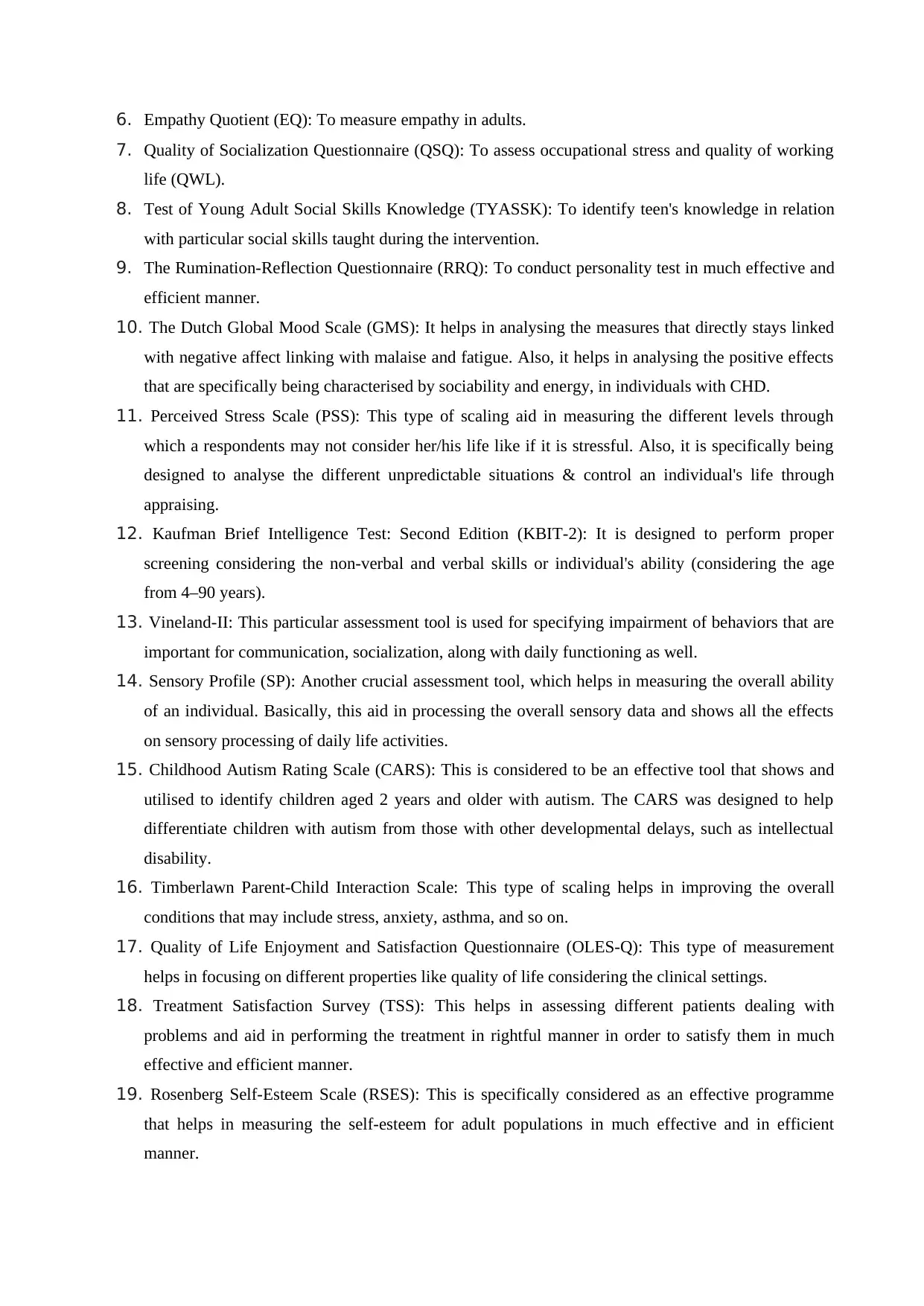
6. Empathy Quotient (EQ): To measure empathy in adults.
7. Quality of Socialization Questionnaire (QSQ): To assess occupational stress and quality of working
life (QWL).
8. Test of Young Adult Social Skills Knowledge (TYASSK): To identify teen's knowledge in relation
with particular social skills taught during the intervention.
9. The Rumination-Reflection Questionnaire (RRQ): To conduct personality test in much effective and
efficient manner.
10. The Dutch Global Mood Scale (GMS): It helps in analysing the measures that directly stays linked
with negative affect linking with malaise and fatigue. Also, it helps in analysing the positive effects
that are specifically being characterised by sociability and energy, in individuals with CHD.
11. Perceived Stress Scale (PSS): This type of scaling aid in measuring the different levels through
which a respondents may not consider her/his life like if it is stressful. Also, it is specifically being
designed to analyse the different unpredictable situations & control an individual's life through
appraising.
12. Kaufman Brief Intelligence Test: Second Edition (KBIT-2): It is designed to perform proper
screening considering the non-verbal and verbal skills or individual's ability (considering the age
from 4–90 years).
13. Vineland-II: This particular assessment tool is used for specifying impairment of behaviors that are
important for communication, socialization, along with daily functioning as well.
14. Sensory Profile (SP): Another crucial assessment tool, which helps in measuring the overall ability
of an individual. Basically, this aid in processing the overall sensory data and shows all the effects
on sensory processing of daily life activities.
15. Childhood Autism Rating Scale (CARS): This is considered to be an effective tool that shows and
utilised to identify children aged 2 years and older with autism. The CARS was designed to help
differentiate children with autism from those with other developmental delays, such as intellectual
disability.
16. Timberlawn Parent-Child Interaction Scale: This type of scaling helps in improving the overall
conditions that may include stress, anxiety, asthma, and so on.
17. Quality of Life Enjoyment and Satisfaction Questionnaire (OLES-Q): This type of measurement
helps in focusing on different properties like quality of life considering the clinical settings.
18. Treatment Satisfaction Survey (TSS): This helps in assessing different patients dealing with
problems and aid in performing the treatment in rightful manner in order to satisfy them in much
effective and efficient manner.
19. Rosenberg Self-Esteem Scale (RSES): This is specifically considered as an effective programme
that helps in measuring the self-esteem for adult populations in much effective and in efficient
manner.
7. Quality of Socialization Questionnaire (QSQ): To assess occupational stress and quality of working
life (QWL).
8. Test of Young Adult Social Skills Knowledge (TYASSK): To identify teen's knowledge in relation
with particular social skills taught during the intervention.
9. The Rumination-Reflection Questionnaire (RRQ): To conduct personality test in much effective and
efficient manner.
10. The Dutch Global Mood Scale (GMS): It helps in analysing the measures that directly stays linked
with negative affect linking with malaise and fatigue. Also, it helps in analysing the positive effects
that are specifically being characterised by sociability and energy, in individuals with CHD.
11. Perceived Stress Scale (PSS): This type of scaling aid in measuring the different levels through
which a respondents may not consider her/his life like if it is stressful. Also, it is specifically being
designed to analyse the different unpredictable situations & control an individual's life through
appraising.
12. Kaufman Brief Intelligence Test: Second Edition (KBIT-2): It is designed to perform proper
screening considering the non-verbal and verbal skills or individual's ability (considering the age
from 4–90 years).
13. Vineland-II: This particular assessment tool is used for specifying impairment of behaviors that are
important for communication, socialization, along with daily functioning as well.
14. Sensory Profile (SP): Another crucial assessment tool, which helps in measuring the overall ability
of an individual. Basically, this aid in processing the overall sensory data and shows all the effects
on sensory processing of daily life activities.
15. Childhood Autism Rating Scale (CARS): This is considered to be an effective tool that shows and
utilised to identify children aged 2 years and older with autism. The CARS was designed to help
differentiate children with autism from those with other developmental delays, such as intellectual
disability.
16. Timberlawn Parent-Child Interaction Scale: This type of scaling helps in improving the overall
conditions that may include stress, anxiety, asthma, and so on.
17. Quality of Life Enjoyment and Satisfaction Questionnaire (OLES-Q): This type of measurement
helps in focusing on different properties like quality of life considering the clinical settings.
18. Treatment Satisfaction Survey (TSS): This helps in assessing different patients dealing with
problems and aid in performing the treatment in rightful manner in order to satisfy them in much
effective and efficient manner.
19. Rosenberg Self-Esteem Scale (RSES): This is specifically considered as an effective programme
that helps in measuring the self-esteem for adult populations in much effective and in efficient
manner.
Secure Best Marks with AI Grader
Need help grading? Try our AI Grader for instant feedback on your assignments.
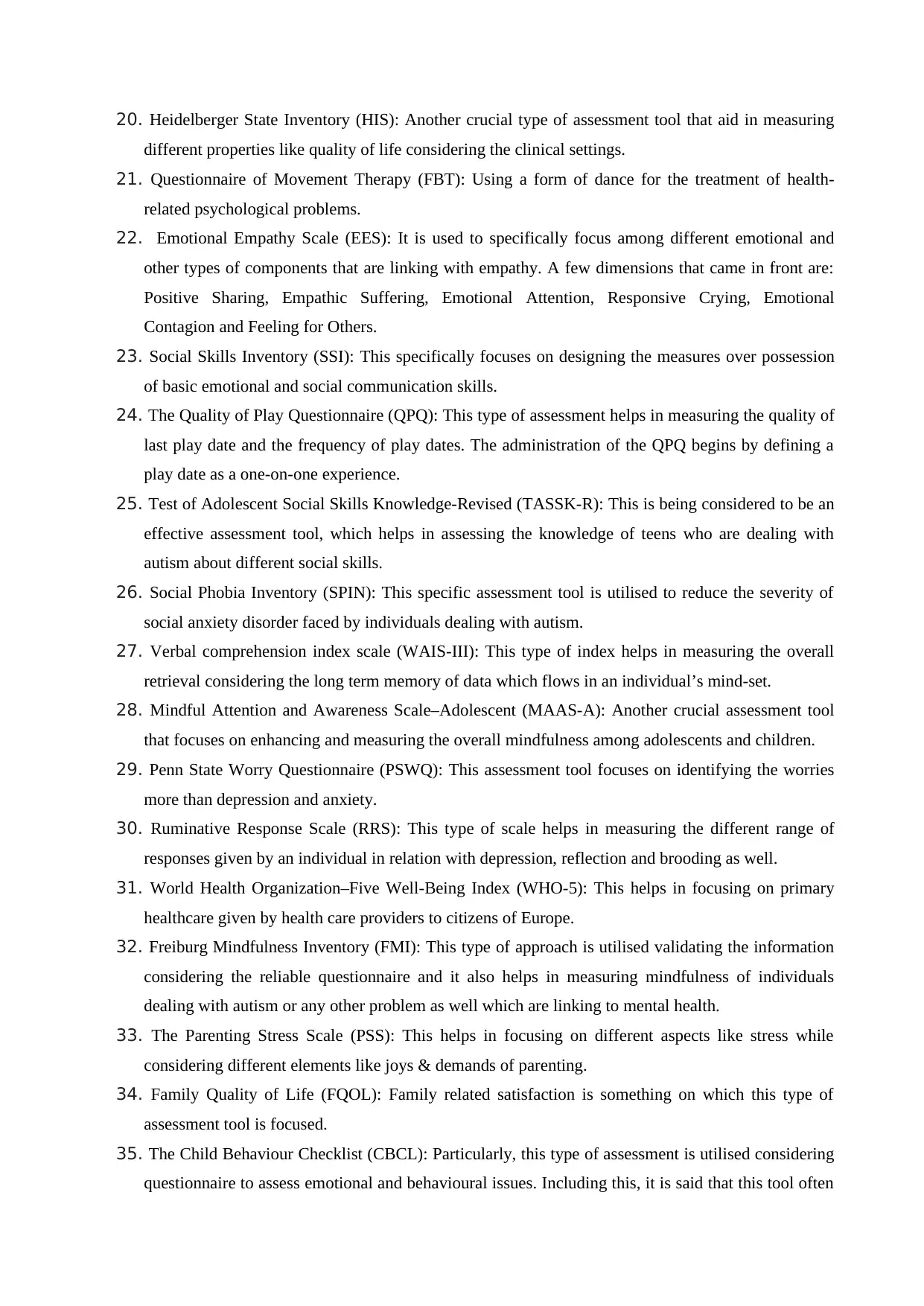
20. Heidelberger State Inventory (HIS): Another crucial type of assessment tool that aid in measuring
different properties like quality of life considering the clinical settings.
21. Questionnaire of Movement Therapy (FBT): Using a form of dance for the treatment of health-
related psychological problems.
22. Emotional Empathy Scale (EES): It is used to specifically focus among different emotional and
other types of components that are linking with empathy. A few dimensions that came in front are:
Positive Sharing, Empathic Suffering, Emotional Attention, Responsive Crying, Emotional
Contagion and Feeling for Others.
23. Social Skills Inventory (SSI): This specifically focuses on designing the measures over possession
of basic emotional and social communication skills.
24. The Quality of Play Questionnaire (QPQ): This type of assessment helps in measuring the quality of
last play date and the frequency of play dates. The administration of the QPQ begins by defining a
play date as a one-on-one experience.
25. Test of Adolescent Social Skills Knowledge-Revised (TASSK-R): This is being considered to be an
effective assessment tool, which helps in assessing the knowledge of teens who are dealing with
autism about different social skills.
26. Social Phobia Inventory (SPIN): This specific assessment tool is utilised to reduce the severity of
social anxiety disorder faced by individuals dealing with autism.
27. Verbal comprehension index scale (WAIS-III): This type of index helps in measuring the overall
retrieval considering the long term memory of data which flows in an individual’s mind-set.
28. Mindful Attention and Awareness Scale–Adolescent (MAAS-A): Another crucial assessment tool
that focuses on enhancing and measuring the overall mindfulness among adolescents and children.
29. Penn State Worry Questionnaire (PSWQ): This assessment tool focuses on identifying the worries
more than depression and anxiety.
30. Ruminative Response Scale (RRS): This type of scale helps in measuring the different range of
responses given by an individual in relation with depression, reflection and brooding as well.
31. World Health Organization–Five Well-Being Index (WHO-5): This helps in focusing on primary
healthcare given by health care providers to citizens of Europe.
32. Freiburg Mindfulness Inventory (FMI): This type of approach is utilised validating the information
considering the reliable questionnaire and it also helps in measuring mindfulness of individuals
dealing with autism or any other problem as well which are linking to mental health.
33. The Parenting Stress Scale (PSS): This helps in focusing on different aspects like stress while
considering different elements like joys & demands of parenting.
34. Family Quality of Life (FQOL): Family related satisfaction is something on which this type of
assessment tool is focused.
35. The Child Behaviour Checklist (CBCL): Particularly, this type of assessment is utilised considering
questionnaire to assess emotional and behavioural issues. Including this, it is said that this tool often
different properties like quality of life considering the clinical settings.
21. Questionnaire of Movement Therapy (FBT): Using a form of dance for the treatment of health-
related psychological problems.
22. Emotional Empathy Scale (EES): It is used to specifically focus among different emotional and
other types of components that are linking with empathy. A few dimensions that came in front are:
Positive Sharing, Empathic Suffering, Emotional Attention, Responsive Crying, Emotional
Contagion and Feeling for Others.
23. Social Skills Inventory (SSI): This specifically focuses on designing the measures over possession
of basic emotional and social communication skills.
24. The Quality of Play Questionnaire (QPQ): This type of assessment helps in measuring the quality of
last play date and the frequency of play dates. The administration of the QPQ begins by defining a
play date as a one-on-one experience.
25. Test of Adolescent Social Skills Knowledge-Revised (TASSK-R): This is being considered to be an
effective assessment tool, which helps in assessing the knowledge of teens who are dealing with
autism about different social skills.
26. Social Phobia Inventory (SPIN): This specific assessment tool is utilised to reduce the severity of
social anxiety disorder faced by individuals dealing with autism.
27. Verbal comprehension index scale (WAIS-III): This type of index helps in measuring the overall
retrieval considering the long term memory of data which flows in an individual’s mind-set.
28. Mindful Attention and Awareness Scale–Adolescent (MAAS-A): Another crucial assessment tool
that focuses on enhancing and measuring the overall mindfulness among adolescents and children.
29. Penn State Worry Questionnaire (PSWQ): This assessment tool focuses on identifying the worries
more than depression and anxiety.
30. Ruminative Response Scale (RRS): This type of scale helps in measuring the different range of
responses given by an individual in relation with depression, reflection and brooding as well.
31. World Health Organization–Five Well-Being Index (WHO-5): This helps in focusing on primary
healthcare given by health care providers to citizens of Europe.
32. Freiburg Mindfulness Inventory (FMI): This type of approach is utilised validating the information
considering the reliable questionnaire and it also helps in measuring mindfulness of individuals
dealing with autism or any other problem as well which are linking to mental health.
33. The Parenting Stress Scale (PSS): This helps in focusing on different aspects like stress while
considering different elements like joys & demands of parenting.
34. Family Quality of Life (FQOL): Family related satisfaction is something on which this type of
assessment tool is focused.
35. The Child Behaviour Checklist (CBCL): Particularly, this type of assessment is utilised considering
questionnaire to assess emotional and behavioural issues. Including this, it is said that this tool often

helps collecting information in relation with diagnostic screener. However, ASD are specifically not
being included under this type of checklist related tests.
36. Hospital Anxiety and Depression Scale (HADS): This type of assessment tool is used for analysing
the different mood disorders of individuals who are going through mental issues like depression,
anxiety and so on
being included under this type of checklist related tests.
36. Hospital Anxiety and Depression Scale (HADS): This type of assessment tool is used for analysing
the different mood disorders of individuals who are going through mental issues like depression,
anxiety and so on
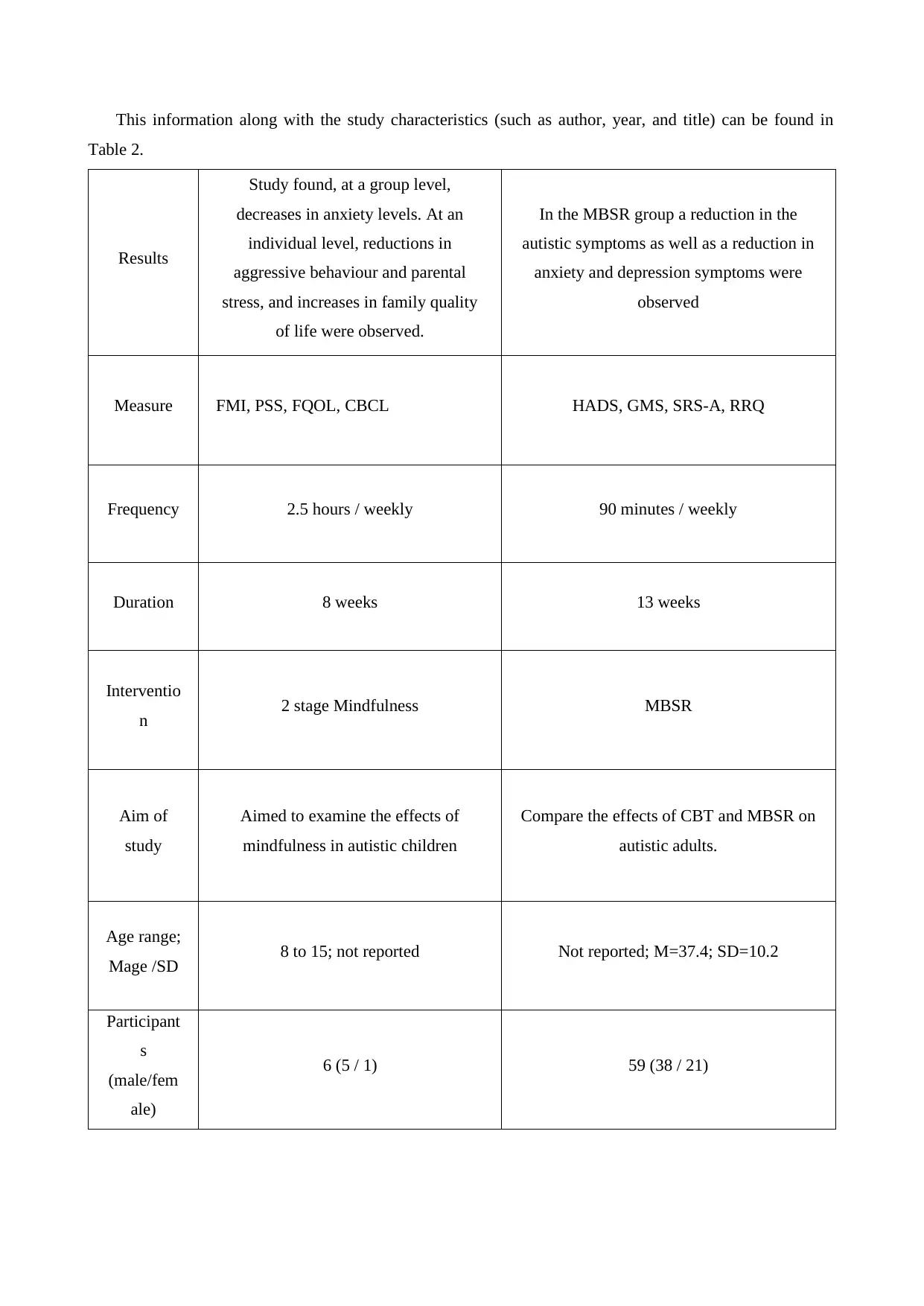
This information along with the study characteristics (such as author, year, and title) can be found in
Table 2.
Results
Study found, at a group level,
decreases in anxiety levels. At an
individual level, reductions in
aggressive behaviour and parental
stress, and increases in family quality
of life were observed.
In the MBSR group a reduction in the
autistic symptoms as well as a reduction in
anxiety and depression symptoms were
observed
Measure FMI, PSS, FQOL, CBCL HADS, GMS, SRS-A, RRQ
Frequency 2.5 hours / weekly 90 minutes / weekly
Duration 8 weeks 13 weeks
Interventio
n 2 stage Mindfulness MBSR
Aim of
study
Aimed to examine the effects of
mindfulness in autistic children
Compare the effects of CBT and MBSR on
autistic adults.
Age range;
Mage /SD 8 to 15; not reported Not reported; M=37.4; SD=10.2
Participant
s
(male/fem
ale)
6 (5 / 1) 59 (38 / 21)
Table 2.
Results
Study found, at a group level,
decreases in anxiety levels. At an
individual level, reductions in
aggressive behaviour and parental
stress, and increases in family quality
of life were observed.
In the MBSR group a reduction in the
autistic symptoms as well as a reduction in
anxiety and depression symptoms were
observed
Measure FMI, PSS, FQOL, CBCL HADS, GMS, SRS-A, RRQ
Frequency 2.5 hours / weekly 90 minutes / weekly
Duration 8 weeks 13 weeks
Interventio
n 2 stage Mindfulness MBSR
Aim of
study
Aimed to examine the effects of
mindfulness in autistic children
Compare the effects of CBT and MBSR on
autistic adults.
Age range;
Mage /SD 8 to 15; not reported Not reported; M=37.4; SD=10.2
Participant
s
(male/fem
ale)
6 (5 / 1) 59 (38 / 21)
Paraphrase This Document
Need a fresh take? Get an instant paraphrase of this document with our AI Paraphraser
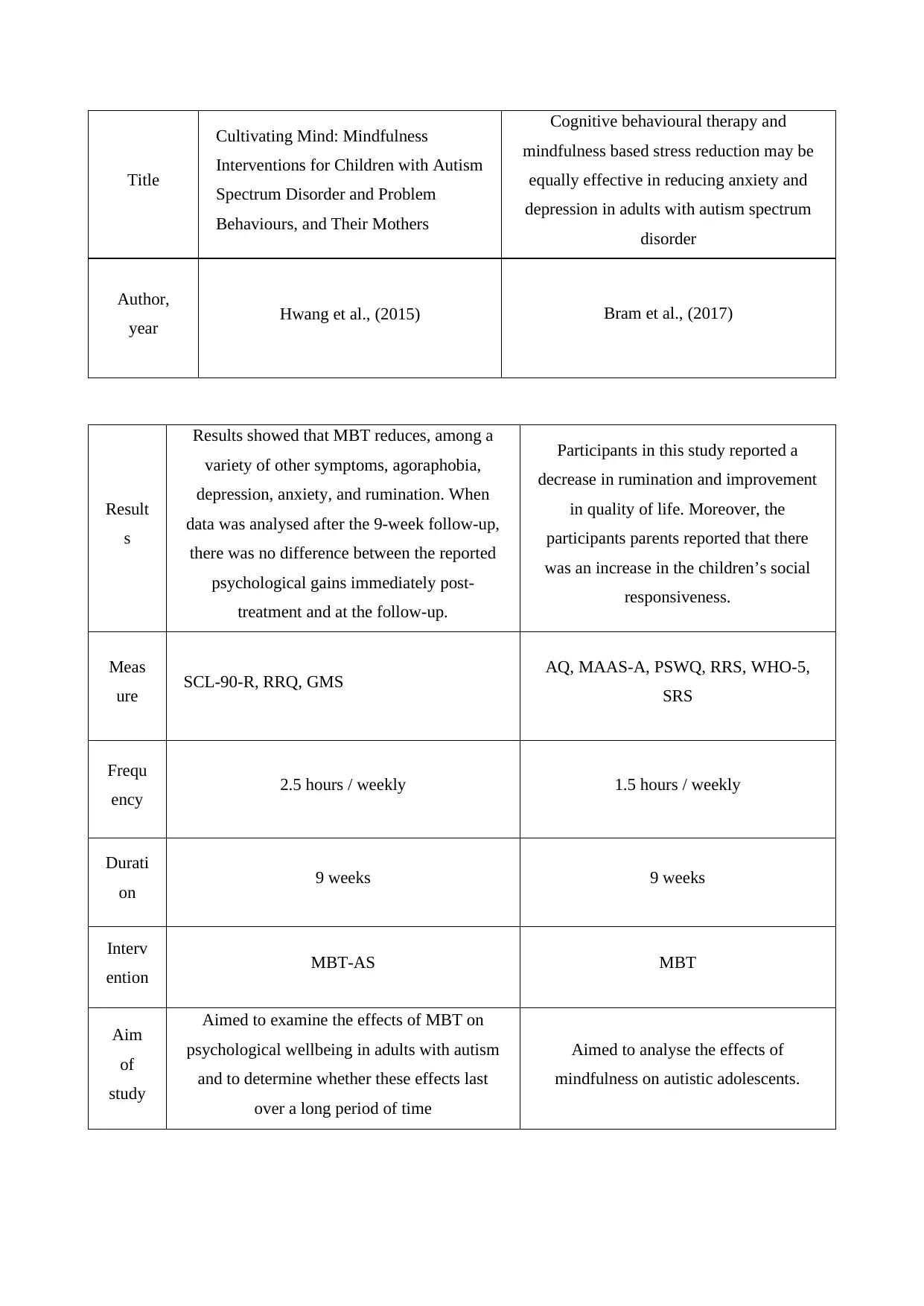
Title
Cultivating Mind: Mindfulness
Interventions for Children with Autism
Spectrum Disorder and Problem
Behaviours, and Their Mothers
Cognitive behavioural therapy and
mindfulness based stress reduction may be
equally effective in reducing anxiety and
depression in adults with autism spectrum
disorder
Author,
year Hwang et al., (2015) Bram et al., (2017)
Result
s
Results showed that MBT reduces, among a
variety of other symptoms, agoraphobia,
depression, anxiety, and rumination. When
data was analysed after the 9-week follow-up,
there was no difference between the reported
psychological gains immediately post-
treatment and at the follow-up.
Participants in this study reported a
decrease in rumination and improvement
in quality of life. Moreover, the
participants parents reported that there
was an increase in the children’s social
responsiveness.
Meas
ure SCL-90-R, RRQ, GMS AQ, MAAS-A, PSWQ, RRS, WHO-5,
SRS
Frequ
ency 2.5 hours / weekly 1.5 hours / weekly
Durati
on 9 weeks 9 weeks
Interv
ention MBT-AS MBT
Aim
of
study
Aimed to examine the effects of MBT on
psychological wellbeing in adults with autism
and to determine whether these effects last
over a long period of time
Aimed to analyse the effects of
mindfulness on autistic adolescents.
Cultivating Mind: Mindfulness
Interventions for Children with Autism
Spectrum Disorder and Problem
Behaviours, and Their Mothers
Cognitive behavioural therapy and
mindfulness based stress reduction may be
equally effective in reducing anxiety and
depression in adults with autism spectrum
disorder
Author,
year Hwang et al., (2015) Bram et al., (2017)
Result
s
Results showed that MBT reduces, among a
variety of other symptoms, agoraphobia,
depression, anxiety, and rumination. When
data was analysed after the 9-week follow-up,
there was no difference between the reported
psychological gains immediately post-
treatment and at the follow-up.
Participants in this study reported a
decrease in rumination and improvement
in quality of life. Moreover, the
participants parents reported that there
was an increase in the children’s social
responsiveness.
Meas
ure SCL-90-R, RRQ, GMS AQ, MAAS-A, PSWQ, RRS, WHO-5,
SRS
Frequ
ency 2.5 hours / weekly 1.5 hours / weekly
Durati
on 9 weeks 9 weeks
Interv
ention MBT-AS MBT
Aim
of
study
Aimed to examine the effects of MBT on
psychological wellbeing in adults with autism
and to determine whether these effects last
over a long period of time
Aimed to analyse the effects of
mindfulness on autistic adolescents.
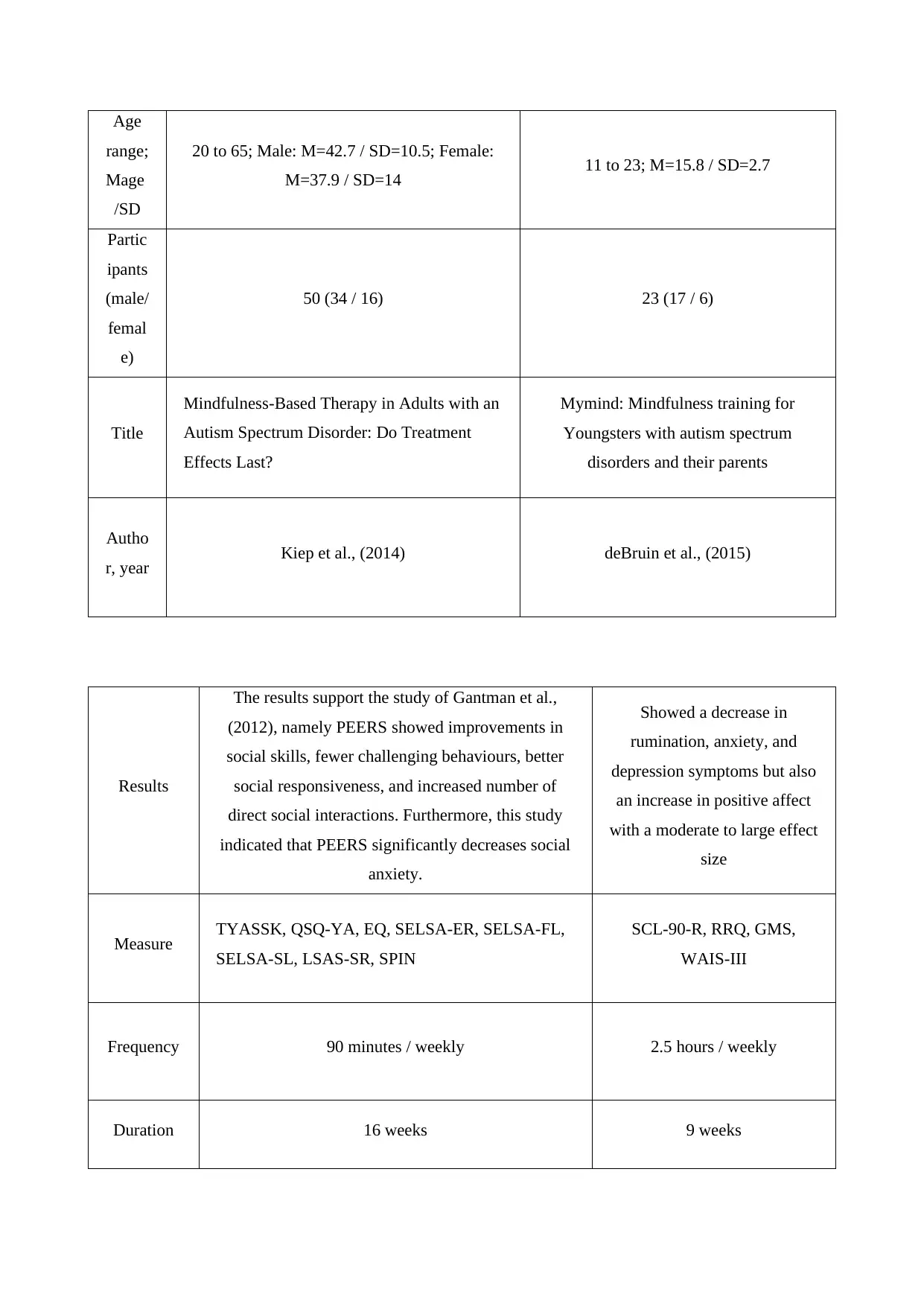
Age
range;
Mage
/SD
20 to 65; Male: M=42.7 / SD=10.5; Female:
M=37.9 / SD=14 11 to 23; M=15.8 / SD=2.7
Partic
ipants
(male/
femal
e)
50 (34 / 16) 23 (17 / 6)
Title
Mindfulness-Based Therapy in Adults with an
Autism Spectrum Disorder: Do Treatment
Effects Last?
Mymind: Mindfulness training for
Youngsters with autism spectrum
disorders and their parents
Autho
r, year Kiep et al., (2014) deBruin et al., (2015)
Results
The results support the study of Gantman et al.,
(2012), namely PEERS showed improvements in
social skills, fewer challenging behaviours, better
social responsiveness, and increased number of
direct social interactions. Furthermore, this study
indicated that PEERS significantly decreases social
anxiety.
Showed a decrease in
rumination, anxiety, and
depression symptoms but also
an increase in positive affect
with a moderate to large effect
size
Measure TYASSK, QSQ-YA, EQ, SELSA-ER, SELSA-FL,
SELSA-SL, LSAS-SR, SPIN
SCL-90-R, RRQ, GMS,
WAIS-III
Frequency 90 minutes / weekly 2.5 hours / weekly
Duration 16 weeks 9 weeks
range;
Mage
/SD
20 to 65; Male: M=42.7 / SD=10.5; Female:
M=37.9 / SD=14 11 to 23; M=15.8 / SD=2.7
Partic
ipants
(male/
femal
e)
50 (34 / 16) 23 (17 / 6)
Title
Mindfulness-Based Therapy in Adults with an
Autism Spectrum Disorder: Do Treatment
Effects Last?
Mymind: Mindfulness training for
Youngsters with autism spectrum
disorders and their parents
Autho
r, year Kiep et al., (2014) deBruin et al., (2015)
Results
The results support the study of Gantman et al.,
(2012), namely PEERS showed improvements in
social skills, fewer challenging behaviours, better
social responsiveness, and increased number of
direct social interactions. Furthermore, this study
indicated that PEERS significantly decreases social
anxiety.
Showed a decrease in
rumination, anxiety, and
depression symptoms but also
an increase in positive affect
with a moderate to large effect
size
Measure TYASSK, QSQ-YA, EQ, SELSA-ER, SELSA-FL,
SELSA-SL, LSAS-SR, SPIN
SCL-90-R, RRQ, GMS,
WAIS-III
Frequency 90 minutes / weekly 2.5 hours / weekly
Duration 16 weeks 9 weeks
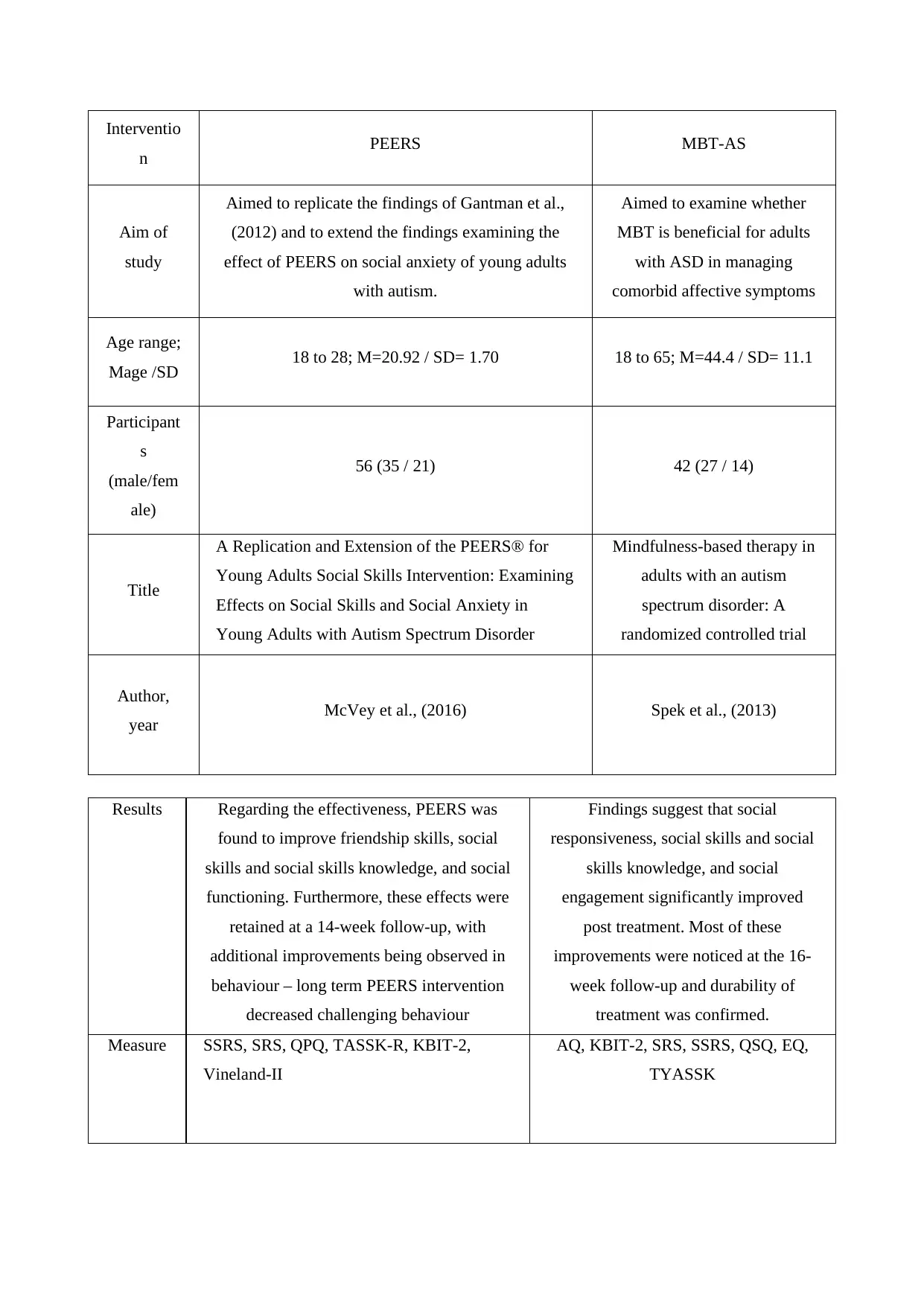
Interventio
n PEERS MBT-AS
Aim of
study
Aimed to replicate the findings of Gantman et al.,
(2012) and to extend the findings examining the
effect of PEERS on social anxiety of young adults
with autism.
Aimed to examine whether
MBT is beneficial for adults
with ASD in managing
comorbid affective symptoms
Age range;
Mage /SD 18 to 28; M=20.92 / SD= 1.70 18 to 65; M=44.4 / SD= 11.1
Participant
s
(male/fem
ale)
56 (35 / 21) 42 (27 / 14)
Title
A Replication and Extension of the PEERS® for
Young Adults Social Skills Intervention: Examining
Effects on Social Skills and Social Anxiety in
Young Adults with Autism Spectrum Disorder
Mindfulness-based therapy in
adults with an autism
spectrum disorder: A
randomized controlled trial
Author,
year McVey et al., (2016) Spek et al., (2013)
Results Regarding the effectiveness, PEERS was
found to improve friendship skills, social
skills and social skills knowledge, and social
functioning. Furthermore, these effects were
retained at a 14-week follow-up, with
additional improvements being observed in
behaviour – long term PEERS intervention
decreased challenging behaviour
Findings suggest that social
responsiveness, social skills and social
skills knowledge, and social
engagement significantly improved
post treatment. Most of these
improvements were noticed at the 16-
week follow-up and durability of
treatment was confirmed.
Measure SSRS, SRS, QPQ, TASSK-R, KBIT-2,
Vineland-II
AQ, KBIT-2, SRS, SSRS, QSQ, EQ,
TYASSK
n PEERS MBT-AS
Aim of
study
Aimed to replicate the findings of Gantman et al.,
(2012) and to extend the findings examining the
effect of PEERS on social anxiety of young adults
with autism.
Aimed to examine whether
MBT is beneficial for adults
with ASD in managing
comorbid affective symptoms
Age range;
Mage /SD 18 to 28; M=20.92 / SD= 1.70 18 to 65; M=44.4 / SD= 11.1
Participant
s
(male/fem
ale)
56 (35 / 21) 42 (27 / 14)
Title
A Replication and Extension of the PEERS® for
Young Adults Social Skills Intervention: Examining
Effects on Social Skills and Social Anxiety in
Young Adults with Autism Spectrum Disorder
Mindfulness-based therapy in
adults with an autism
spectrum disorder: A
randomized controlled trial
Author,
year McVey et al., (2016) Spek et al., (2013)
Results Regarding the effectiveness, PEERS was
found to improve friendship skills, social
skills and social skills knowledge, and social
functioning. Furthermore, these effects were
retained at a 14-week follow-up, with
additional improvements being observed in
behaviour – long term PEERS intervention
decreased challenging behaviour
Findings suggest that social
responsiveness, social skills and social
skills knowledge, and social
engagement significantly improved
post treatment. Most of these
improvements were noticed at the 16-
week follow-up and durability of
treatment was confirmed.
Measure SSRS, SRS, QPQ, TASSK-R, KBIT-2,
Vineland-II
AQ, KBIT-2, SRS, SSRS, QSQ, EQ,
TYASSK
Secure Best Marks with AI Grader
Need help grading? Try our AI Grader for instant feedback on your assignments.
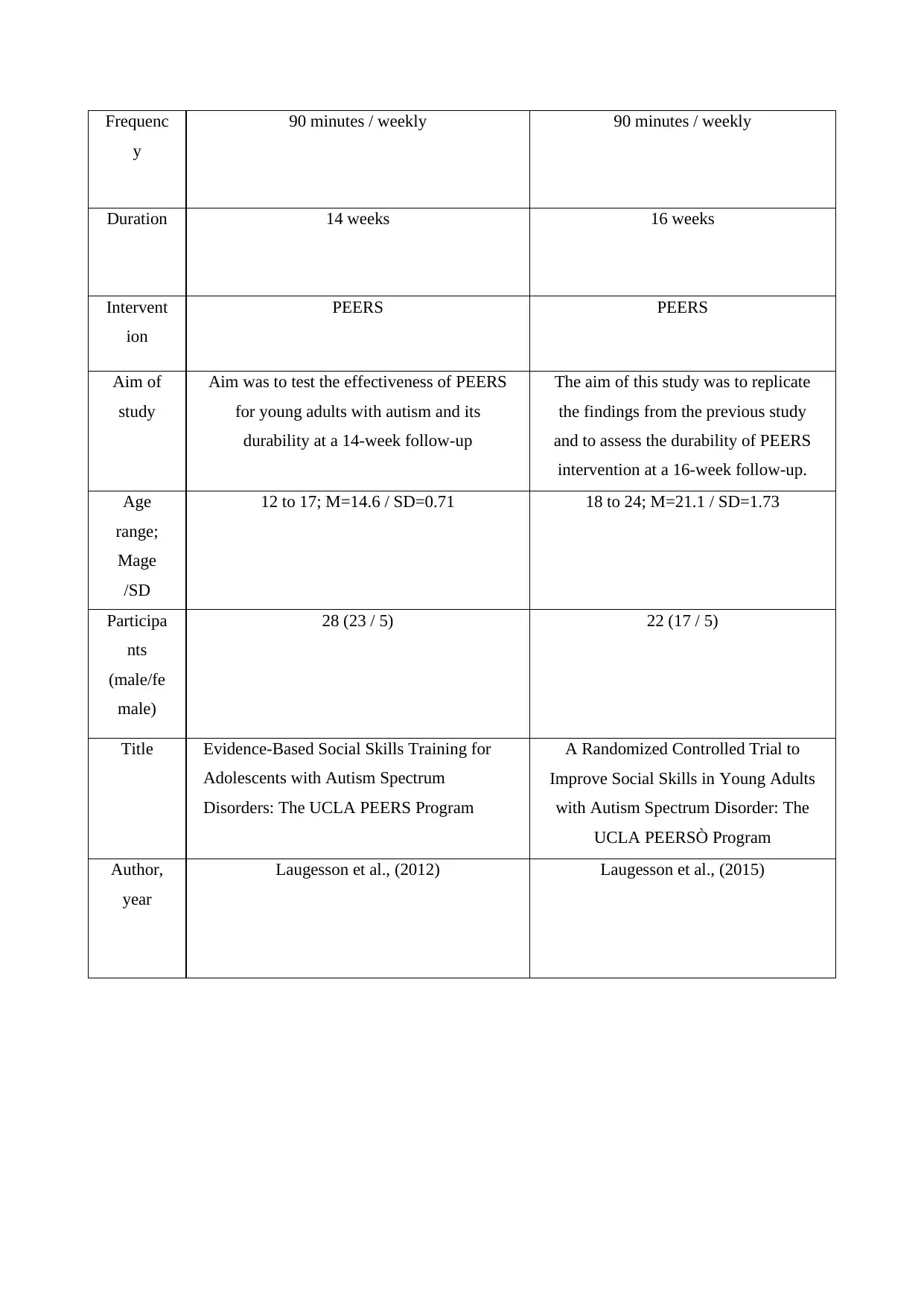
Frequenc
y
90 minutes / weekly 90 minutes / weekly
Duration 14 weeks 16 weeks
Intervent
ion
PEERS PEERS
Aim of
study
Aim was to test the effectiveness of PEERS
for young adults with autism and its
durability at a 14-week follow-up
The aim of this study was to replicate
the findings from the previous study
and to assess the durability of PEERS
intervention at a 16-week follow-up.
Age
range;
Mage
/SD
12 to 17; M=14.6 / SD=0.71 18 to 24; M=21.1 / SD=1.73
Participa
nts
(male/fe
male)
28 (23 / 5) 22 (17 / 5)
Title Evidence-Based Social Skills Training for
Adolescents with Autism Spectrum
Disorders: The UCLA PEERS Program
A Randomized Controlled Trial to
Improve Social Skills in Young Adults
with Autism Spectrum Disorder: The
UCLA PEERSÒ Program
Author,
year
Laugesson et al., (2012) Laugesson et al., (2015)
y
90 minutes / weekly 90 minutes / weekly
Duration 14 weeks 16 weeks
Intervent
ion
PEERS PEERS
Aim of
study
Aim was to test the effectiveness of PEERS
for young adults with autism and its
durability at a 14-week follow-up
The aim of this study was to replicate
the findings from the previous study
and to assess the durability of PEERS
intervention at a 16-week follow-up.
Age
range;
Mage
/SD
12 to 17; M=14.6 / SD=0.71 18 to 24; M=21.1 / SD=1.73
Participa
nts
(male/fe
male)
28 (23 / 5) 22 (17 / 5)
Title Evidence-Based Social Skills Training for
Adolescents with Autism Spectrum
Disorders: The UCLA PEERS Program
A Randomized Controlled Trial to
Improve Social Skills in Young Adults
with Autism Spectrum Disorder: The
UCLA PEERSÒ Program
Author,
year
Laugesson et al., (2012) Laugesson et al., (2015)
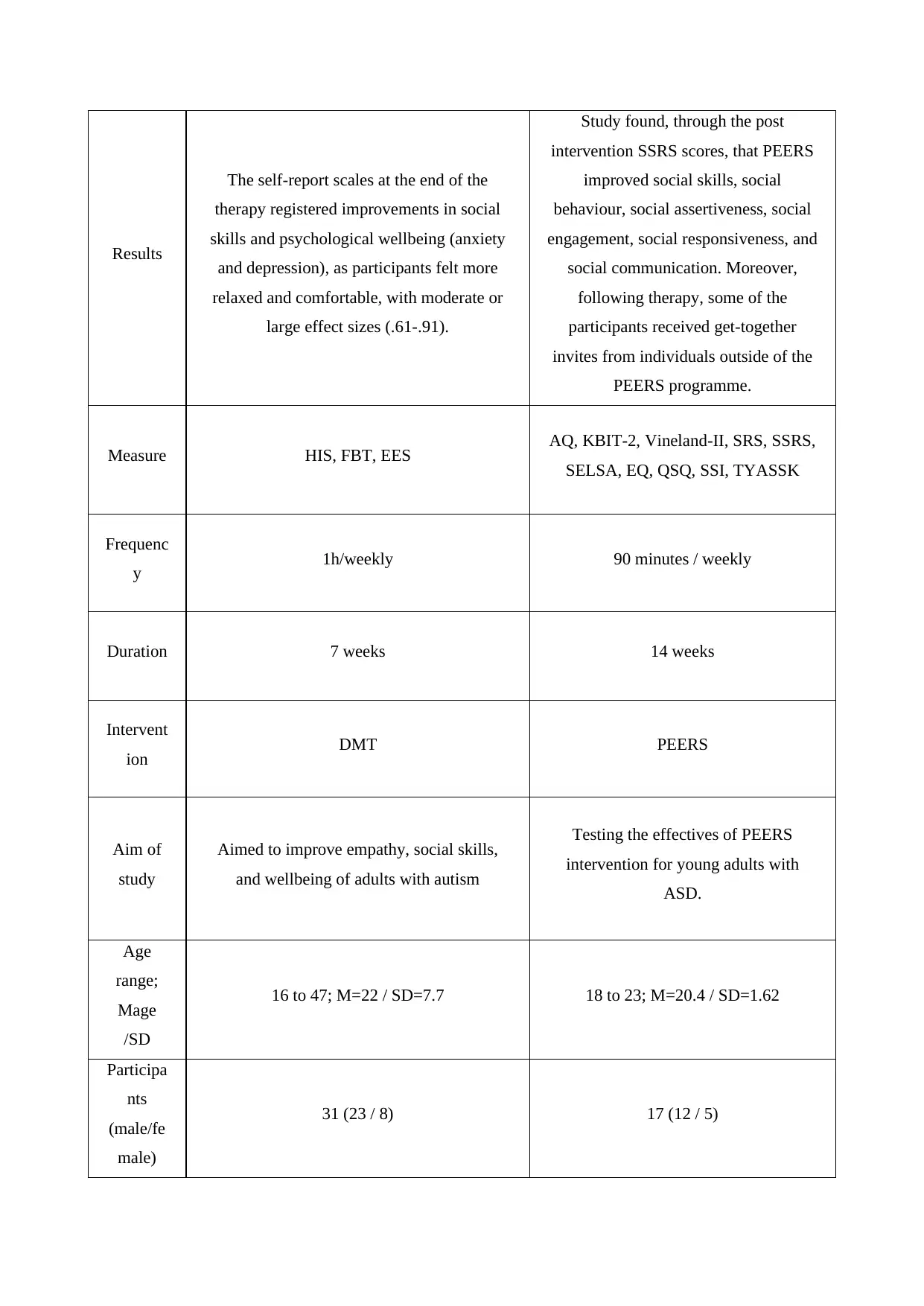
Results
The self-report scales at the end of the
therapy registered improvements in social
skills and psychological wellbeing (anxiety
and depression), as participants felt more
relaxed and comfortable, with moderate or
large effect sizes (.61-.91).
Study found, through the post
intervention SSRS scores, that PEERS
improved social skills, social
behaviour, social assertiveness, social
engagement, social responsiveness, and
social communication. Moreover,
following therapy, some of the
participants received get-together
invites from individuals outside of the
PEERS programme.
Measure HIS, FBT, EES AQ, KBIT-2, Vineland-II, SRS, SSRS,
SELSA, EQ, QSQ, SSI, TYASSK
Frequenc
y 1h/weekly 90 minutes / weekly
Duration 7 weeks 14 weeks
Intervent
ion DMT PEERS
Aim of
study
Aimed to improve empathy, social skills,
and wellbeing of adults with autism
Testing the effectives of PEERS
intervention for young adults with
ASD.
Age
range;
Mage
/SD
16 to 47; M=22 / SD=7.7 18 to 23; M=20.4 / SD=1.62
Participa
nts
(male/fe
male)
31 (23 / 8) 17 (12 / 5)
The self-report scales at the end of the
therapy registered improvements in social
skills and psychological wellbeing (anxiety
and depression), as participants felt more
relaxed and comfortable, with moderate or
large effect sizes (.61-.91).
Study found, through the post
intervention SSRS scores, that PEERS
improved social skills, social
behaviour, social assertiveness, social
engagement, social responsiveness, and
social communication. Moreover,
following therapy, some of the
participants received get-together
invites from individuals outside of the
PEERS programme.
Measure HIS, FBT, EES AQ, KBIT-2, Vineland-II, SRS, SSRS,
SELSA, EQ, QSQ, SSI, TYASSK
Frequenc
y 1h/weekly 90 minutes / weekly
Duration 7 weeks 14 weeks
Intervent
ion DMT PEERS
Aim of
study
Aimed to improve empathy, social skills,
and wellbeing of adults with autism
Testing the effectives of PEERS
intervention for young adults with
ASD.
Age
range;
Mage
/SD
16 to 47; M=22 / SD=7.7 18 to 23; M=20.4 / SD=1.62
Participa
nts
(male/fe
male)
31 (23 / 8) 17 (12 / 5)
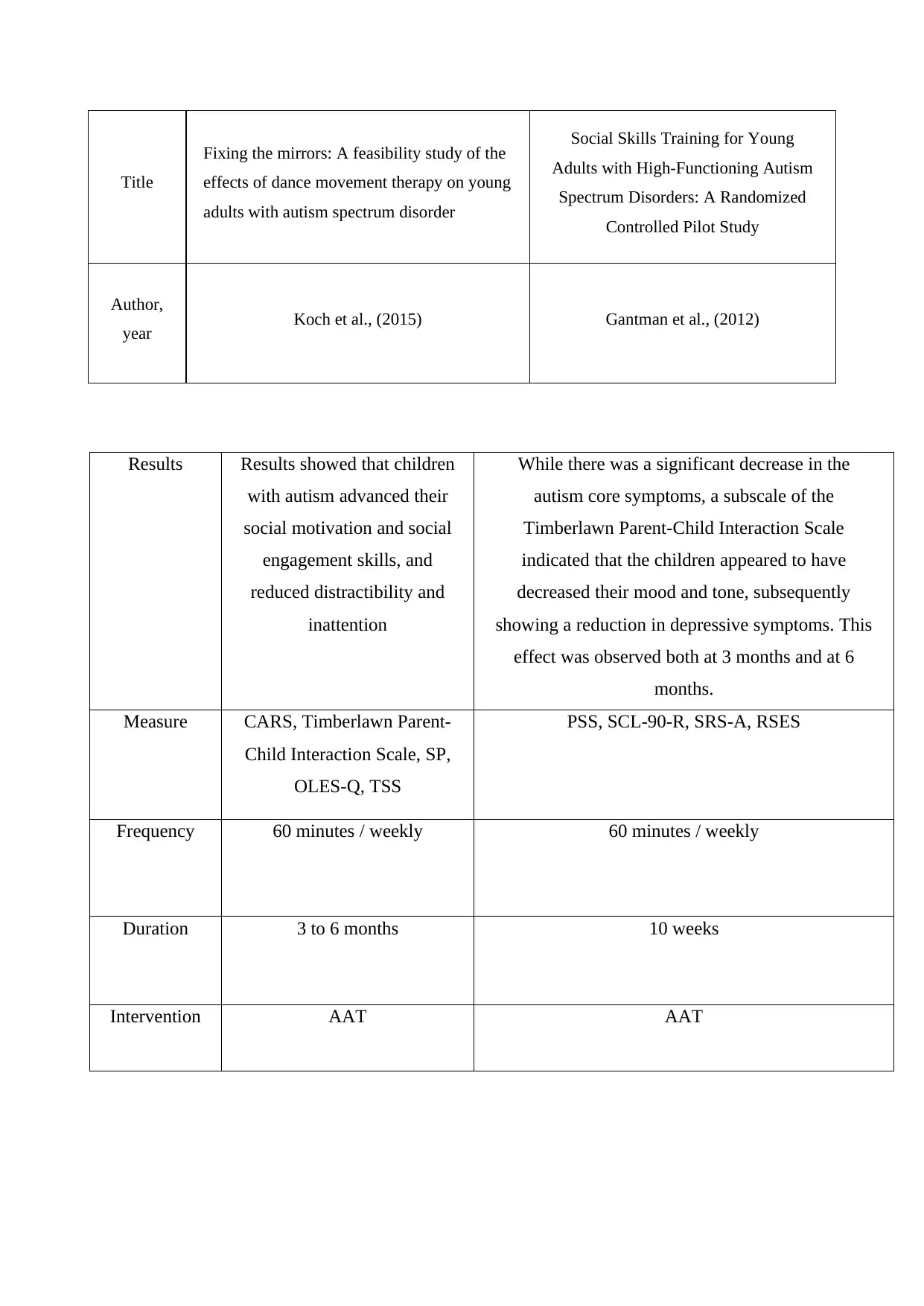
Title
Fixing the mirrors: A feasibility study of the
effects of dance movement therapy on young
adults with autism spectrum disorder
Social Skills Training for Young
Adults with High-Functioning Autism
Spectrum Disorders: A Randomized
Controlled Pilot Study
Author,
year Koch et al., (2015) Gantman et al., (2012)
Results Results showed that children
with autism advanced their
social motivation and social
engagement skills, and
reduced distractibility and
inattention
While there was a significant decrease in the
autism core symptoms, a subscale of the
Timberlawn Parent-Child Interaction Scale
indicated that the children appeared to have
decreased their mood and tone, subsequently
showing a reduction in depressive symptoms. This
effect was observed both at 3 months and at 6
months.
Measure CARS, Timberlawn Parent-
Child Interaction Scale, SP,
OLES-Q, TSS
PSS, SCL-90-R, SRS-A, RSES
Frequency 60 minutes / weekly 60 minutes / weekly
Duration 3 to 6 months 10 weeks
Intervention AAT AAT
Fixing the mirrors: A feasibility study of the
effects of dance movement therapy on young
adults with autism spectrum disorder
Social Skills Training for Young
Adults with High-Functioning Autism
Spectrum Disorders: A Randomized
Controlled Pilot Study
Author,
year Koch et al., (2015) Gantman et al., (2012)
Results Results showed that children
with autism advanced their
social motivation and social
engagement skills, and
reduced distractibility and
inattention
While there was a significant decrease in the
autism core symptoms, a subscale of the
Timberlawn Parent-Child Interaction Scale
indicated that the children appeared to have
decreased their mood and tone, subsequently
showing a reduction in depressive symptoms. This
effect was observed both at 3 months and at 6
months.
Measure CARS, Timberlawn Parent-
Child Interaction Scale, SP,
OLES-Q, TSS
PSS, SCL-90-R, SRS-A, RSES
Frequency 60 minutes / weekly 60 minutes / weekly
Duration 3 to 6 months 10 weeks
Intervention AAT AAT
Paraphrase This Document
Need a fresh take? Get an instant paraphrase of this document with our AI Paraphraser
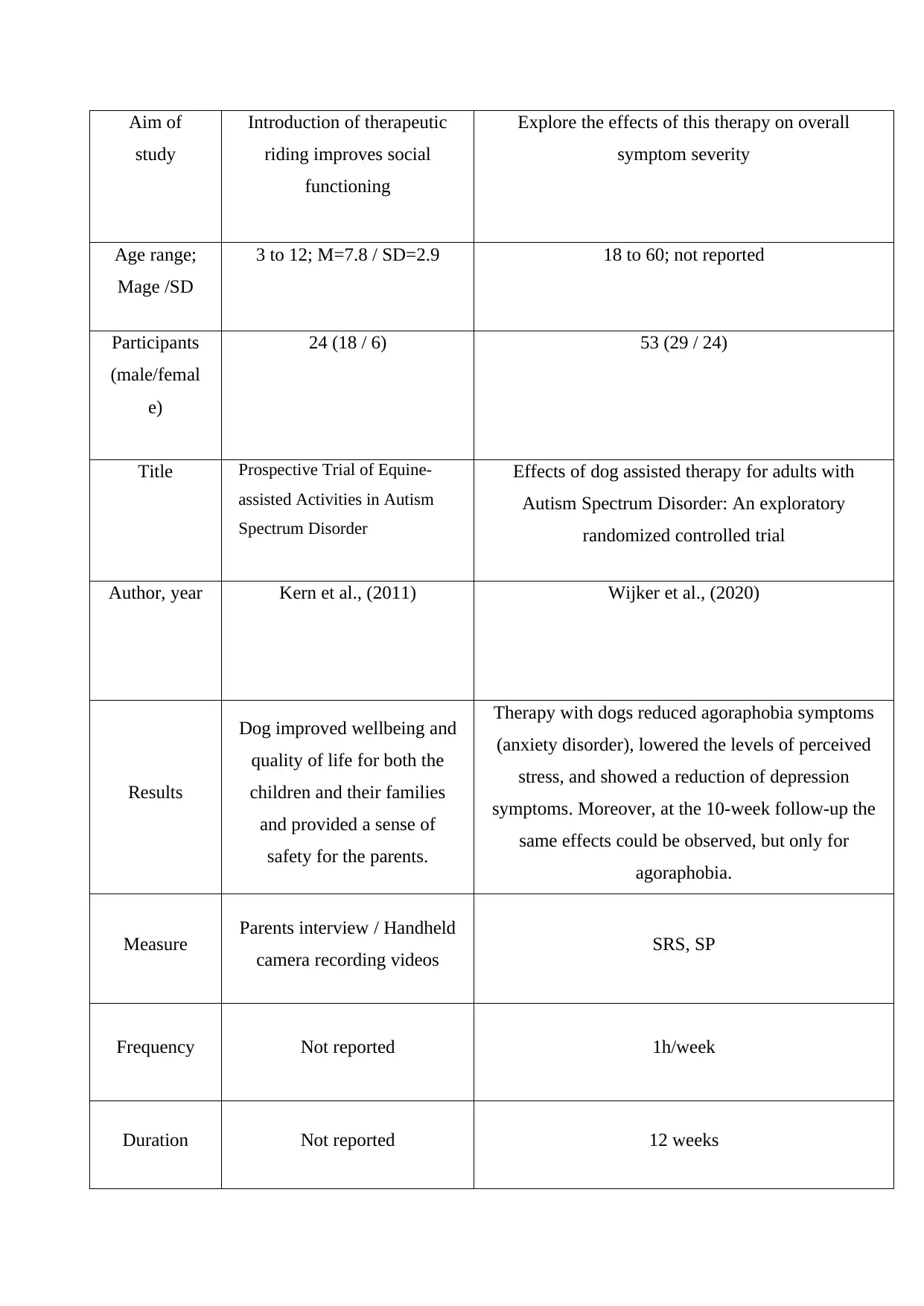
Aim of
study
Introduction of therapeutic
riding improves social
functioning
Explore the effects of this therapy on overall
symptom severity
Age range;
Mage /SD
3 to 12; M=7.8 / SD=2.9 18 to 60; not reported
Participants
(male/femal
e)
24 (18 / 6) 53 (29 / 24)
Title Prospective Trial of Equine-
assisted Activities in Autism
Spectrum Disorder
Effects of dog assisted therapy for adults with
Autism Spectrum Disorder: An exploratory
randomized controlled trial
Author, year Kern et al., (2011) Wijker et al., (2020)
Results
Dog improved wellbeing and
quality of life for both the
children and their families
and provided a sense of
safety for the parents.
Therapy with dogs reduced agoraphobia symptoms
(anxiety disorder), lowered the levels of perceived
stress, and showed a reduction of depression
symptoms. Moreover, at the 10-week follow-up the
same effects could be observed, but only for
agoraphobia.
Measure Parents interview / Handheld
camera recording videos SRS, SP
Frequency Not reported 1h/week
Duration Not reported 12 weeks
study
Introduction of therapeutic
riding improves social
functioning
Explore the effects of this therapy on overall
symptom severity
Age range;
Mage /SD
3 to 12; M=7.8 / SD=2.9 18 to 60; not reported
Participants
(male/femal
e)
24 (18 / 6) 53 (29 / 24)
Title Prospective Trial of Equine-
assisted Activities in Autism
Spectrum Disorder
Effects of dog assisted therapy for adults with
Autism Spectrum Disorder: An exploratory
randomized controlled trial
Author, year Kern et al., (2011) Wijker et al., (2020)
Results
Dog improved wellbeing and
quality of life for both the
children and their families
and provided a sense of
safety for the parents.
Therapy with dogs reduced agoraphobia symptoms
(anxiety disorder), lowered the levels of perceived
stress, and showed a reduction of depression
symptoms. Moreover, at the 10-week follow-up the
same effects could be observed, but only for
agoraphobia.
Measure Parents interview / Handheld
camera recording videos SRS, SP
Frequency Not reported 1h/week
Duration Not reported 12 weeks
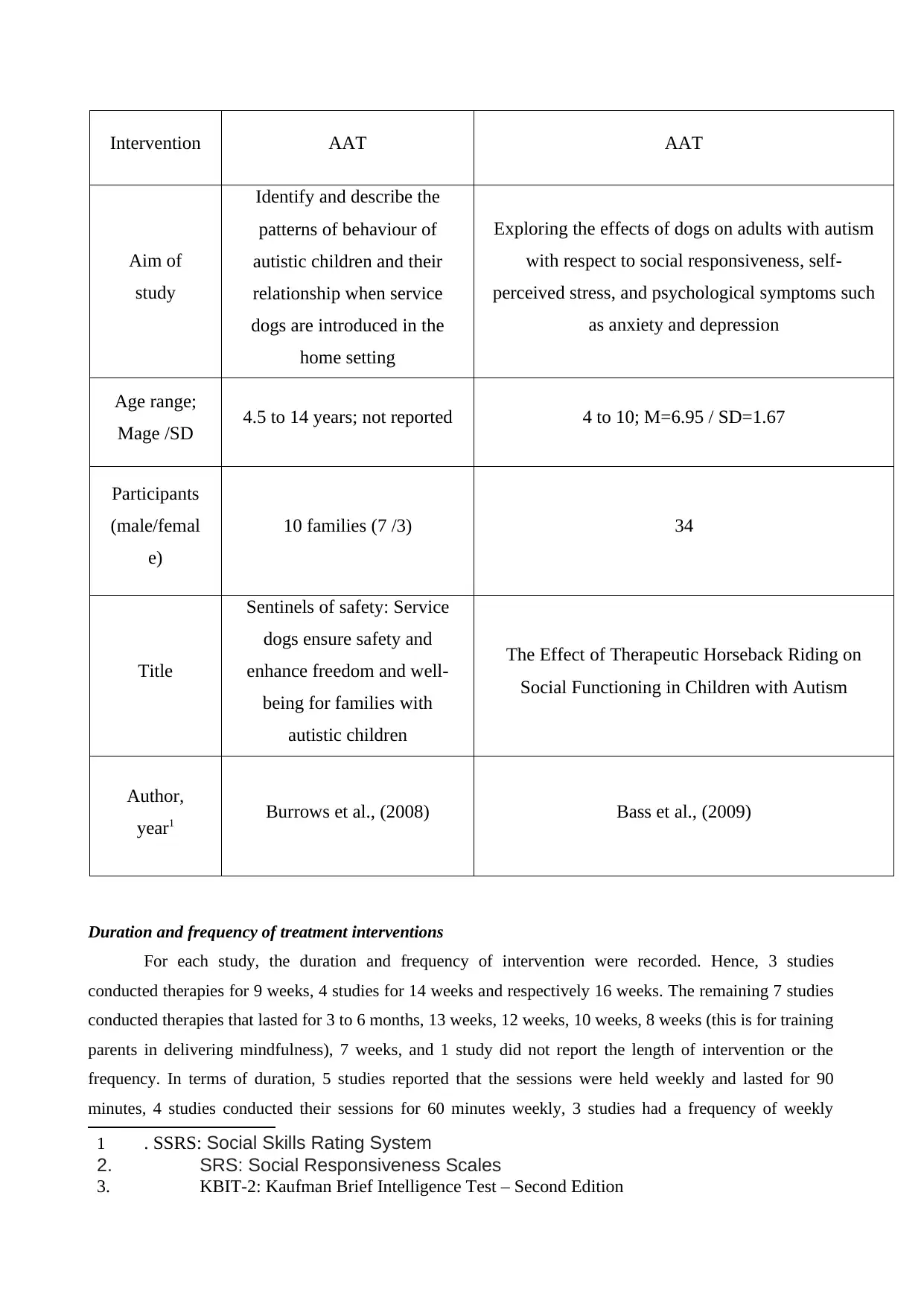
Intervention AAT AAT
Aim of
study
Identify and describe the
patterns of behaviour of
autistic children and their
relationship when service
dogs are introduced in the
home setting
Exploring the effects of dogs on adults with autism
with respect to social responsiveness, self-
perceived stress, and psychological symptoms such
as anxiety and depression
Age range;
Mage /SD 4.5 to 14 years; not reported 4 to 10; M=6.95 / SD=1.67
Participants
(male/femal
e)
10 families (7 /3) 34
Title
Sentinels of safety: Service
dogs ensure safety and
enhance freedom and well-
being for families with
autistic children
The Effect of Therapeutic Horseback Riding on
Social Functioning in Children with Autism
Author,
year1 Burrows et al., (2008) Bass et al., (2009)
Duration and frequency of treatment interventions
For each study, the duration and frequency of intervention were recorded. Hence, 3 studies
conducted therapies for 9 weeks, 4 studies for 14 weeks and respectively 16 weeks. The remaining 7 studies
conducted therapies that lasted for 3 to 6 months, 13 weeks, 12 weeks, 10 weeks, 8 weeks (this is for training
parents in delivering mindfulness), 7 weeks, and 1 study did not report the length of intervention or the
frequency. In terms of duration, 5 studies reported that the sessions were held weekly and lasted for 90
minutes, 4 studies conducted their sessions for 60 minutes weekly, 3 studies had a frequency of weekly
1 . SSRS: Social Skills Rating System
2. SRS: Social Responsiveness Scales
3. KBIT-2: Kaufman Brief Intelligence Test – Second Edition
Aim of
study
Identify and describe the
patterns of behaviour of
autistic children and their
relationship when service
dogs are introduced in the
home setting
Exploring the effects of dogs on adults with autism
with respect to social responsiveness, self-
perceived stress, and psychological symptoms such
as anxiety and depression
Age range;
Mage /SD 4.5 to 14 years; not reported 4 to 10; M=6.95 / SD=1.67
Participants
(male/femal
e)
10 families (7 /3) 34
Title
Sentinels of safety: Service
dogs ensure safety and
enhance freedom and well-
being for families with
autistic children
The Effect of Therapeutic Horseback Riding on
Social Functioning in Children with Autism
Author,
year1 Burrows et al., (2008) Bass et al., (2009)
Duration and frequency of treatment interventions
For each study, the duration and frequency of intervention were recorded. Hence, 3 studies
conducted therapies for 9 weeks, 4 studies for 14 weeks and respectively 16 weeks. The remaining 7 studies
conducted therapies that lasted for 3 to 6 months, 13 weeks, 12 weeks, 10 weeks, 8 weeks (this is for training
parents in delivering mindfulness), 7 weeks, and 1 study did not report the length of intervention or the
frequency. In terms of duration, 5 studies reported that the sessions were held weekly and lasted for 90
minutes, 4 studies conducted their sessions for 60 minutes weekly, 3 studies had a frequency of weekly
1 . SSRS: Social Skills Rating System
2. SRS: Social Responsiveness Scales
3. KBIT-2: Kaufman Brief Intelligence Test – Second Edition
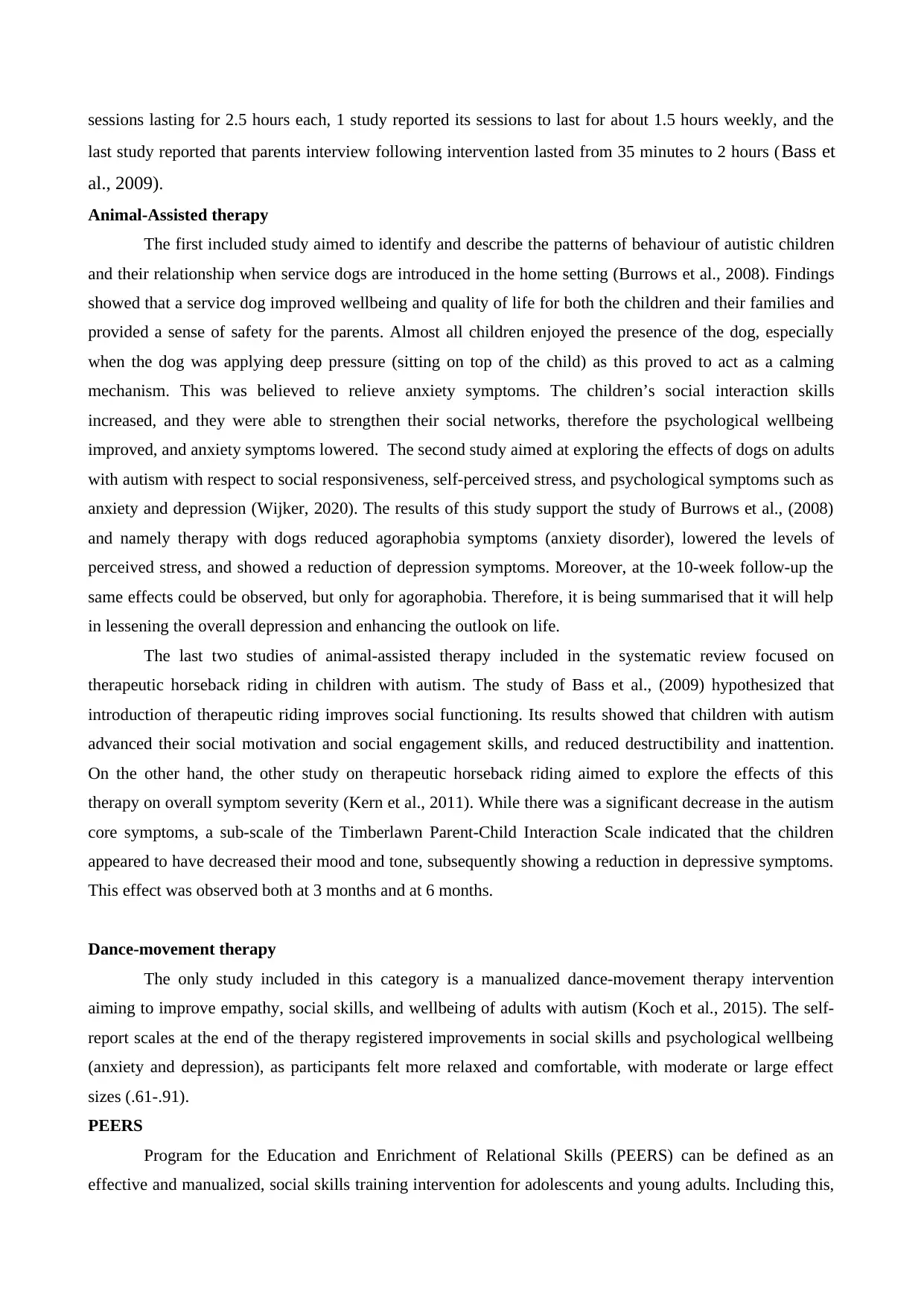
sessions lasting for 2.5 hours each, 1 study reported its sessions to last for about 1.5 hours weekly, and the
last study reported that parents interview following intervention lasted from 35 minutes to 2 hours (Bass et
al., 2009).
Animal-Assisted therapy
The first included study aimed to identify and describe the patterns of behaviour of autistic children
and their relationship when service dogs are introduced in the home setting (Burrows et al., 2008). Findings
showed that a service dog improved wellbeing and quality of life for both the children and their families and
provided a sense of safety for the parents. Almost all children enjoyed the presence of the dog, especially
when the dog was applying deep pressure (sitting on top of the child) as this proved to act as a calming
mechanism. This was believed to relieve anxiety symptoms. The children’s social interaction skills
increased, and they were able to strengthen their social networks, therefore the psychological wellbeing
improved, and anxiety symptoms lowered. The second study aimed at exploring the effects of dogs on adults
with autism with respect to social responsiveness, self-perceived stress, and psychological symptoms such as
anxiety and depression (Wijker, 2020). The results of this study support the study of Burrows et al., (2008)
and namely therapy with dogs reduced agoraphobia symptoms (anxiety disorder), lowered the levels of
perceived stress, and showed a reduction of depression symptoms. Moreover, at the 10-week follow-up the
same effects could be observed, but only for agoraphobia. Therefore, it is being summarised that it will help
in lessening the overall depression and enhancing the outlook on life.
The last two studies of animal-assisted therapy included in the systematic review focused on
therapeutic horseback riding in children with autism. The study of Bass et al., (2009) hypothesized that
introduction of therapeutic riding improves social functioning. Its results showed that children with autism
advanced their social motivation and social engagement skills, and reduced destructibility and inattention.
On the other hand, the other study on therapeutic horseback riding aimed to explore the effects of this
therapy on overall symptom severity (Kern et al., 2011). While there was a significant decrease in the autism
core symptoms, a sub-scale of the Timberlawn Parent-Child Interaction Scale indicated that the children
appeared to have decreased their mood and tone, subsequently showing a reduction in depressive symptoms.
This effect was observed both at 3 months and at 6 months.
Dance-movement therapy
The only study included in this category is a manualized dance-movement therapy intervention
aiming to improve empathy, social skills, and wellbeing of adults with autism (Koch et al., 2015). The self-
report scales at the end of the therapy registered improvements in social skills and psychological wellbeing
(anxiety and depression), as participants felt more relaxed and comfortable, with moderate or large effect
sizes (.61-.91).
PEERS
Program for the Education and Enrichment of Relational Skills (PEERS) can be defined as an
effective and manualized, social skills training intervention for adolescents and young adults. Including this,
last study reported that parents interview following intervention lasted from 35 minutes to 2 hours (Bass et
al., 2009).
Animal-Assisted therapy
The first included study aimed to identify and describe the patterns of behaviour of autistic children
and their relationship when service dogs are introduced in the home setting (Burrows et al., 2008). Findings
showed that a service dog improved wellbeing and quality of life for both the children and their families and
provided a sense of safety for the parents. Almost all children enjoyed the presence of the dog, especially
when the dog was applying deep pressure (sitting on top of the child) as this proved to act as a calming
mechanism. This was believed to relieve anxiety symptoms. The children’s social interaction skills
increased, and they were able to strengthen their social networks, therefore the psychological wellbeing
improved, and anxiety symptoms lowered. The second study aimed at exploring the effects of dogs on adults
with autism with respect to social responsiveness, self-perceived stress, and psychological symptoms such as
anxiety and depression (Wijker, 2020). The results of this study support the study of Burrows et al., (2008)
and namely therapy with dogs reduced agoraphobia symptoms (anxiety disorder), lowered the levels of
perceived stress, and showed a reduction of depression symptoms. Moreover, at the 10-week follow-up the
same effects could be observed, but only for agoraphobia. Therefore, it is being summarised that it will help
in lessening the overall depression and enhancing the outlook on life.
The last two studies of animal-assisted therapy included in the systematic review focused on
therapeutic horseback riding in children with autism. The study of Bass et al., (2009) hypothesized that
introduction of therapeutic riding improves social functioning. Its results showed that children with autism
advanced their social motivation and social engagement skills, and reduced destructibility and inattention.
On the other hand, the other study on therapeutic horseback riding aimed to explore the effects of this
therapy on overall symptom severity (Kern et al., 2011). While there was a significant decrease in the autism
core symptoms, a sub-scale of the Timberlawn Parent-Child Interaction Scale indicated that the children
appeared to have decreased their mood and tone, subsequently showing a reduction in depressive symptoms.
This effect was observed both at 3 months and at 6 months.
Dance-movement therapy
The only study included in this category is a manualized dance-movement therapy intervention
aiming to improve empathy, social skills, and wellbeing of adults with autism (Koch et al., 2015). The self-
report scales at the end of the therapy registered improvements in social skills and psychological wellbeing
(anxiety and depression), as participants felt more relaxed and comfortable, with moderate or large effect
sizes (.61-.91).
PEERS
Program for the Education and Enrichment of Relational Skills (PEERS) can be defined as an
effective and manualized, social skills training intervention for adolescents and young adults. Including this,
Secure Best Marks with AI Grader
Need help grading? Try our AI Grader for instant feedback on your assignments.
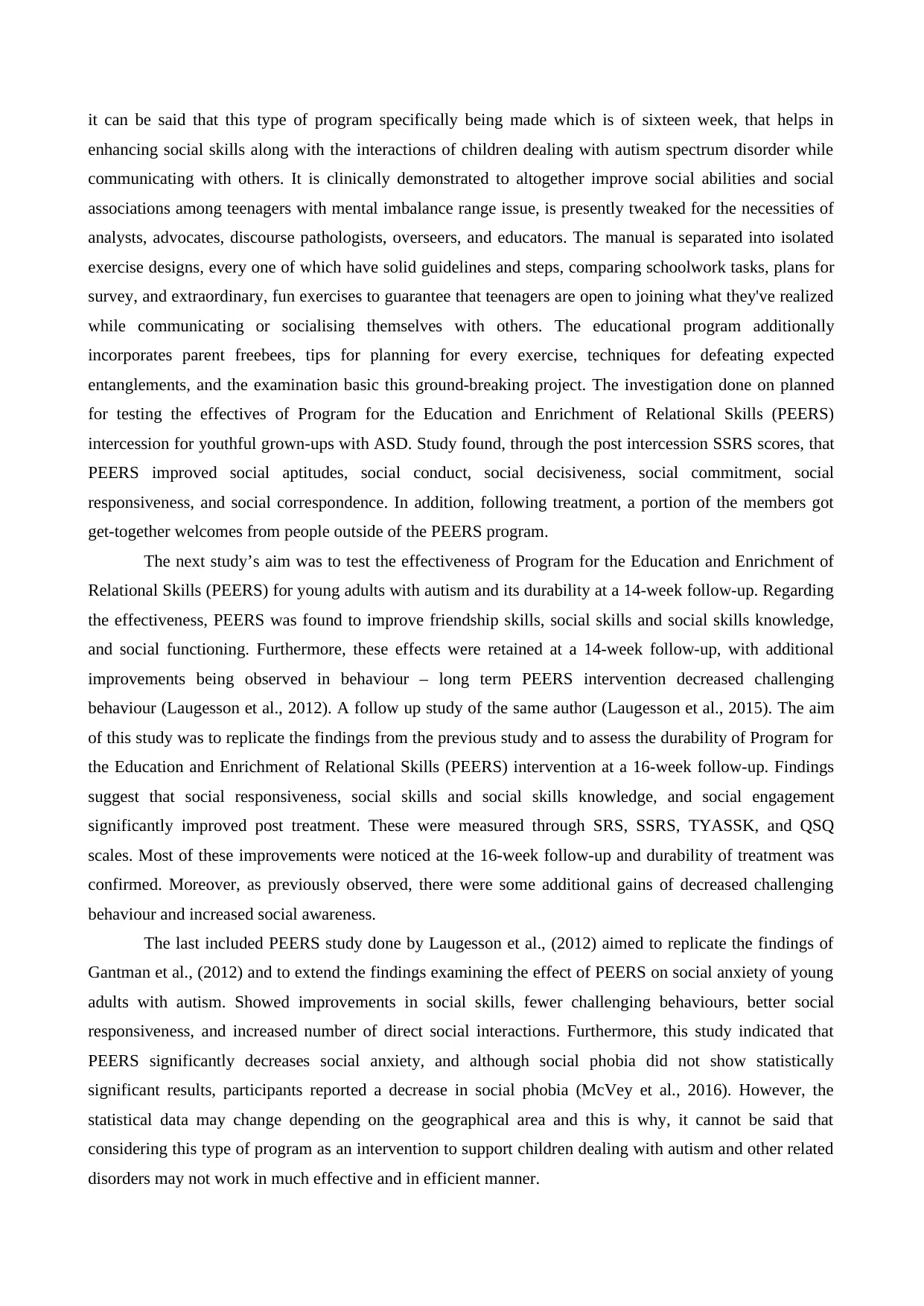
it can be said that this type of program specifically being made which is of sixteen week, that helps in
enhancing social skills along with the interactions of children dealing with autism spectrum disorder while
communicating with others. It is clinically demonstrated to altogether improve social abilities and social
associations among teenagers with mental imbalance range issue, is presently tweaked for the necessities of
analysts, advocates, discourse pathologists, overseers, and educators. The manual is separated into isolated
exercise designs, every one of which have solid guidelines and steps, comparing schoolwork tasks, plans for
survey, and extraordinary, fun exercises to guarantee that teenagers are open to joining what they've realized
while communicating or socialising themselves with others. The educational program additionally
incorporates parent freebees, tips for planning for every exercise, techniques for defeating expected
entanglements, and the examination basic this ground-breaking project. The investigation done on planned
for testing the effectives of Program for the Education and Enrichment of Relational Skills (PEERS)
intercession for youthful grown-ups with ASD. Study found, through the post intercession SSRS scores, that
PEERS improved social aptitudes, social conduct, social decisiveness, social commitment, social
responsiveness, and social correspondence. In addition, following treatment, a portion of the members got
get-together welcomes from people outside of the PEERS program.
The next study’s aim was to test the effectiveness of Program for the Education and Enrichment of
Relational Skills (PEERS) for young adults with autism and its durability at a 14-week follow-up. Regarding
the effectiveness, PEERS was found to improve friendship skills, social skills and social skills knowledge,
and social functioning. Furthermore, these effects were retained at a 14-week follow-up, with additional
improvements being observed in behaviour – long term PEERS intervention decreased challenging
behaviour (Laugesson et al., 2012). A follow up study of the same author (Laugesson et al., 2015). The aim
of this study was to replicate the findings from the previous study and to assess the durability of Program for
the Education and Enrichment of Relational Skills (PEERS) intervention at a 16-week follow-up. Findings
suggest that social responsiveness, social skills and social skills knowledge, and social engagement
significantly improved post treatment. These were measured through SRS, SSRS, TYASSK, and QSQ
scales. Most of these improvements were noticed at the 16-week follow-up and durability of treatment was
confirmed. Moreover, as previously observed, there were some additional gains of decreased challenging
behaviour and increased social awareness.
The last included PEERS study done by Laugesson et al., (2012) aimed to replicate the findings of
Gantman et al., (2012) and to extend the findings examining the effect of PEERS on social anxiety of young
adults with autism. Showed improvements in social skills, fewer challenging behaviours, better social
responsiveness, and increased number of direct social interactions. Furthermore, this study indicated that
PEERS significantly decreases social anxiety, and although social phobia did not show statistically
significant results, participants reported a decrease in social phobia (McVey et al., 2016). However, the
statistical data may change depending on the geographical area and this is why, it cannot be said that
considering this type of program as an intervention to support children dealing with autism and other related
disorders may not work in much effective and in efficient manner.
enhancing social skills along with the interactions of children dealing with autism spectrum disorder while
communicating with others. It is clinically demonstrated to altogether improve social abilities and social
associations among teenagers with mental imbalance range issue, is presently tweaked for the necessities of
analysts, advocates, discourse pathologists, overseers, and educators. The manual is separated into isolated
exercise designs, every one of which have solid guidelines and steps, comparing schoolwork tasks, plans for
survey, and extraordinary, fun exercises to guarantee that teenagers are open to joining what they've realized
while communicating or socialising themselves with others. The educational program additionally
incorporates parent freebees, tips for planning for every exercise, techniques for defeating expected
entanglements, and the examination basic this ground-breaking project. The investigation done on planned
for testing the effectives of Program for the Education and Enrichment of Relational Skills (PEERS)
intercession for youthful grown-ups with ASD. Study found, through the post intercession SSRS scores, that
PEERS improved social aptitudes, social conduct, social decisiveness, social commitment, social
responsiveness, and social correspondence. In addition, following treatment, a portion of the members got
get-together welcomes from people outside of the PEERS program.
The next study’s aim was to test the effectiveness of Program for the Education and Enrichment of
Relational Skills (PEERS) for young adults with autism and its durability at a 14-week follow-up. Regarding
the effectiveness, PEERS was found to improve friendship skills, social skills and social skills knowledge,
and social functioning. Furthermore, these effects were retained at a 14-week follow-up, with additional
improvements being observed in behaviour – long term PEERS intervention decreased challenging
behaviour (Laugesson et al., 2012). A follow up study of the same author (Laugesson et al., 2015). The aim
of this study was to replicate the findings from the previous study and to assess the durability of Program for
the Education and Enrichment of Relational Skills (PEERS) intervention at a 16-week follow-up. Findings
suggest that social responsiveness, social skills and social skills knowledge, and social engagement
significantly improved post treatment. These were measured through SRS, SSRS, TYASSK, and QSQ
scales. Most of these improvements were noticed at the 16-week follow-up and durability of treatment was
confirmed. Moreover, as previously observed, there were some additional gains of decreased challenging
behaviour and increased social awareness.
The last included PEERS study done by Laugesson et al., (2012) aimed to replicate the findings of
Gantman et al., (2012) and to extend the findings examining the effect of PEERS on social anxiety of young
adults with autism. Showed improvements in social skills, fewer challenging behaviours, better social
responsiveness, and increased number of direct social interactions. Furthermore, this study indicated that
PEERS significantly decreases social anxiety, and although social phobia did not show statistically
significant results, participants reported a decrease in social phobia (McVey et al., 2016). However, the
statistical data may change depending on the geographical area and this is why, it cannot be said that
considering this type of program as an intervention to support children dealing with autism and other related
disorders may not work in much effective and in efficient manner.
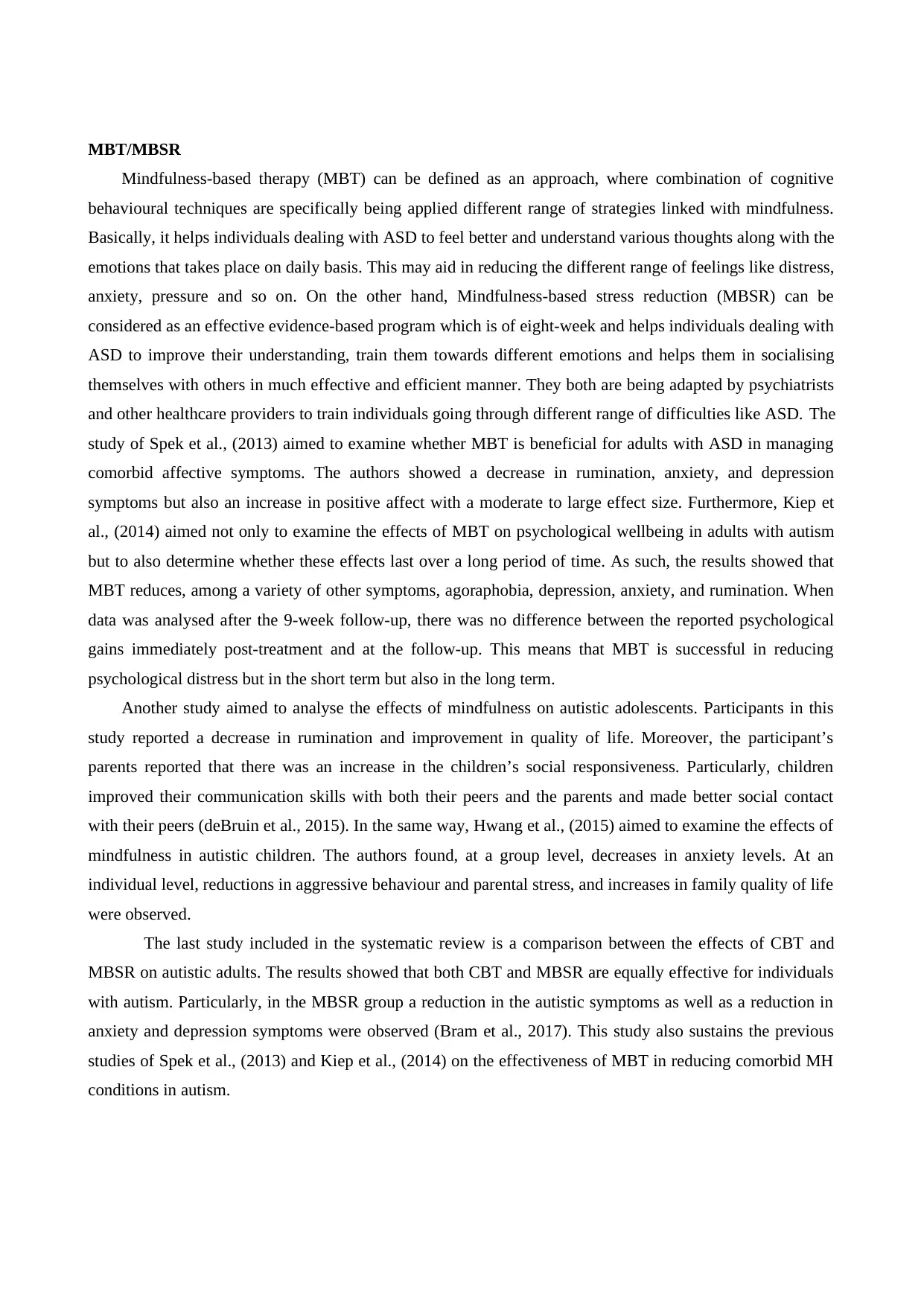
MBT/MBSR
Mindfulness-based therapy (MBT) can be defined as an approach, where combination of cognitive
behavioural techniques are specifically being applied different range of strategies linked with mindfulness.
Basically, it helps individuals dealing with ASD to feel better and understand various thoughts along with the
emotions that takes place on daily basis. This may aid in reducing the different range of feelings like distress,
anxiety, pressure and so on. On the other hand, Mindfulness-based stress reduction (MBSR) can be
considered as an effective evidence-based program which is of eight-week and helps individuals dealing with
ASD to improve their understanding, train them towards different emotions and helps them in socialising
themselves with others in much effective and efficient manner. They both are being adapted by psychiatrists
and other healthcare providers to train individuals going through different range of difficulties like ASD. The
study of Spek et al., (2013) aimed to examine whether MBT is beneficial for adults with ASD in managing
comorbid affective symptoms. The authors showed a decrease in rumination, anxiety, and depression
symptoms but also an increase in positive affect with a moderate to large effect size. Furthermore, Kiep et
al., (2014) aimed not only to examine the effects of MBT on psychological wellbeing in adults with autism
but to also determine whether these effects last over a long period of time. As such, the results showed that
MBT reduces, among a variety of other symptoms, agoraphobia, depression, anxiety, and rumination. When
data was analysed after the 9-week follow-up, there was no difference between the reported psychological
gains immediately post-treatment and at the follow-up. This means that MBT is successful in reducing
psychological distress but in the short term but also in the long term.
Another study aimed to analyse the effects of mindfulness on autistic adolescents. Participants in this
study reported a decrease in rumination and improvement in quality of life. Moreover, the participant’s
parents reported that there was an increase in the children’s social responsiveness. Particularly, children
improved their communication skills with both their peers and the parents and made better social contact
with their peers (deBruin et al., 2015). In the same way, Hwang et al., (2015) aimed to examine the effects of
mindfulness in autistic children. The authors found, at a group level, decreases in anxiety levels. At an
individual level, reductions in aggressive behaviour and parental stress, and increases in family quality of life
were observed.
The last study included in the systematic review is a comparison between the effects of CBT and
MBSR on autistic adults. The results showed that both CBT and MBSR are equally effective for individuals
with autism. Particularly, in the MBSR group a reduction in the autistic symptoms as well as a reduction in
anxiety and depression symptoms were observed (Bram et al., 2017). This study also sustains the previous
studies of Spek et al., (2013) and Kiep et al., (2014) on the effectiveness of MBT in reducing comorbid MH
conditions in autism.
Mindfulness-based therapy (MBT) can be defined as an approach, where combination of cognitive
behavioural techniques are specifically being applied different range of strategies linked with mindfulness.
Basically, it helps individuals dealing with ASD to feel better and understand various thoughts along with the
emotions that takes place on daily basis. This may aid in reducing the different range of feelings like distress,
anxiety, pressure and so on. On the other hand, Mindfulness-based stress reduction (MBSR) can be
considered as an effective evidence-based program which is of eight-week and helps individuals dealing with
ASD to improve their understanding, train them towards different emotions and helps them in socialising
themselves with others in much effective and efficient manner. They both are being adapted by psychiatrists
and other healthcare providers to train individuals going through different range of difficulties like ASD. The
study of Spek et al., (2013) aimed to examine whether MBT is beneficial for adults with ASD in managing
comorbid affective symptoms. The authors showed a decrease in rumination, anxiety, and depression
symptoms but also an increase in positive affect with a moderate to large effect size. Furthermore, Kiep et
al., (2014) aimed not only to examine the effects of MBT on psychological wellbeing in adults with autism
but to also determine whether these effects last over a long period of time. As such, the results showed that
MBT reduces, among a variety of other symptoms, agoraphobia, depression, anxiety, and rumination. When
data was analysed after the 9-week follow-up, there was no difference between the reported psychological
gains immediately post-treatment and at the follow-up. This means that MBT is successful in reducing
psychological distress but in the short term but also in the long term.
Another study aimed to analyse the effects of mindfulness on autistic adolescents. Participants in this
study reported a decrease in rumination and improvement in quality of life. Moreover, the participant’s
parents reported that there was an increase in the children’s social responsiveness. Particularly, children
improved their communication skills with both their peers and the parents and made better social contact
with their peers (deBruin et al., 2015). In the same way, Hwang et al., (2015) aimed to examine the effects of
mindfulness in autistic children. The authors found, at a group level, decreases in anxiety levels. At an
individual level, reductions in aggressive behaviour and parental stress, and increases in family quality of life
were observed.
The last study included in the systematic review is a comparison between the effects of CBT and
MBSR on autistic adults. The results showed that both CBT and MBSR are equally effective for individuals
with autism. Particularly, in the MBSR group a reduction in the autistic symptoms as well as a reduction in
anxiety and depression symptoms were observed (Bram et al., 2017). This study also sustains the previous
studies of Spek et al., (2013) and Kiep et al., (2014) on the effectiveness of MBT in reducing comorbid MH
conditions in autism.
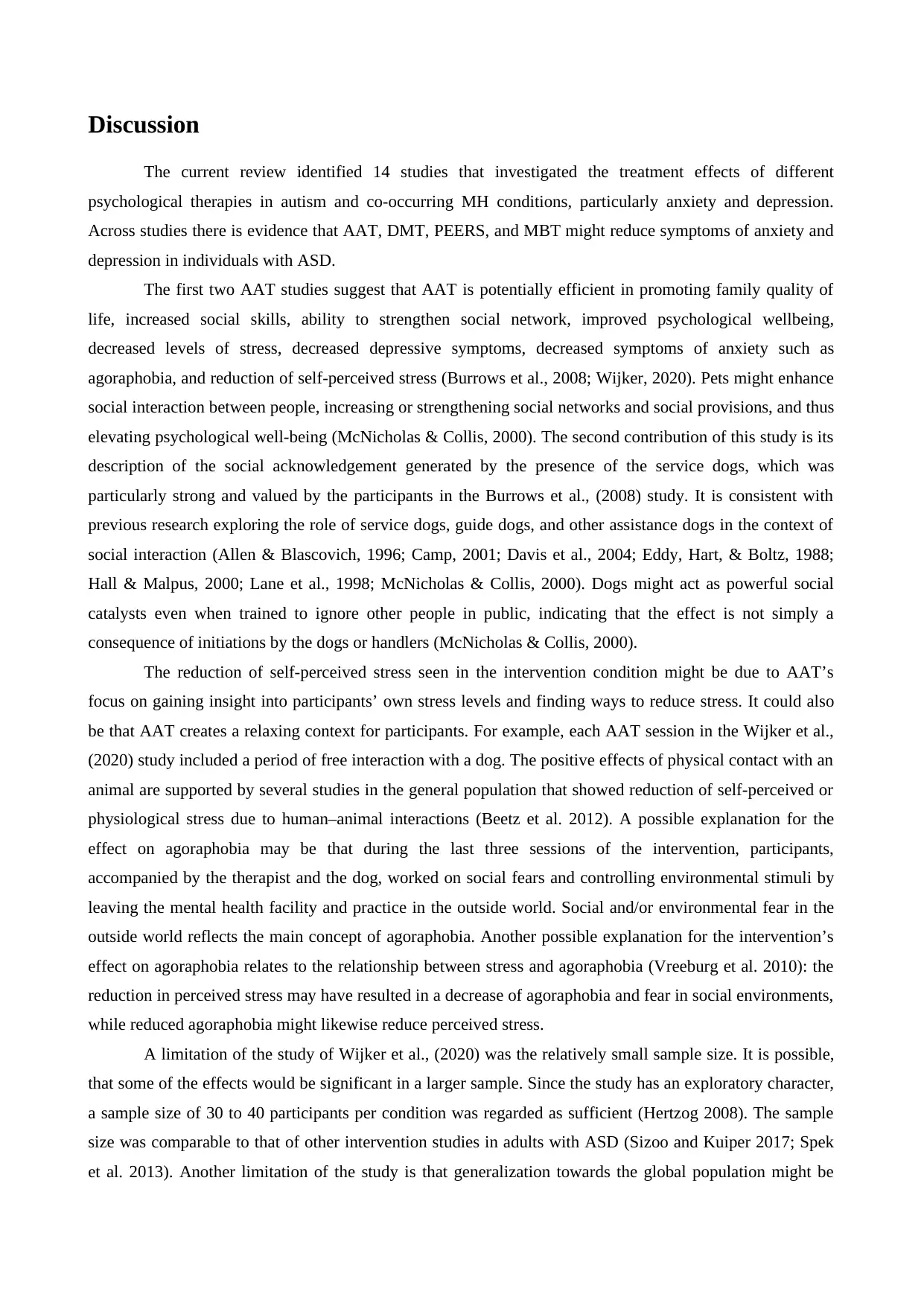
Discussion
The current review identified 14 studies that investigated the treatment effects of different
psychological therapies in autism and co-occurring MH conditions, particularly anxiety and depression.
Across studies there is evidence that AAT, DMT, PEERS, and MBT might reduce symptoms of anxiety and
depression in individuals with ASD.
The first two AAT studies suggest that AAT is potentially efficient in promoting family quality of
life, increased social skills, ability to strengthen social network, improved psychological wellbeing,
decreased levels of stress, decreased depressive symptoms, decreased symptoms of anxiety such as
agoraphobia, and reduction of self-perceived stress (Burrows et al., 2008; Wijker, 2020). Pets might enhance
social interaction between people, increasing or strengthening social networks and social provisions, and thus
elevating psychological well-being (McNicholas & Collis, 2000). The second contribution of this study is its
description of the social acknowledgement generated by the presence of the service dogs, which was
particularly strong and valued by the participants in the Burrows et al., (2008) study. It is consistent with
previous research exploring the role of service dogs, guide dogs, and other assistance dogs in the context of
social interaction (Allen & Blascovich, 1996; Camp, 2001; Davis et al., 2004; Eddy, Hart, & Boltz, 1988;
Hall & Malpus, 2000; Lane et al., 1998; McNicholas & Collis, 2000). Dogs might act as powerful social
catalysts even when trained to ignore other people in public, indicating that the effect is not simply a
consequence of initiations by the dogs or handlers (McNicholas & Collis, 2000).
The reduction of self-perceived stress seen in the intervention condition might be due to AAT’s
focus on gaining insight into participants’ own stress levels and finding ways to reduce stress. It could also
be that AAT creates a relaxing context for participants. For example, each AAT session in the Wijker et al.,
(2020) study included a period of free interaction with a dog. The positive effects of physical contact with an
animal are supported by several studies in the general population that showed reduction of self-perceived or
physiological stress due to human–animal interactions (Beetz et al. 2012). A possible explanation for the
effect on agoraphobia may be that during the last three sessions of the intervention, participants,
accompanied by the therapist and the dog, worked on social fears and controlling environmental stimuli by
leaving the mental health facility and practice in the outside world. Social and/or environmental fear in the
outside world reflects the main concept of agoraphobia. Another possible explanation for the intervention’s
effect on agoraphobia relates to the relationship between stress and agoraphobia (Vreeburg et al. 2010): the
reduction in perceived stress may have resulted in a decrease of agoraphobia and fear in social environments,
while reduced agoraphobia might likewise reduce perceived stress.
A limitation of the study of Wijker et al., (2020) was the relatively small sample size. It is possible,
that some of the effects would be significant in a larger sample. Since the study has an exploratory character,
a sample size of 30 to 40 participants per condition was regarded as sufficient (Hertzog 2008). The sample
size was comparable to that of other intervention studies in adults with ASD (Sizoo and Kuiper 2017; Spek
et al. 2013). Another limitation of the study is that generalization towards the global population might be
The current review identified 14 studies that investigated the treatment effects of different
psychological therapies in autism and co-occurring MH conditions, particularly anxiety and depression.
Across studies there is evidence that AAT, DMT, PEERS, and MBT might reduce symptoms of anxiety and
depression in individuals with ASD.
The first two AAT studies suggest that AAT is potentially efficient in promoting family quality of
life, increased social skills, ability to strengthen social network, improved psychological wellbeing,
decreased levels of stress, decreased depressive symptoms, decreased symptoms of anxiety such as
agoraphobia, and reduction of self-perceived stress (Burrows et al., 2008; Wijker, 2020). Pets might enhance
social interaction between people, increasing or strengthening social networks and social provisions, and thus
elevating psychological well-being (McNicholas & Collis, 2000). The second contribution of this study is its
description of the social acknowledgement generated by the presence of the service dogs, which was
particularly strong and valued by the participants in the Burrows et al., (2008) study. It is consistent with
previous research exploring the role of service dogs, guide dogs, and other assistance dogs in the context of
social interaction (Allen & Blascovich, 1996; Camp, 2001; Davis et al., 2004; Eddy, Hart, & Boltz, 1988;
Hall & Malpus, 2000; Lane et al., 1998; McNicholas & Collis, 2000). Dogs might act as powerful social
catalysts even when trained to ignore other people in public, indicating that the effect is not simply a
consequence of initiations by the dogs or handlers (McNicholas & Collis, 2000).
The reduction of self-perceived stress seen in the intervention condition might be due to AAT’s
focus on gaining insight into participants’ own stress levels and finding ways to reduce stress. It could also
be that AAT creates a relaxing context for participants. For example, each AAT session in the Wijker et al.,
(2020) study included a period of free interaction with a dog. The positive effects of physical contact with an
animal are supported by several studies in the general population that showed reduction of self-perceived or
physiological stress due to human–animal interactions (Beetz et al. 2012). A possible explanation for the
effect on agoraphobia may be that during the last three sessions of the intervention, participants,
accompanied by the therapist and the dog, worked on social fears and controlling environmental stimuli by
leaving the mental health facility and practice in the outside world. Social and/or environmental fear in the
outside world reflects the main concept of agoraphobia. Another possible explanation for the intervention’s
effect on agoraphobia relates to the relationship between stress and agoraphobia (Vreeburg et al. 2010): the
reduction in perceived stress may have resulted in a decrease of agoraphobia and fear in social environments,
while reduced agoraphobia might likewise reduce perceived stress.
A limitation of the study of Wijker et al., (2020) was the relatively small sample size. It is possible,
that some of the effects would be significant in a larger sample. Since the study has an exploratory character,
a sample size of 30 to 40 participants per condition was regarded as sufficient (Hertzog 2008). The sample
size was comparable to that of other intervention studies in adults with ASD (Sizoo and Kuiper 2017; Spek
et al. 2013). Another limitation of the study is that generalization towards the global population might be
Paraphrase This Document
Need a fresh take? Get an instant paraphrase of this document with our AI Paraphraser
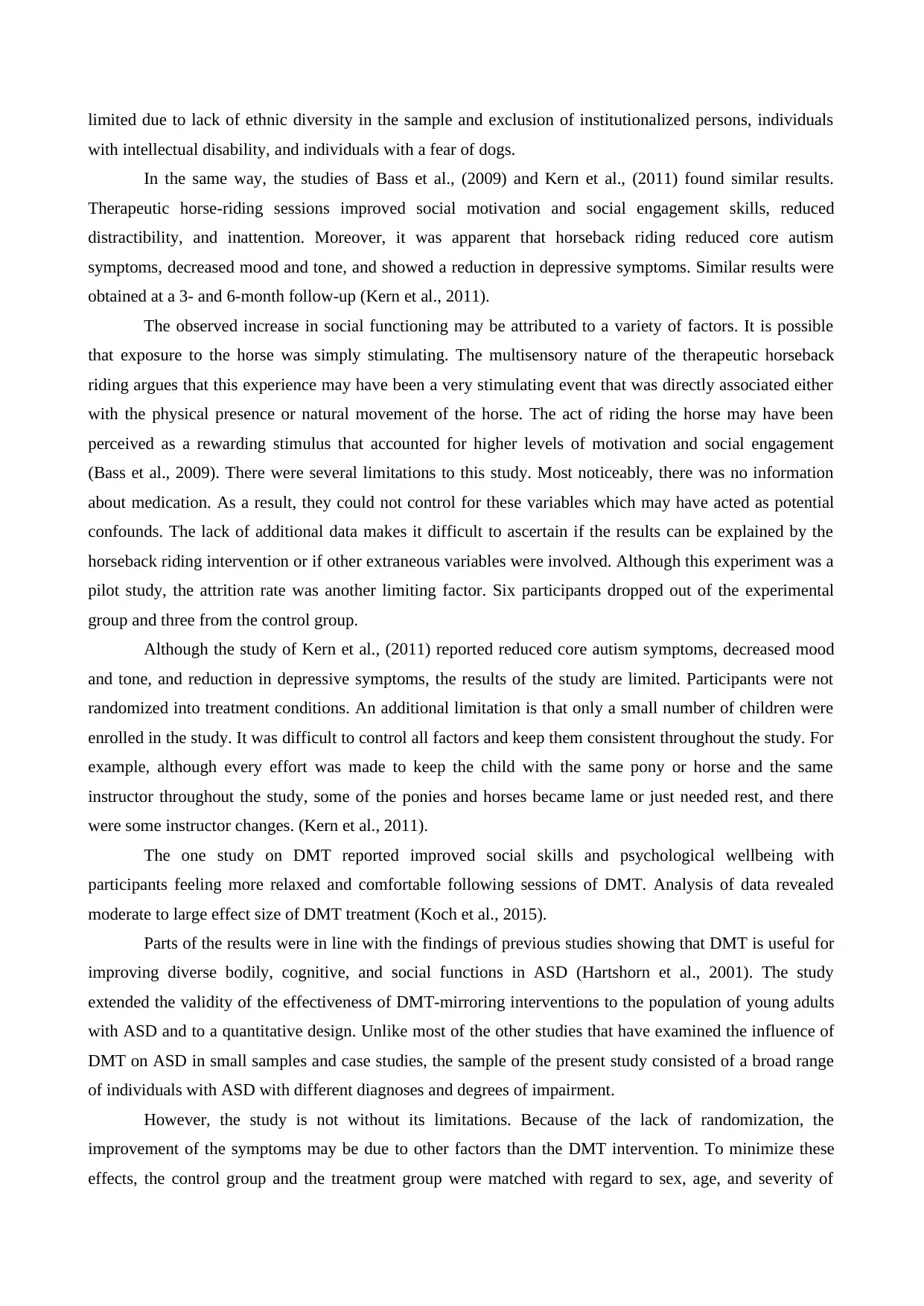
limited due to lack of ethnic diversity in the sample and exclusion of institutionalized persons, individuals
with intellectual disability, and individuals with a fear of dogs.
In the same way, the studies of Bass et al., (2009) and Kern et al., (2011) found similar results.
Therapeutic horse-riding sessions improved social motivation and social engagement skills, reduced
distractibility, and inattention. Moreover, it was apparent that horseback riding reduced core autism
symptoms, decreased mood and tone, and showed a reduction in depressive symptoms. Similar results were
obtained at a 3- and 6-month follow-up (Kern et al., 2011).
The observed increase in social functioning may be attributed to a variety of factors. It is possible
that exposure to the horse was simply stimulating. The multisensory nature of the therapeutic horseback
riding argues that this experience may have been a very stimulating event that was directly associated either
with the physical presence or natural movement of the horse. The act of riding the horse may have been
perceived as a rewarding stimulus that accounted for higher levels of motivation and social engagement
(Bass et al., 2009). There were several limitations to this study. Most noticeably, there was no information
about medication. As a result, they could not control for these variables which may have acted as potential
confounds. The lack of additional data makes it difficult to ascertain if the results can be explained by the
horseback riding intervention or if other extraneous variables were involved. Although this experiment was a
pilot study, the attrition rate was another limiting factor. Six participants dropped out of the experimental
group and three from the control group.
Although the study of Kern et al., (2011) reported reduced core autism symptoms, decreased mood
and tone, and reduction in depressive symptoms, the results of the study are limited. Participants were not
randomized into treatment conditions. An additional limitation is that only a small number of children were
enrolled in the study. It was difficult to control all factors and keep them consistent throughout the study. For
example, although every effort was made to keep the child with the same pony or horse and the same
instructor throughout the study, some of the ponies and horses became lame or just needed rest, and there
were some instructor changes. (Kern et al., 2011).
The one study on DMT reported improved social skills and psychological wellbeing with
participants feeling more relaxed and comfortable following sessions of DMT. Analysis of data revealed
moderate to large effect size of DMT treatment (Koch et al., 2015).
Parts of the results were in line with the findings of previous studies showing that DMT is useful for
improving diverse bodily, cognitive, and social functions in ASD (Hartshorn et al., 2001). The study
extended the validity of the effectiveness of DMT-mirroring interventions to the population of young adults
with ASD and to a quantitative design. Unlike most of the other studies that have examined the influence of
DMT on ASD in small samples and case studies, the sample of the present study consisted of a broad range
of individuals with ASD with different diagnoses and degrees of impairment.
However, the study is not without its limitations. Because of the lack of randomization, the
improvement of the symptoms may be due to other factors than the DMT intervention. To minimize these
effects, the control group and the treatment group were matched with regard to sex, age, and severity of
with intellectual disability, and individuals with a fear of dogs.
In the same way, the studies of Bass et al., (2009) and Kern et al., (2011) found similar results.
Therapeutic horse-riding sessions improved social motivation and social engagement skills, reduced
distractibility, and inattention. Moreover, it was apparent that horseback riding reduced core autism
symptoms, decreased mood and tone, and showed a reduction in depressive symptoms. Similar results were
obtained at a 3- and 6-month follow-up (Kern et al., 2011).
The observed increase in social functioning may be attributed to a variety of factors. It is possible
that exposure to the horse was simply stimulating. The multisensory nature of the therapeutic horseback
riding argues that this experience may have been a very stimulating event that was directly associated either
with the physical presence or natural movement of the horse. The act of riding the horse may have been
perceived as a rewarding stimulus that accounted for higher levels of motivation and social engagement
(Bass et al., 2009). There were several limitations to this study. Most noticeably, there was no information
about medication. As a result, they could not control for these variables which may have acted as potential
confounds. The lack of additional data makes it difficult to ascertain if the results can be explained by the
horseback riding intervention or if other extraneous variables were involved. Although this experiment was a
pilot study, the attrition rate was another limiting factor. Six participants dropped out of the experimental
group and three from the control group.
Although the study of Kern et al., (2011) reported reduced core autism symptoms, decreased mood
and tone, and reduction in depressive symptoms, the results of the study are limited. Participants were not
randomized into treatment conditions. An additional limitation is that only a small number of children were
enrolled in the study. It was difficult to control all factors and keep them consistent throughout the study. For
example, although every effort was made to keep the child with the same pony or horse and the same
instructor throughout the study, some of the ponies and horses became lame or just needed rest, and there
were some instructor changes. (Kern et al., 2011).
The one study on DMT reported improved social skills and psychological wellbeing with
participants feeling more relaxed and comfortable following sessions of DMT. Analysis of data revealed
moderate to large effect size of DMT treatment (Koch et al., 2015).
Parts of the results were in line with the findings of previous studies showing that DMT is useful for
improving diverse bodily, cognitive, and social functions in ASD (Hartshorn et al., 2001). The study
extended the validity of the effectiveness of DMT-mirroring interventions to the population of young adults
with ASD and to a quantitative design. Unlike most of the other studies that have examined the influence of
DMT on ASD in small samples and case studies, the sample of the present study consisted of a broad range
of individuals with ASD with different diagnoses and degrees of impairment.
However, the study is not without its limitations. Because of the lack of randomization, the
improvement of the symptoms may be due to other factors than the DMT intervention. To minimize these
effects, the control group and the treatment group were matched with regard to sex, age, and severity of
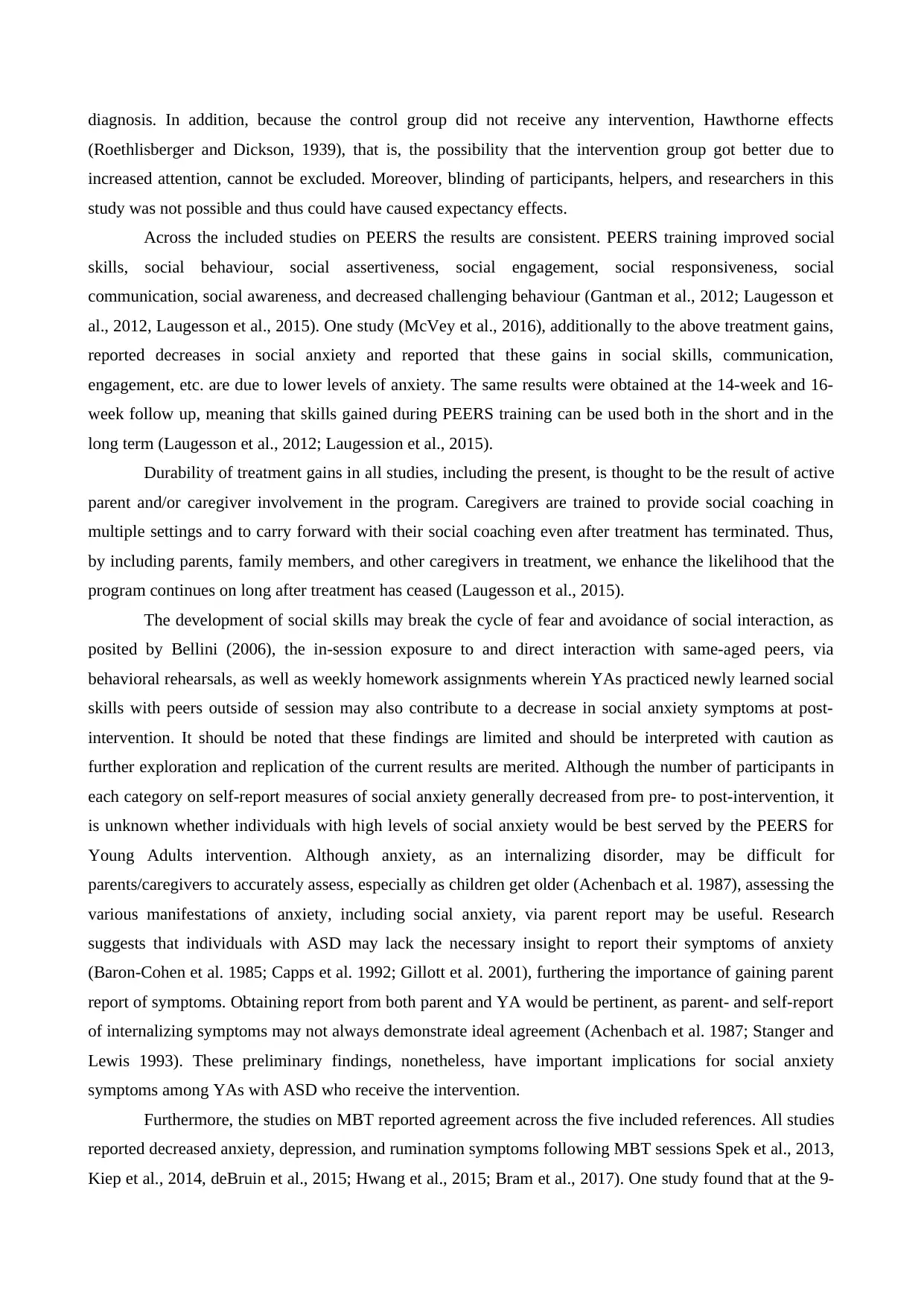
diagnosis. In addition, because the control group did not receive any intervention, Hawthorne effects
(Roethlisberger and Dickson, 1939), that is, the possibility that the intervention group got better due to
increased attention, cannot be excluded. Moreover, blinding of participants, helpers, and researchers in this
study was not possible and thus could have caused expectancy effects.
Across the included studies on PEERS the results are consistent. PEERS training improved social
skills, social behaviour, social assertiveness, social engagement, social responsiveness, social
communication, social awareness, and decreased challenging behaviour (Gantman et al., 2012; Laugesson et
al., 2012, Laugesson et al., 2015). One study (McVey et al., 2016), additionally to the above treatment gains,
reported decreases in social anxiety and reported that these gains in social skills, communication,
engagement, etc. are due to lower levels of anxiety. The same results were obtained at the 14-week and 16-
week follow up, meaning that skills gained during PEERS training can be used both in the short and in the
long term (Laugesson et al., 2012; Laugession et al., 2015).
Durability of treatment gains in all studies, including the present, is thought to be the result of active
parent and/or caregiver involvement in the program. Caregivers are trained to provide social coaching in
multiple settings and to carry forward with their social coaching even after treatment has terminated. Thus,
by including parents, family members, and other caregivers in treatment, we enhance the likelihood that the
program continues on long after treatment has ceased (Laugesson et al., 2015).
The development of social skills may break the cycle of fear and avoidance of social interaction, as
posited by Bellini (2006), the in-session exposure to and direct interaction with same-aged peers, via
behavioral rehearsals, as well as weekly homework assignments wherein YAs practiced newly learned social
skills with peers outside of session may also contribute to a decrease in social anxiety symptoms at post-
intervention. It should be noted that these findings are limited and should be interpreted with caution as
further exploration and replication of the current results are merited. Although the number of participants in
each category on self-report measures of social anxiety generally decreased from pre- to post-intervention, it
is unknown whether individuals with high levels of social anxiety would be best served by the PEERS for
Young Adults intervention. Although anxiety, as an internalizing disorder, may be difficult for
parents/caregivers to accurately assess, especially as children get older (Achenbach et al. 1987), assessing the
various manifestations of anxiety, including social anxiety, via parent report may be useful. Research
suggests that individuals with ASD may lack the necessary insight to report their symptoms of anxiety
(Baron-Cohen et al. 1985; Capps et al. 1992; Gillott et al. 2001), furthering the importance of gaining parent
report of symptoms. Obtaining report from both parent and YA would be pertinent, as parent- and self-report
of internalizing symptoms may not always demonstrate ideal agreement (Achenbach et al. 1987; Stanger and
Lewis 1993). These preliminary findings, nonetheless, have important implications for social anxiety
symptoms among YAs with ASD who receive the intervention.
Furthermore, the studies on MBT reported agreement across the five included references. All studies
reported decreased anxiety, depression, and rumination symptoms following MBT sessions Spek et al., 2013,
Kiep et al., 2014, deBruin et al., 2015; Hwang et al., 2015; Bram et al., 2017). One study found that at the 9-
(Roethlisberger and Dickson, 1939), that is, the possibility that the intervention group got better due to
increased attention, cannot be excluded. Moreover, blinding of participants, helpers, and researchers in this
study was not possible and thus could have caused expectancy effects.
Across the included studies on PEERS the results are consistent. PEERS training improved social
skills, social behaviour, social assertiveness, social engagement, social responsiveness, social
communication, social awareness, and decreased challenging behaviour (Gantman et al., 2012; Laugesson et
al., 2012, Laugesson et al., 2015). One study (McVey et al., 2016), additionally to the above treatment gains,
reported decreases in social anxiety and reported that these gains in social skills, communication,
engagement, etc. are due to lower levels of anxiety. The same results were obtained at the 14-week and 16-
week follow up, meaning that skills gained during PEERS training can be used both in the short and in the
long term (Laugesson et al., 2012; Laugession et al., 2015).
Durability of treatment gains in all studies, including the present, is thought to be the result of active
parent and/or caregiver involvement in the program. Caregivers are trained to provide social coaching in
multiple settings and to carry forward with their social coaching even after treatment has terminated. Thus,
by including parents, family members, and other caregivers in treatment, we enhance the likelihood that the
program continues on long after treatment has ceased (Laugesson et al., 2015).
The development of social skills may break the cycle of fear and avoidance of social interaction, as
posited by Bellini (2006), the in-session exposure to and direct interaction with same-aged peers, via
behavioral rehearsals, as well as weekly homework assignments wherein YAs practiced newly learned social
skills with peers outside of session may also contribute to a decrease in social anxiety symptoms at post-
intervention. It should be noted that these findings are limited and should be interpreted with caution as
further exploration and replication of the current results are merited. Although the number of participants in
each category on self-report measures of social anxiety generally decreased from pre- to post-intervention, it
is unknown whether individuals with high levels of social anxiety would be best served by the PEERS for
Young Adults intervention. Although anxiety, as an internalizing disorder, may be difficult for
parents/caregivers to accurately assess, especially as children get older (Achenbach et al. 1987), assessing the
various manifestations of anxiety, including social anxiety, via parent report may be useful. Research
suggests that individuals with ASD may lack the necessary insight to report their symptoms of anxiety
(Baron-Cohen et al. 1985; Capps et al. 1992; Gillott et al. 2001), furthering the importance of gaining parent
report of symptoms. Obtaining report from both parent and YA would be pertinent, as parent- and self-report
of internalizing symptoms may not always demonstrate ideal agreement (Achenbach et al. 1987; Stanger and
Lewis 1993). These preliminary findings, nonetheless, have important implications for social anxiety
symptoms among YAs with ASD who receive the intervention.
Furthermore, the studies on MBT reported agreement across the five included references. All studies
reported decreased anxiety, depression, and rumination symptoms following MBT sessions Spek et al., 2013,
Kiep et al., 2014, deBruin et al., 2015; Hwang et al., 2015; Bram et al., 2017). One study found that at the 9-
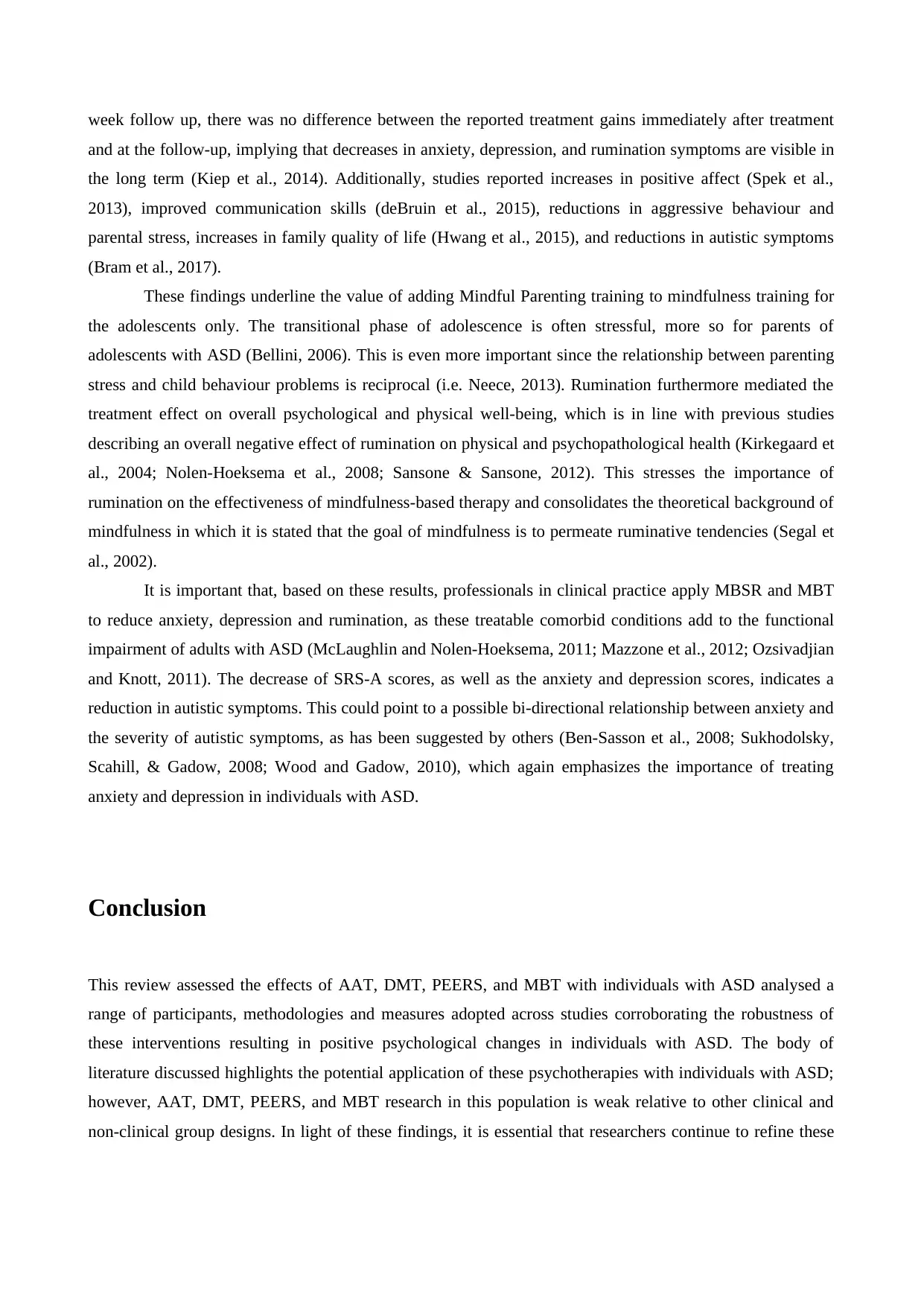
week follow up, there was no difference between the reported treatment gains immediately after treatment
and at the follow-up, implying that decreases in anxiety, depression, and rumination symptoms are visible in
the long term (Kiep et al., 2014). Additionally, studies reported increases in positive affect (Spek et al.,
2013), improved communication skills (deBruin et al., 2015), reductions in aggressive behaviour and
parental stress, increases in family quality of life (Hwang et al., 2015), and reductions in autistic symptoms
(Bram et al., 2017).
These findings underline the value of adding Mindful Parenting training to mindfulness training for
the adolescents only. The transitional phase of adolescence is often stressful, more so for parents of
adolescents with ASD (Bellini, 2006). This is even more important since the relationship between parenting
stress and child behaviour problems is reciprocal (i.e. Neece, 2013). Rumination furthermore mediated the
treatment effect on overall psychological and physical well-being, which is in line with previous studies
describing an overall negative effect of rumination on physical and psychopathological health (Kirkegaard et
al., 2004; Nolen-Hoeksema et al., 2008; Sansone & Sansone, 2012). This stresses the importance of
rumination on the effectiveness of mindfulness-based therapy and consolidates the theoretical background of
mindfulness in which it is stated that the goal of mindfulness is to permeate ruminative tendencies (Segal et
al., 2002).
It is important that, based on these results, professionals in clinical practice apply MBSR and MBT
to reduce anxiety, depression and rumination, as these treatable comorbid conditions add to the functional
impairment of adults with ASD (McLaughlin and Nolen-Hoeksema, 2011; Mazzone et al., 2012; Ozsivadjian
and Knott, 2011). The decrease of SRS-A scores, as well as the anxiety and depression scores, indicates a
reduction in autistic symptoms. This could point to a possible bi-directional relationship between anxiety and
the severity of autistic symptoms, as has been suggested by others (Ben-Sasson et al., 2008; Sukhodolsky,
Scahill, & Gadow, 2008; Wood and Gadow, 2010), which again emphasizes the importance of treating
anxiety and depression in individuals with ASD.
Conclusion
This review assessed the effects of AAT, DMT, PEERS, and MBT with individuals with ASD analysed a
range of participants, methodologies and measures adopted across studies corroborating the robustness of
these interventions resulting in positive psychological changes in individuals with ASD. The body of
literature discussed highlights the potential application of these psychotherapies with individuals with ASD;
however, AAT, DMT, PEERS, and MBT research in this population is weak relative to other clinical and
non-clinical group designs. In light of these findings, it is essential that researchers continue to refine these
and at the follow-up, implying that decreases in anxiety, depression, and rumination symptoms are visible in
the long term (Kiep et al., 2014). Additionally, studies reported increases in positive affect (Spek et al.,
2013), improved communication skills (deBruin et al., 2015), reductions in aggressive behaviour and
parental stress, increases in family quality of life (Hwang et al., 2015), and reductions in autistic symptoms
(Bram et al., 2017).
These findings underline the value of adding Mindful Parenting training to mindfulness training for
the adolescents only. The transitional phase of adolescence is often stressful, more so for parents of
adolescents with ASD (Bellini, 2006). This is even more important since the relationship between parenting
stress and child behaviour problems is reciprocal (i.e. Neece, 2013). Rumination furthermore mediated the
treatment effect on overall psychological and physical well-being, which is in line with previous studies
describing an overall negative effect of rumination on physical and psychopathological health (Kirkegaard et
al., 2004; Nolen-Hoeksema et al., 2008; Sansone & Sansone, 2012). This stresses the importance of
rumination on the effectiveness of mindfulness-based therapy and consolidates the theoretical background of
mindfulness in which it is stated that the goal of mindfulness is to permeate ruminative tendencies (Segal et
al., 2002).
It is important that, based on these results, professionals in clinical practice apply MBSR and MBT
to reduce anxiety, depression and rumination, as these treatable comorbid conditions add to the functional
impairment of adults with ASD (McLaughlin and Nolen-Hoeksema, 2011; Mazzone et al., 2012; Ozsivadjian
and Knott, 2011). The decrease of SRS-A scores, as well as the anxiety and depression scores, indicates a
reduction in autistic symptoms. This could point to a possible bi-directional relationship between anxiety and
the severity of autistic symptoms, as has been suggested by others (Ben-Sasson et al., 2008; Sukhodolsky,
Scahill, & Gadow, 2008; Wood and Gadow, 2010), which again emphasizes the importance of treating
anxiety and depression in individuals with ASD.
Conclusion
This review assessed the effects of AAT, DMT, PEERS, and MBT with individuals with ASD analysed a
range of participants, methodologies and measures adopted across studies corroborating the robustness of
these interventions resulting in positive psychological changes in individuals with ASD. The body of
literature discussed highlights the potential application of these psychotherapies with individuals with ASD;
however, AAT, DMT, PEERS, and MBT research in this population is weak relative to other clinical and
non-clinical group designs. In light of these findings, it is essential that researchers continue to refine these
Secure Best Marks with AI Grader
Need help grading? Try our AI Grader for instant feedback on your assignments.

intervention procedures and their evaluation, aimed at maximising the efficacy of current interventions
available for individuals with ASD.
available for individuals with ASD.
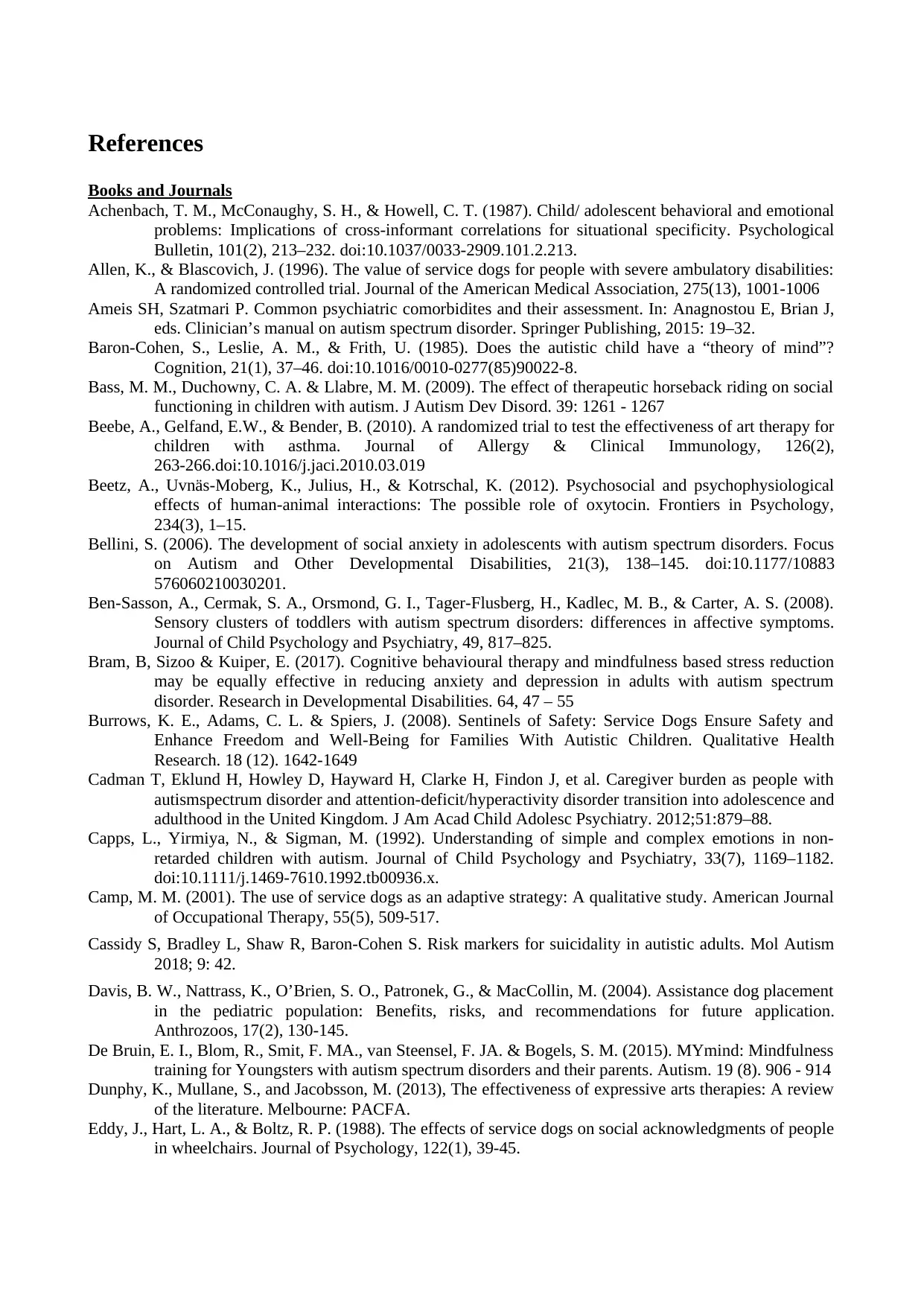
References
Books and Journals
Achenbach, T. M., McConaughy, S. H., & Howell, C. T. (1987). Child/ adolescent behavioral and emotional
problems: Implications of cross-informant correlations for situational specificity. Psychological
Bulletin, 101(2), 213–232. doi:10.1037/0033-2909.101.2.213.
Allen, K., & Blascovich, J. (1996). The value of service dogs for people with severe ambulatory disabilities:
A randomized controlled trial. Journal of the American Medical Association, 275(13), 1001-1006
Ameis SH, Szatmari P. Common psychiatric comorbidites and their assessment. In: Anagnostou E, Brian J,
eds. Clinician’s manual on autism spectrum disorder. Springer Publishing, 2015: 19–32.
Baron-Cohen, S., Leslie, A. M., & Frith, U. (1985). Does the autistic child have a “theory of mind”?
Cognition, 21(1), 37–46. doi:10.1016/0010-0277(85)90022-8.
Bass, M. M., Duchowny, C. A. & Llabre, M. M. (2009). The effect of therapeutic horseback riding on social
functioning in children with autism. J Autism Dev Disord. 39: 1261 - 1267
Beebe, A., Gelfand, E.W., & Bender, B. (2010). A randomized trial to test the effectiveness of art therapy for
children with asthma. Journal of Allergy & Clinical Immunology, 126(2),
263-266.doi:10.1016/j.jaci.2010.03.019
Beetz, A., Uvnäs-Moberg, K., Julius, H., & Kotrschal, K. (2012). Psychosocial and psychophysiological
effects of human-animal interactions: The possible role of oxytocin. Frontiers in Psychology,
234(3), 1–15.
Bellini, S. (2006). The development of social anxiety in adolescents with autism spectrum disorders. Focus
on Autism and Other Developmental Disabilities, 21(3), 138–145. doi:10.1177/10883
576060210030201.
Ben-Sasson, A., Cermak, S. A., Orsmond, G. I., Tager-Flusberg, H., Kadlec, M. B., & Carter, A. S. (2008).
Sensory clusters of toddlers with autism spectrum disorders: differences in affective symptoms.
Journal of Child Psychology and Psychiatry, 49, 817–825.
Bram, B, Sizoo & Kuiper, E. (2017). Cognitive behavioural therapy and mindfulness based stress reduction
may be equally effective in reducing anxiety and depression in adults with autism spectrum
disorder. Research in Developmental Disabilities. 64, 47 – 55
Burrows, K. E., Adams, C. L. & Spiers, J. (2008). Sentinels of Safety: Service Dogs Ensure Safety and
Enhance Freedom and Well-Being for Families With Autistic Children. Qualitative Health
Research. 18 (12). 1642-1649
Cadman T, Eklund H, Howley D, Hayward H, Clarke H, Findon J, et al. Caregiver burden as people with
autismspectrum disorder and attention-deficit/hyperactivity disorder transition into adolescence and
adulthood in the United Kingdom. J Am Acad Child Adolesc Psychiatry. 2012;51:879–88.
Capps, L., Yirmiya, N., & Sigman, M. (1992). Understanding of simple and complex emotions in non-
retarded children with autism. Journal of Child Psychology and Psychiatry, 33(7), 1169–1182.
doi:10.1111/j.1469-7610.1992.tb00936.x.
Camp, M. M. (2001). The use of service dogs as an adaptive strategy: A qualitative study. American Journal
of Occupational Therapy, 55(5), 509-517.
Cassidy S, Bradley L, Shaw R, Baron-Cohen S. Risk markers for suicidality in autistic adults. Mol Autism
2018; 9: 42.
Davis, B. W., Nattrass, K., O’Brien, S. O., Patronek, G., & MacCollin, M. (2004). Assistance dog placement
in the pediatric population: Benefits, risks, and recommendations for future application.
Anthrozoos, 17(2), 130-145.
De Bruin, E. I., Blom, R., Smit, F. MA., van Steensel, F. JA. & Bogels, S. M. (2015). MYmind: Mindfulness
training for Youngsters with autism spectrum disorders and their parents. Autism. 19 (8). 906 - 914
Dunphy, K., Mullane, S., and Jacobsson, M. (2013), The effectiveness of expressive arts therapies: A review
of the literature. Melbourne: PACFA.
Eddy, J., Hart, L. A., & Boltz, R. P. (1988). The effects of service dogs on social acknowledgments of people
in wheelchairs. Journal of Psychology, 122(1), 39-45.
Books and Journals
Achenbach, T. M., McConaughy, S. H., & Howell, C. T. (1987). Child/ adolescent behavioral and emotional
problems: Implications of cross-informant correlations for situational specificity. Psychological
Bulletin, 101(2), 213–232. doi:10.1037/0033-2909.101.2.213.
Allen, K., & Blascovich, J. (1996). The value of service dogs for people with severe ambulatory disabilities:
A randomized controlled trial. Journal of the American Medical Association, 275(13), 1001-1006
Ameis SH, Szatmari P. Common psychiatric comorbidites and their assessment. In: Anagnostou E, Brian J,
eds. Clinician’s manual on autism spectrum disorder. Springer Publishing, 2015: 19–32.
Baron-Cohen, S., Leslie, A. M., & Frith, U. (1985). Does the autistic child have a “theory of mind”?
Cognition, 21(1), 37–46. doi:10.1016/0010-0277(85)90022-8.
Bass, M. M., Duchowny, C. A. & Llabre, M. M. (2009). The effect of therapeutic horseback riding on social
functioning in children with autism. J Autism Dev Disord. 39: 1261 - 1267
Beebe, A., Gelfand, E.W., & Bender, B. (2010). A randomized trial to test the effectiveness of art therapy for
children with asthma. Journal of Allergy & Clinical Immunology, 126(2),
263-266.doi:10.1016/j.jaci.2010.03.019
Beetz, A., Uvnäs-Moberg, K., Julius, H., & Kotrschal, K. (2012). Psychosocial and psychophysiological
effects of human-animal interactions: The possible role of oxytocin. Frontiers in Psychology,
234(3), 1–15.
Bellini, S. (2006). The development of social anxiety in adolescents with autism spectrum disorders. Focus
on Autism and Other Developmental Disabilities, 21(3), 138–145. doi:10.1177/10883
576060210030201.
Ben-Sasson, A., Cermak, S. A., Orsmond, G. I., Tager-Flusberg, H., Kadlec, M. B., & Carter, A. S. (2008).
Sensory clusters of toddlers with autism spectrum disorders: differences in affective symptoms.
Journal of Child Psychology and Psychiatry, 49, 817–825.
Bram, B, Sizoo & Kuiper, E. (2017). Cognitive behavioural therapy and mindfulness based stress reduction
may be equally effective in reducing anxiety and depression in adults with autism spectrum
disorder. Research in Developmental Disabilities. 64, 47 – 55
Burrows, K. E., Adams, C. L. & Spiers, J. (2008). Sentinels of Safety: Service Dogs Ensure Safety and
Enhance Freedom and Well-Being for Families With Autistic Children. Qualitative Health
Research. 18 (12). 1642-1649
Cadman T, Eklund H, Howley D, Hayward H, Clarke H, Findon J, et al. Caregiver burden as people with
autismspectrum disorder and attention-deficit/hyperactivity disorder transition into adolescence and
adulthood in the United Kingdom. J Am Acad Child Adolesc Psychiatry. 2012;51:879–88.
Capps, L., Yirmiya, N., & Sigman, M. (1992). Understanding of simple and complex emotions in non-
retarded children with autism. Journal of Child Psychology and Psychiatry, 33(7), 1169–1182.
doi:10.1111/j.1469-7610.1992.tb00936.x.
Camp, M. M. (2001). The use of service dogs as an adaptive strategy: A qualitative study. American Journal
of Occupational Therapy, 55(5), 509-517.
Cassidy S, Bradley L, Shaw R, Baron-Cohen S. Risk markers for suicidality in autistic adults. Mol Autism
2018; 9: 42.
Davis, B. W., Nattrass, K., O’Brien, S. O., Patronek, G., & MacCollin, M. (2004). Assistance dog placement
in the pediatric population: Benefits, risks, and recommendations for future application.
Anthrozoos, 17(2), 130-145.
De Bruin, E. I., Blom, R., Smit, F. MA., van Steensel, F. JA. & Bogels, S. M. (2015). MYmind: Mindfulness
training for Youngsters with autism spectrum disorders and their parents. Autism. 19 (8). 906 - 914
Dunphy, K., Mullane, S., and Jacobsson, M. (2013), The effectiveness of expressive arts therapies: A review
of the literature. Melbourne: PACFA.
Eddy, J., Hart, L. A., & Boltz, R. P. (1988). The effects of service dogs on social acknowledgments of people
in wheelchairs. Journal of Psychology, 122(1), 39-45.
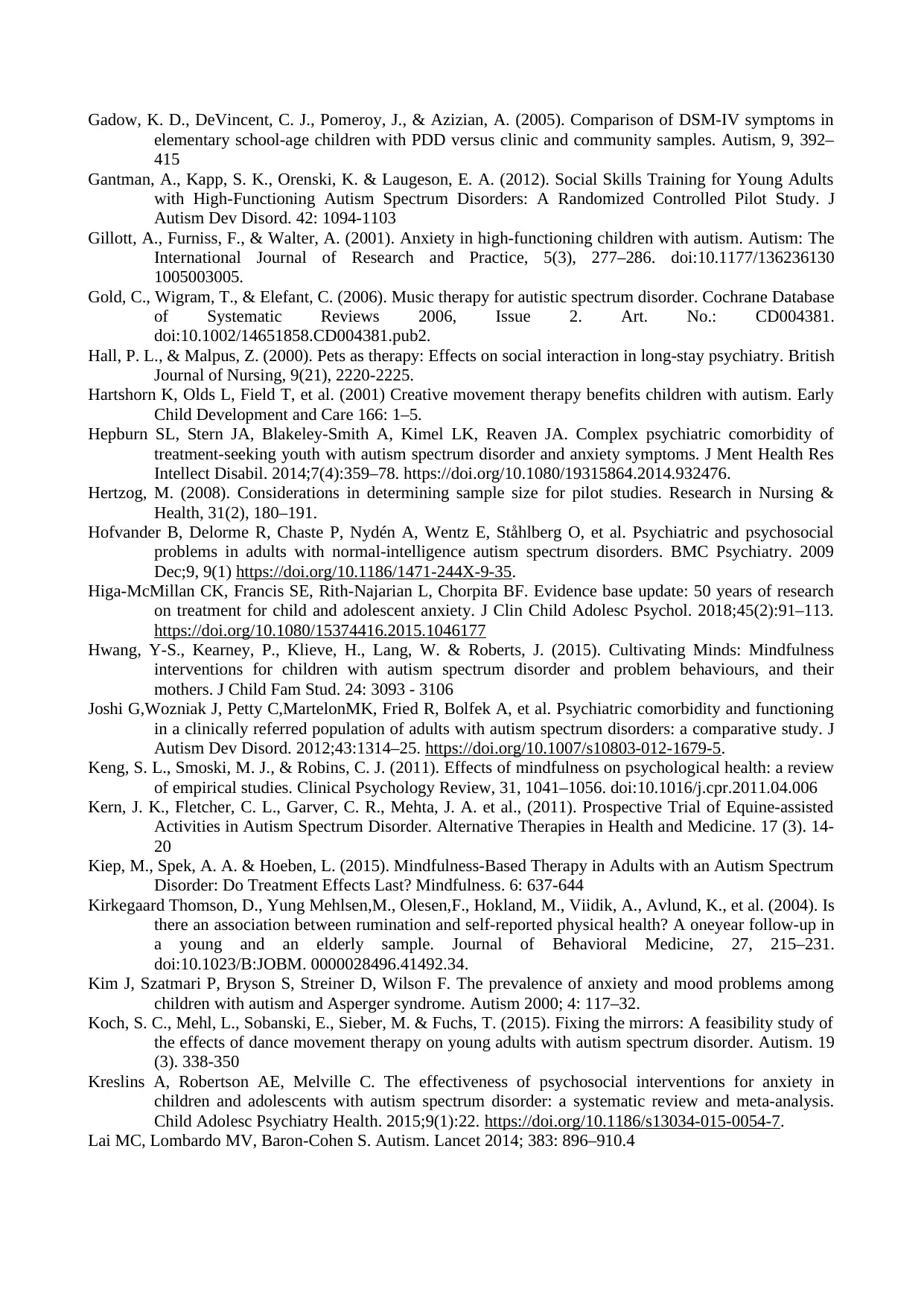
Gadow, K. D., DeVincent, C. J., Pomeroy, J., & Azizian, A. (2005). Comparison of DSM-IV symptoms in
elementary school-age children with PDD versus clinic and community samples. Autism, 9, 392–
415
Gantman, A., Kapp, S. K., Orenski, K. & Laugeson, E. A. (2012). Social Skills Training for Young Adults
with High-Functioning Autism Spectrum Disorders: A Randomized Controlled Pilot Study. J
Autism Dev Disord. 42: 1094-1103
Gillott, A., Furniss, F., & Walter, A. (2001). Anxiety in high-functioning children with autism. Autism: The
International Journal of Research and Practice, 5(3), 277–286. doi:10.1177/136236130
1005003005.
Gold, C., Wigram, T., & Elefant, C. (2006). Music therapy for autistic spectrum disorder. Cochrane Database
of Systematic Reviews 2006, Issue 2. Art. No.: CD004381.
doi:10.1002/14651858.CD004381.pub2.
Hall, P. L., & Malpus, Z. (2000). Pets as therapy: Effects on social interaction in long-stay psychiatry. British
Journal of Nursing, 9(21), 2220-2225.
Hartshorn K, Olds L, Field T, et al. (2001) Creative movement therapy benefits children with autism. Early
Child Development and Care 166: 1–5.
Hepburn SL, Stern JA, Blakeley-Smith A, Kimel LK, Reaven JA. Complex psychiatric comorbidity of
treatment-seeking youth with autism spectrum disorder and anxiety symptoms. J Ment Health Res
Intellect Disabil. 2014;7(4):359–78. https://doi.org/10.1080/19315864.2014.932476.
Hertzog, M. (2008). Considerations in determining sample size for pilot studies. Research in Nursing &
Health, 31(2), 180–191.
Hofvander B, Delorme R, Chaste P, Nydén A, Wentz E, Ståhlberg O, et al. Psychiatric and psychosocial
problems in adults with normal-intelligence autism spectrum disorders. BMC Psychiatry. 2009
Dec;9, 9(1) https://doi.org/10.1186/1471-244X-9-35.
Higa-McMillan CK, Francis SE, Rith-Najarian L, Chorpita BF. Evidence base update: 50 years of research
on treatment for child and adolescent anxiety. J Clin Child Adolesc Psychol. 2018;45(2):91–113.
https://doi.org/10.1080/15374416.2015.1046177
Hwang, Y-S., Kearney, P., Klieve, H., Lang, W. & Roberts, J. (2015). Cultivating Minds: Mindfulness
interventions for children with autism spectrum disorder and problem behaviours, and their
mothers. J Child Fam Stud. 24: 3093 - 3106
Joshi G,Wozniak J, Petty C,MartelonMK, Fried R, Bolfek A, et al. Psychiatric comorbidity and functioning
in a clinically referred population of adults with autism spectrum disorders: a comparative study. J
Autism Dev Disord. 2012;43:1314–25. https://doi.org/10.1007/s10803-012-1679-5.
Keng, S. L., Smoski, M. J., & Robins, C. J. (2011). Effects of mindfulness on psychological health: a review
of empirical studies. Clinical Psychology Review, 31, 1041–1056. doi:10.1016/j.cpr.2011.04.006
Kern, J. K., Fletcher, C. L., Garver, C. R., Mehta, J. A. et al., (2011). Prospective Trial of Equine-assisted
Activities in Autism Spectrum Disorder. Alternative Therapies in Health and Medicine. 17 (3). 14-
20
Kiep, M., Spek, A. A. & Hoeben, L. (2015). Mindfulness-Based Therapy in Adults with an Autism Spectrum
Disorder: Do Treatment Effects Last? Mindfulness. 6: 637-644
Kirkegaard Thomson, D., Yung Mehlsen,M., Olesen,F., Hokland, M., Viidik, A., Avlund, K., et al. (2004). Is
there an association between rumination and self-reported physical health? A oneyear follow-up in
a young and an elderly sample. Journal of Behavioral Medicine, 27, 215–231.
doi:10.1023/B:JOBM. 0000028496.41492.34.
Kim J, Szatmari P, Bryson S, Streiner D, Wilson F. The prevalence of anxiety and mood problems among
children with autism and Asperger syndrome. Autism 2000; 4: 117–32.
Koch, S. C., Mehl, L., Sobanski, E., Sieber, M. & Fuchs, T. (2015). Fixing the mirrors: A feasibility study of
the effects of dance movement therapy on young adults with autism spectrum disorder. Autism. 19
(3). 338-350
Kreslins A, Robertson AE, Melville C. The effectiveness of psychosocial interventions for anxiety in
children and adolescents with autism spectrum disorder: a systematic review and meta-analysis.
Child Adolesc Psychiatry Health. 2015;9(1):22. https://doi.org/10.1186/s13034-015-0054-7.
Lai MC, Lombardo MV, Baron-Cohen S. Autism. Lancet 2014; 383: 896–910.4
elementary school-age children with PDD versus clinic and community samples. Autism, 9, 392–
415
Gantman, A., Kapp, S. K., Orenski, K. & Laugeson, E. A. (2012). Social Skills Training for Young Adults
with High-Functioning Autism Spectrum Disorders: A Randomized Controlled Pilot Study. J
Autism Dev Disord. 42: 1094-1103
Gillott, A., Furniss, F., & Walter, A. (2001). Anxiety in high-functioning children with autism. Autism: The
International Journal of Research and Practice, 5(3), 277–286. doi:10.1177/136236130
1005003005.
Gold, C., Wigram, T., & Elefant, C. (2006). Music therapy for autistic spectrum disorder. Cochrane Database
of Systematic Reviews 2006, Issue 2. Art. No.: CD004381.
doi:10.1002/14651858.CD004381.pub2.
Hall, P. L., & Malpus, Z. (2000). Pets as therapy: Effects on social interaction in long-stay psychiatry. British
Journal of Nursing, 9(21), 2220-2225.
Hartshorn K, Olds L, Field T, et al. (2001) Creative movement therapy benefits children with autism. Early
Child Development and Care 166: 1–5.
Hepburn SL, Stern JA, Blakeley-Smith A, Kimel LK, Reaven JA. Complex psychiatric comorbidity of
treatment-seeking youth with autism spectrum disorder and anxiety symptoms. J Ment Health Res
Intellect Disabil. 2014;7(4):359–78. https://doi.org/10.1080/19315864.2014.932476.
Hertzog, M. (2008). Considerations in determining sample size for pilot studies. Research in Nursing &
Health, 31(2), 180–191.
Hofvander B, Delorme R, Chaste P, Nydén A, Wentz E, Ståhlberg O, et al. Psychiatric and psychosocial
problems in adults with normal-intelligence autism spectrum disorders. BMC Psychiatry. 2009
Dec;9, 9(1) https://doi.org/10.1186/1471-244X-9-35.
Higa-McMillan CK, Francis SE, Rith-Najarian L, Chorpita BF. Evidence base update: 50 years of research
on treatment for child and adolescent anxiety. J Clin Child Adolesc Psychol. 2018;45(2):91–113.
https://doi.org/10.1080/15374416.2015.1046177
Hwang, Y-S., Kearney, P., Klieve, H., Lang, W. & Roberts, J. (2015). Cultivating Minds: Mindfulness
interventions for children with autism spectrum disorder and problem behaviours, and their
mothers. J Child Fam Stud. 24: 3093 - 3106
Joshi G,Wozniak J, Petty C,MartelonMK, Fried R, Bolfek A, et al. Psychiatric comorbidity and functioning
in a clinically referred population of adults with autism spectrum disorders: a comparative study. J
Autism Dev Disord. 2012;43:1314–25. https://doi.org/10.1007/s10803-012-1679-5.
Keng, S. L., Smoski, M. J., & Robins, C. J. (2011). Effects of mindfulness on psychological health: a review
of empirical studies. Clinical Psychology Review, 31, 1041–1056. doi:10.1016/j.cpr.2011.04.006
Kern, J. K., Fletcher, C. L., Garver, C. R., Mehta, J. A. et al., (2011). Prospective Trial of Equine-assisted
Activities in Autism Spectrum Disorder. Alternative Therapies in Health and Medicine. 17 (3). 14-
20
Kiep, M., Spek, A. A. & Hoeben, L. (2015). Mindfulness-Based Therapy in Adults with an Autism Spectrum
Disorder: Do Treatment Effects Last? Mindfulness. 6: 637-644
Kirkegaard Thomson, D., Yung Mehlsen,M., Olesen,F., Hokland, M., Viidik, A., Avlund, K., et al. (2004). Is
there an association between rumination and self-reported physical health? A oneyear follow-up in
a young and an elderly sample. Journal of Behavioral Medicine, 27, 215–231.
doi:10.1023/B:JOBM. 0000028496.41492.34.
Kim J, Szatmari P, Bryson S, Streiner D, Wilson F. The prevalence of anxiety and mood problems among
children with autism and Asperger syndrome. Autism 2000; 4: 117–32.
Koch, S. C., Mehl, L., Sobanski, E., Sieber, M. & Fuchs, T. (2015). Fixing the mirrors: A feasibility study of
the effects of dance movement therapy on young adults with autism spectrum disorder. Autism. 19
(3). 338-350
Kreslins A, Robertson AE, Melville C. The effectiveness of psychosocial interventions for anxiety in
children and adolescents with autism spectrum disorder: a systematic review and meta-analysis.
Child Adolesc Psychiatry Health. 2015;9(1):22. https://doi.org/10.1186/s13034-015-0054-7.
Lai MC, Lombardo MV, Baron-Cohen S. Autism. Lancet 2014; 383: 896–910.4
Paraphrase This Document
Need a fresh take? Get an instant paraphrase of this document with our AI Paraphraser
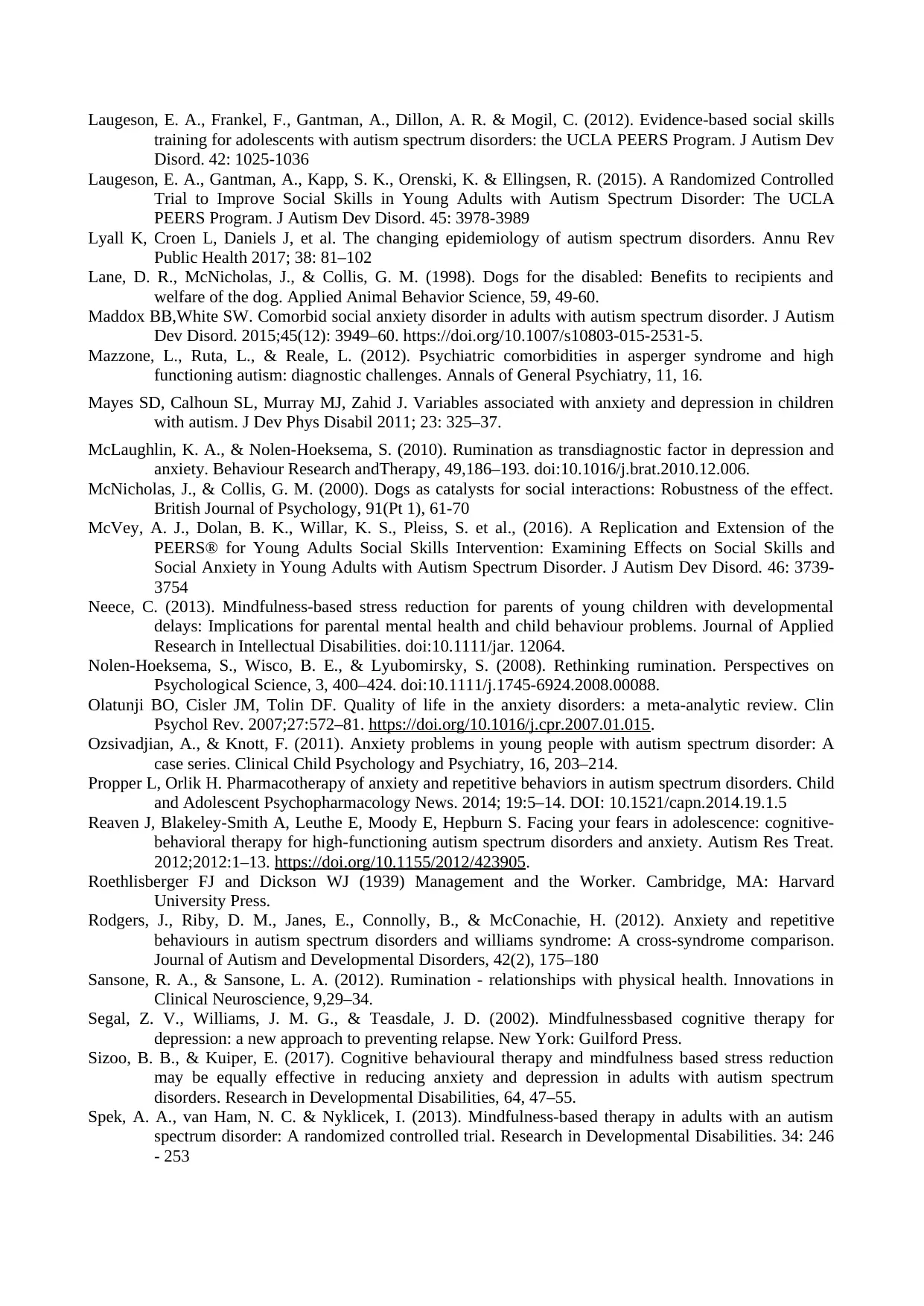
Laugeson, E. A., Frankel, F., Gantman, A., Dillon, A. R. & Mogil, C. (2012). Evidence-based social skills
training for adolescents with autism spectrum disorders: the UCLA PEERS Program. J Autism Dev
Disord. 42: 1025-1036
Laugeson, E. A., Gantman, A., Kapp, S. K., Orenski, K. & Ellingsen, R. (2015). A Randomized Controlled
Trial to Improve Social Skills in Young Adults with Autism Spectrum Disorder: The UCLA
PEERS Program. J Autism Dev Disord. 45: 3978-3989
Lyall K, Croen L, Daniels J, et al. The changing epidemiology of autism spectrum disorders. Annu Rev
Public Health 2017; 38: 81–102
Lane, D. R., McNicholas, J., & Collis, G. M. (1998). Dogs for the disabled: Benefits to recipients and
welfare of the dog. Applied Animal Behavior Science, 59, 49-60.
Maddox BB,White SW. Comorbid social anxiety disorder in adults with autism spectrum disorder. J Autism
Dev Disord. 2015;45(12): 3949–60. https://doi.org/10.1007/s10803-015-2531-5.
Mazzone, L., Ruta, L., & Reale, L. (2012). Psychiatric comorbidities in asperger syndrome and high
functioning autism: diagnostic challenges. Annals of General Psychiatry, 11, 16.
Mayes SD, Calhoun SL, Murray MJ, Zahid J. Variables associated with anxiety and depression in children
with autism. J Dev Phys Disabil 2011; 23: 325–37.
McLaughlin, K. A., & Nolen-Hoeksema, S. (2010). Rumination as transdiagnostic factor in depression and
anxiety. Behaviour Research andTherapy, 49,186–193. doi:10.1016/j.brat.2010.12.006.
McNicholas, J., & Collis, G. M. (2000). Dogs as catalysts for social interactions: Robustness of the effect.
British Journal of Psychology, 91(Pt 1), 61-70
McVey, A. J., Dolan, B. K., Willar, K. S., Pleiss, S. et al., (2016). A Replication and Extension of the
PEERS® for Young Adults Social Skills Intervention: Examining Effects on Social Skills and
Social Anxiety in Young Adults with Autism Spectrum Disorder. J Autism Dev Disord. 46: 3739-
3754
Neece, C. (2013). Mindfulness-based stress reduction for parents of young children with developmental
delays: Implications for parental mental health and child behaviour problems. Journal of Applied
Research in Intellectual Disabilities. doi:10.1111/jar. 12064.
Nolen-Hoeksema, S., Wisco, B. E., & Lyubomirsky, S. (2008). Rethinking rumination. Perspectives on
Psychological Science, 3, 400–424. doi:10.1111/j.1745-6924.2008.00088.
Olatunji BO, Cisler JM, Tolin DF. Quality of life in the anxiety disorders: a meta-analytic review. Clin
Psychol Rev. 2007;27:572–81. https://doi.org/10.1016/j.cpr.2007.01.015.
Ozsivadjian, A., & Knott, F. (2011). Anxiety problems in young people with autism spectrum disorder: A
case series. Clinical Child Psychology and Psychiatry, 16, 203–214.
Propper L, Orlik H. Pharmacotherapy of anxiety and repetitive behaviors in autism spectrum disorders. Child
and Adolescent Psychopharmacology News. 2014; 19:5–14. DOI: 10.1521/capn.2014.19.1.5
Reaven J, Blakeley-Smith A, Leuthe E, Moody E, Hepburn S. Facing your fears in adolescence: cognitive-
behavioral therapy for high-functioning autism spectrum disorders and anxiety. Autism Res Treat.
2012;2012:1–13. https://doi.org/10.1155/2012/423905.
Roethlisberger FJ and Dickson WJ (1939) Management and the Worker. Cambridge, MA: Harvard
University Press.
Rodgers, J., Riby, D. M., Janes, E., Connolly, B., & McConachie, H. (2012). Anxiety and repetitive
behaviours in autism spectrum disorders and williams syndrome: A cross-syndrome comparison.
Journal of Autism and Developmental Disorders, 42(2), 175–180
Sansone, R. A., & Sansone, L. A. (2012). Rumination - relationships with physical health. Innovations in
Clinical Neuroscience, 9,29–34.
Segal, Z. V., Williams, J. M. G., & Teasdale, J. D. (2002). Mindfulnessbased cognitive therapy for
depression: a new approach to preventing relapse. New York: Guilford Press.
Sizoo, B. B., & Kuiper, E. (2017). Cognitive behavioural therapy and mindfulness based stress reduction
may be equally effective in reducing anxiety and depression in adults with autism spectrum
disorders. Research in Developmental Disabilities, 64, 47–55.
Spek, A. A., van Ham, N. C. & Nyklicek, I. (2013). Mindfulness-based therapy in adults with an autism
spectrum disorder: A randomized controlled trial. Research in Developmental Disabilities. 34: 246
- 253
training for adolescents with autism spectrum disorders: the UCLA PEERS Program. J Autism Dev
Disord. 42: 1025-1036
Laugeson, E. A., Gantman, A., Kapp, S. K., Orenski, K. & Ellingsen, R. (2015). A Randomized Controlled
Trial to Improve Social Skills in Young Adults with Autism Spectrum Disorder: The UCLA
PEERS Program. J Autism Dev Disord. 45: 3978-3989
Lyall K, Croen L, Daniels J, et al. The changing epidemiology of autism spectrum disorders. Annu Rev
Public Health 2017; 38: 81–102
Lane, D. R., McNicholas, J., & Collis, G. M. (1998). Dogs for the disabled: Benefits to recipients and
welfare of the dog. Applied Animal Behavior Science, 59, 49-60.
Maddox BB,White SW. Comorbid social anxiety disorder in adults with autism spectrum disorder. J Autism
Dev Disord. 2015;45(12): 3949–60. https://doi.org/10.1007/s10803-015-2531-5.
Mazzone, L., Ruta, L., & Reale, L. (2012). Psychiatric comorbidities in asperger syndrome and high
functioning autism: diagnostic challenges. Annals of General Psychiatry, 11, 16.
Mayes SD, Calhoun SL, Murray MJ, Zahid J. Variables associated with anxiety and depression in children
with autism. J Dev Phys Disabil 2011; 23: 325–37.
McLaughlin, K. A., & Nolen-Hoeksema, S. (2010). Rumination as transdiagnostic factor in depression and
anxiety. Behaviour Research andTherapy, 49,186–193. doi:10.1016/j.brat.2010.12.006.
McNicholas, J., & Collis, G. M. (2000). Dogs as catalysts for social interactions: Robustness of the effect.
British Journal of Psychology, 91(Pt 1), 61-70
McVey, A. J., Dolan, B. K., Willar, K. S., Pleiss, S. et al., (2016). A Replication and Extension of the
PEERS® for Young Adults Social Skills Intervention: Examining Effects on Social Skills and
Social Anxiety in Young Adults with Autism Spectrum Disorder. J Autism Dev Disord. 46: 3739-
3754
Neece, C. (2013). Mindfulness-based stress reduction for parents of young children with developmental
delays: Implications for parental mental health and child behaviour problems. Journal of Applied
Research in Intellectual Disabilities. doi:10.1111/jar. 12064.
Nolen-Hoeksema, S., Wisco, B. E., & Lyubomirsky, S. (2008). Rethinking rumination. Perspectives on
Psychological Science, 3, 400–424. doi:10.1111/j.1745-6924.2008.00088.
Olatunji BO, Cisler JM, Tolin DF. Quality of life in the anxiety disorders: a meta-analytic review. Clin
Psychol Rev. 2007;27:572–81. https://doi.org/10.1016/j.cpr.2007.01.015.
Ozsivadjian, A., & Knott, F. (2011). Anxiety problems in young people with autism spectrum disorder: A
case series. Clinical Child Psychology and Psychiatry, 16, 203–214.
Propper L, Orlik H. Pharmacotherapy of anxiety and repetitive behaviors in autism spectrum disorders. Child
and Adolescent Psychopharmacology News. 2014; 19:5–14. DOI: 10.1521/capn.2014.19.1.5
Reaven J, Blakeley-Smith A, Leuthe E, Moody E, Hepburn S. Facing your fears in adolescence: cognitive-
behavioral therapy for high-functioning autism spectrum disorders and anxiety. Autism Res Treat.
2012;2012:1–13. https://doi.org/10.1155/2012/423905.
Roethlisberger FJ and Dickson WJ (1939) Management and the Worker. Cambridge, MA: Harvard
University Press.
Rodgers, J., Riby, D. M., Janes, E., Connolly, B., & McConachie, H. (2012). Anxiety and repetitive
behaviours in autism spectrum disorders and williams syndrome: A cross-syndrome comparison.
Journal of Autism and Developmental Disorders, 42(2), 175–180
Sansone, R. A., & Sansone, L. A. (2012). Rumination - relationships with physical health. Innovations in
Clinical Neuroscience, 9,29–34.
Segal, Z. V., Williams, J. M. G., & Teasdale, J. D. (2002). Mindfulnessbased cognitive therapy for
depression: a new approach to preventing relapse. New York: Guilford Press.
Sizoo, B. B., & Kuiper, E. (2017). Cognitive behavioural therapy and mindfulness based stress reduction
may be equally effective in reducing anxiety and depression in adults with autism spectrum
disorders. Research in Developmental Disabilities, 64, 47–55.
Spek, A. A., van Ham, N. C. & Nyklicek, I. (2013). Mindfulness-based therapy in adults with an autism
spectrum disorder: A randomized controlled trial. Research in Developmental Disabilities. 34: 246
- 253
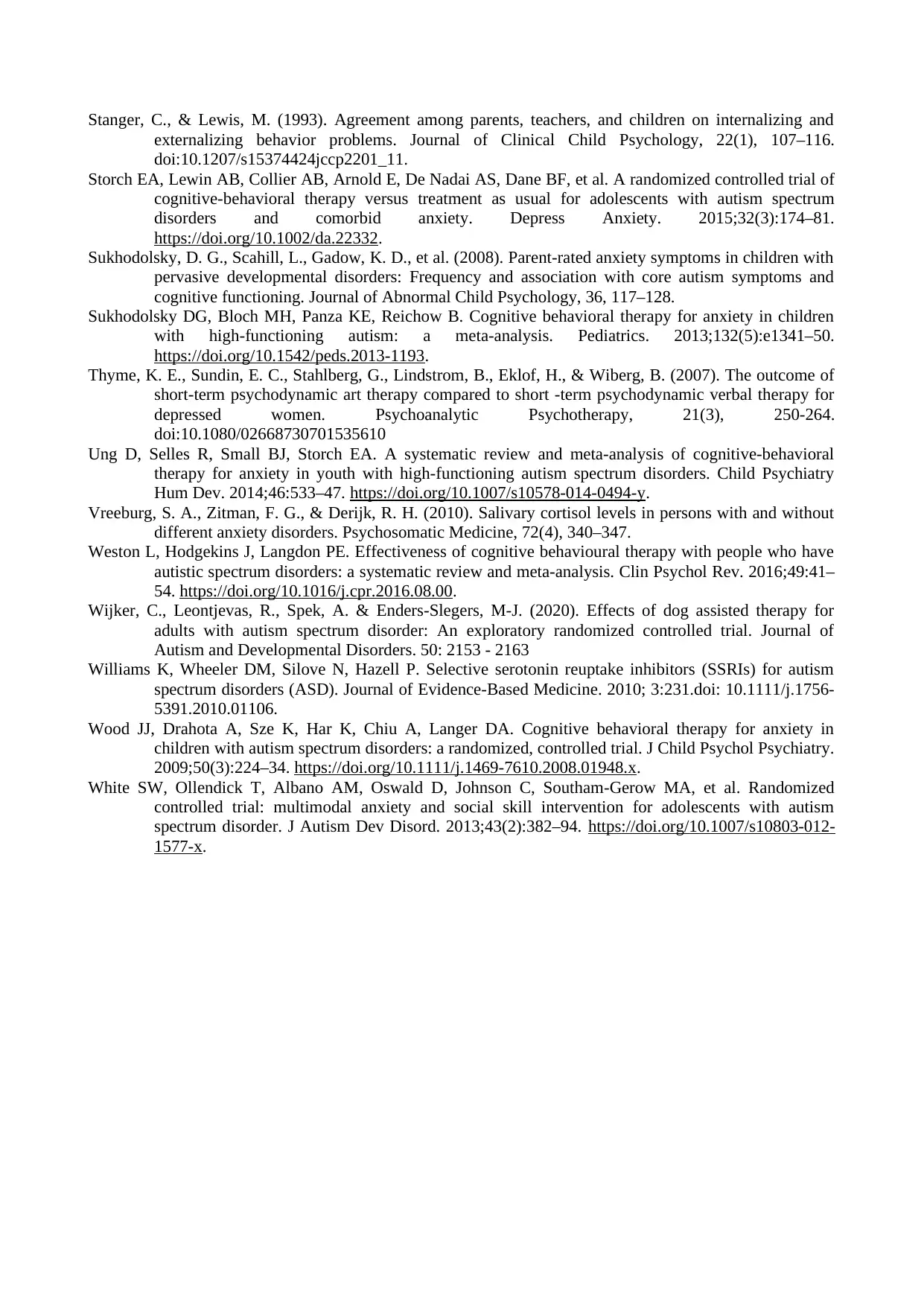
Stanger, C., & Lewis, M. (1993). Agreement among parents, teachers, and children on internalizing and
externalizing behavior problems. Journal of Clinical Child Psychology, 22(1), 107–116.
doi:10.1207/s15374424jccp2201_11.
Storch EA, Lewin AB, Collier AB, Arnold E, De Nadai AS, Dane BF, et al. A randomized controlled trial of
cognitive-behavioral therapy versus treatment as usual for adolescents with autism spectrum
disorders and comorbid anxiety. Depress Anxiety. 2015;32(3):174–81.
https://doi.org/10.1002/da.22332.
Sukhodolsky, D. G., Scahill, L., Gadow, K. D., et al. (2008). Parent-rated anxiety symptoms in children with
pervasive developmental disorders: Frequency and association with core autism symptoms and
cognitive functioning. Journal of Abnormal Child Psychology, 36, 117–128.
Sukhodolsky DG, Bloch MH, Panza KE, Reichow B. Cognitive behavioral therapy for anxiety in children
with high-functioning autism: a meta-analysis. Pediatrics. 2013;132(5):e1341–50.
https://doi.org/10.1542/peds.2013-1193.
Thyme, K. E., Sundin, E. C., Stahlberg, G., Lindstrom, B., Eklof, H., & Wiberg, B. (2007). The outcome of
short-term psychodynamic art therapy compared to short -term psychodynamic verbal therapy for
depressed women. Psychoanalytic Psychotherapy, 21(3), 250-264.
doi:10.1080/02668730701535610
Ung D, Selles R, Small BJ, Storch EA. A systematic review and meta-analysis of cognitive-behavioral
therapy for anxiety in youth with high-functioning autism spectrum disorders. Child Psychiatry
Hum Dev. 2014;46:533–47. https://doi.org/10.1007/s10578-014-0494-y.
Vreeburg, S. A., Zitman, F. G., & Derijk, R. H. (2010). Salivary cortisol levels in persons with and without
different anxiety disorders. Psychosomatic Medicine, 72(4), 340–347.
Weston L, Hodgekins J, Langdon PE. Effectiveness of cognitive behavioural therapy with people who have
autistic spectrum disorders: a systematic review and meta-analysis. Clin Psychol Rev. 2016;49:41–
54. https://doi.org/10.1016/j.cpr.2016.08.00.
Wijker, C., Leontjevas, R., Spek, A. & Enders-Slegers, M-J. (2020). Effects of dog assisted therapy for
adults with autism spectrum disorder: An exploratory randomized controlled trial. Journal of
Autism and Developmental Disorders. 50: 2153 - 2163
Williams K, Wheeler DM, Silove N, Hazell P. Selective serotonin reuptake inhibitors (SSRIs) for autism
spectrum disorders (ASD). Journal of Evidence-Based Medicine. 2010; 3:231.doi: 10.1111/j.1756-
5391.2010.01106.
Wood JJ, Drahota A, Sze K, Har K, Chiu A, Langer DA. Cognitive behavioral therapy for anxiety in
children with autism spectrum disorders: a randomized, controlled trial. J Child Psychol Psychiatry.
2009;50(3):224–34. https://doi.org/10.1111/j.1469-7610.2008.01948.x.
White SW, Ollendick T, Albano AM, Oswald D, Johnson C, Southam-Gerow MA, et al. Randomized
controlled trial: multimodal anxiety and social skill intervention for adolescents with autism
spectrum disorder. J Autism Dev Disord. 2013;43(2):382–94. https://doi.org/10.1007/s10803-012-
1577-x.
externalizing behavior problems. Journal of Clinical Child Psychology, 22(1), 107–116.
doi:10.1207/s15374424jccp2201_11.
Storch EA, Lewin AB, Collier AB, Arnold E, De Nadai AS, Dane BF, et al. A randomized controlled trial of
cognitive-behavioral therapy versus treatment as usual for adolescents with autism spectrum
disorders and comorbid anxiety. Depress Anxiety. 2015;32(3):174–81.
https://doi.org/10.1002/da.22332.
Sukhodolsky, D. G., Scahill, L., Gadow, K. D., et al. (2008). Parent-rated anxiety symptoms in children with
pervasive developmental disorders: Frequency and association with core autism symptoms and
cognitive functioning. Journal of Abnormal Child Psychology, 36, 117–128.
Sukhodolsky DG, Bloch MH, Panza KE, Reichow B. Cognitive behavioral therapy for anxiety in children
with high-functioning autism: a meta-analysis. Pediatrics. 2013;132(5):e1341–50.
https://doi.org/10.1542/peds.2013-1193.
Thyme, K. E., Sundin, E. C., Stahlberg, G., Lindstrom, B., Eklof, H., & Wiberg, B. (2007). The outcome of
short-term psychodynamic art therapy compared to short -term psychodynamic verbal therapy for
depressed women. Psychoanalytic Psychotherapy, 21(3), 250-264.
doi:10.1080/02668730701535610
Ung D, Selles R, Small BJ, Storch EA. A systematic review and meta-analysis of cognitive-behavioral
therapy for anxiety in youth with high-functioning autism spectrum disorders. Child Psychiatry
Hum Dev. 2014;46:533–47. https://doi.org/10.1007/s10578-014-0494-y.
Vreeburg, S. A., Zitman, F. G., & Derijk, R. H. (2010). Salivary cortisol levels in persons with and without
different anxiety disorders. Psychosomatic Medicine, 72(4), 340–347.
Weston L, Hodgekins J, Langdon PE. Effectiveness of cognitive behavioural therapy with people who have
autistic spectrum disorders: a systematic review and meta-analysis. Clin Psychol Rev. 2016;49:41–
54. https://doi.org/10.1016/j.cpr.2016.08.00.
Wijker, C., Leontjevas, R., Spek, A. & Enders-Slegers, M-J. (2020). Effects of dog assisted therapy for
adults with autism spectrum disorder: An exploratory randomized controlled trial. Journal of
Autism and Developmental Disorders. 50: 2153 - 2163
Williams K, Wheeler DM, Silove N, Hazell P. Selective serotonin reuptake inhibitors (SSRIs) for autism
spectrum disorders (ASD). Journal of Evidence-Based Medicine. 2010; 3:231.doi: 10.1111/j.1756-
5391.2010.01106.
Wood JJ, Drahota A, Sze K, Har K, Chiu A, Langer DA. Cognitive behavioral therapy for anxiety in
children with autism spectrum disorders: a randomized, controlled trial. J Child Psychol Psychiatry.
2009;50(3):224–34. https://doi.org/10.1111/j.1469-7610.2008.01948.x.
White SW, Ollendick T, Albano AM, Oswald D, Johnson C, Southam-Gerow MA, et al. Randomized
controlled trial: multimodal anxiety and social skill intervention for adolescents with autism
spectrum disorder. J Autism Dev Disord. 2013;43(2):382–94. https://doi.org/10.1007/s10803-012-
1577-x.
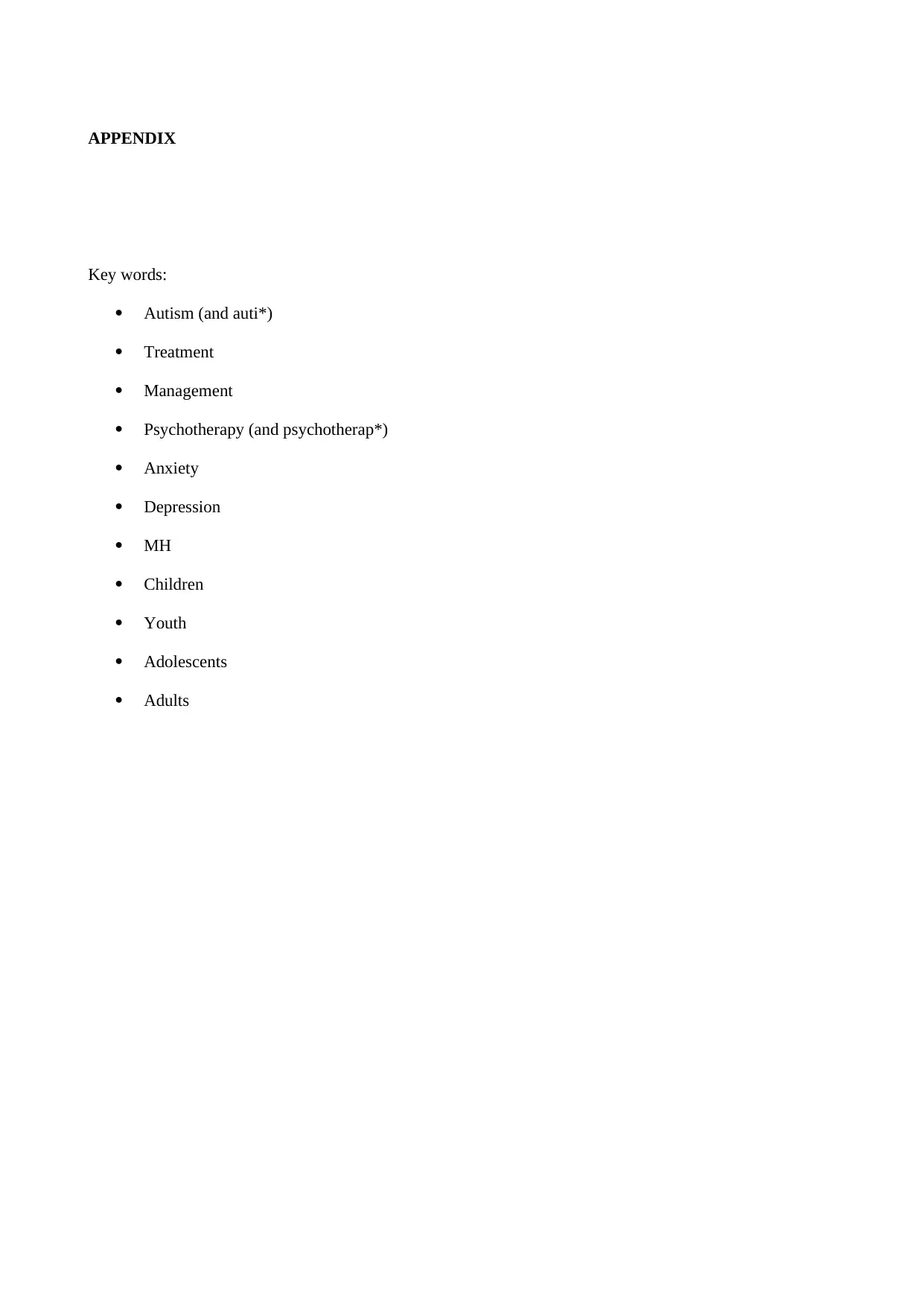
APPENDIX
Key words:
Autism (and auti*)
Treatment
Management
Psychotherapy (and psychotherap*)
Anxiety
Depression
MH
Children
Youth
Adolescents
Adults
Key words:
Autism (and auti*)
Treatment
Management
Psychotherapy (and psychotherap*)
Anxiety
Depression
MH
Children
Youth
Adolescents
Adults
1 out of 34
Related Documents
Your All-in-One AI-Powered Toolkit for Academic Success.
+13062052269
info@desklib.com
Available 24*7 on WhatsApp / Email
![[object Object]](/_next/static/media/star-bottom.7253800d.svg)
Unlock your academic potential
© 2024 | Zucol Services PVT LTD | All rights reserved.




